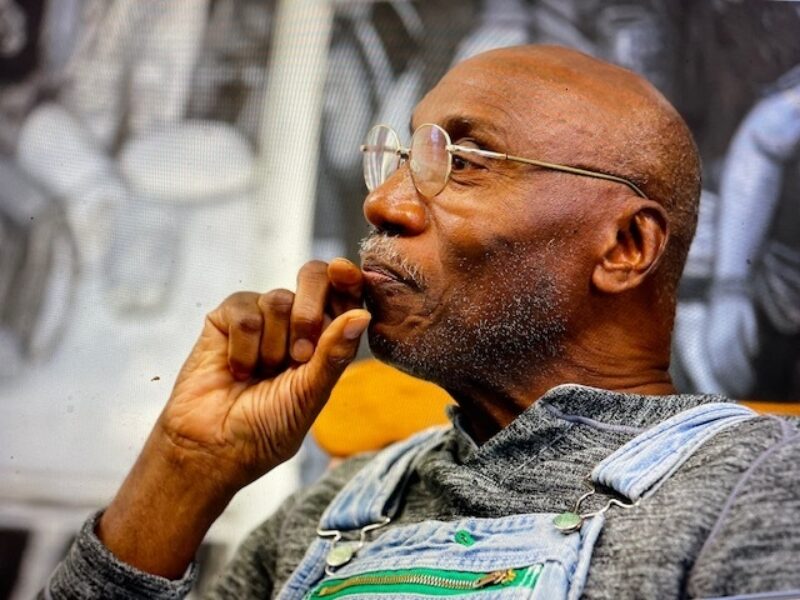
Willie Birch in his studio, New Orleans, LA, 2023. Photo by Keith Calhoun.
Willie Birch is a visual artist whose mediums include drawing, painting, and sculpture. With a career that spans over four decades, Birch has earned his place in the art world, creating works that depict New Orleans and its quotidian inhabitants, those often-overlooked members of his community. In the Oral History Project’s lengthiest and most vivacious interview to date, Birch first spoke with his friends and peers, Ron Bechet, Keith Calhoun, and Chandra McCormick. They discussed the ways they take up space, on purpose, in a Eurocentric art world by showing the truth and history of their shared homeplace, New Orleans, and what it means to be a Black artist. This conversation was moderated by New Orleans-based feminist-activist Shana M. griffin who conducted the subsequent interview. The project provided Mr. Birch with an opportunity to say everything he has to say about his career, his investments in the work and lives of the generations that will succeed him, and the wisdom he wants to leave to us. As Mr. Birch says in this rich interview, “Let’s not miss anything…”
—Janée Moses, OHP Director
Around the Table in Willie Birch’s Studio: February 11, 2023.
Shana M. griffinIt took us two years to get to this interview.
Willie BirchTwo years.
SgI want to acknowledge that what we’re doing is an everyday conversation; it’s ordinary. I wonder if folks outside of our conversation perceive how ordinary experiences can become extraordinary. As we engage and interact in a post-Katrina world, it’s rare to have a group of artists who are all from this place, who also make work that’s international in scope and yet still local, come together. It sounds cheesy but this is a historical moment, conversing with artists from and of this place whose work continues to engage this city in its multiple layers.
I want you to introduce us. Does that sound cool?
WBFirst, I’d like to thank BOMB for hosting this. The people who are here with me today are the artist Ron Bechet, who I really met in the ’90s before I moved back here, and photographers Chandra McCormick and Keith Calhoun. I’m going to interrupt the introductions to offer background about myself.
I was born on November 26, 1942. It was Thanksgiving night, in the back of my aunt’s restaurant, 2133 Tchoupitoulas here in New Orleans—which is adjacent to the railroad tracks—during a family party that I broke up by coming into the world. (laughter) I’ve always been the family’s baby, and I carry that with purpose.
I met Chandra McCormick on a panel in Virginia. We were both invited. She was invited from New Orleans to talk about the changing culture, or the culture as it existed, from her perspective. I was brought there to talk about the culture pre-1969. I left New Orleans in 1969 because there just wasn’t anything happening for me as an artist so I moved. I took a job in Baltimore, Maryland at Kresge department store. Eventually, within six or seven months, I became an assistant manager and stayed for seven years while I went to graduate school at the Maryland Institute College of Art. Given this context, the New Orleans that Chandra talked about during the panel, I understood at the root but it was very different than what I remembered. The funeral processions had changed. The processions we call the second line. People were more aggressive as far as the way they held their body. The music was in the process of changing because we had hip-hop being introduced to our culture. So, there was a lot different and I did not understand, but it sounded very exciting.
When I moved back to New Orleans in 1994 from New York, Chandra introduced me to Keith Calhoun. And after seeing his photography and understanding what Chandra already could do, we bonded because we found agreement in one another. After I came back here, it was about me making my art. And here were two young photographers who were doing exciting stuff. In essence, we were creating and documenting our community without any compromise. It was not about the money; it was about doing what we had to do and supporting ourselves in that. During that time, I met Ron Bechet after his mother came to me and said, My son really likes you, Willie Birch; you should talk to him. Come to find out, Ron and I had more in common than we could imagine.
I was on a path to do something different than what you usually see in New Orleans where everybody used color. I’m supposed to be a colorist, but I was trying to reinvent something that had never been done. I wanted to play with black and white. So, one day I’m in Ron’s studio and he pulls out his black-and-white drawings. And I say, Wow. I got it. I said, How can we take this idea and turn it into the face of New Orleans whereby outsiders are forced to see this environment different? Because they were not used to seeing black-and-white in New Orleans, first we decided to make them large. Next, we wondered, Who’s the public we’re going for? We knew we wanted to put the works in museums. We were not interested in people buying the work and putting them in their houses because that means the people that we come out of may not have access to see them. So, the whole idea was a political endeavor.
We did get resistance from that. Because everybody in New York knew me because of my papier mâché and certain people were still clinging to the artistry they associated with me . . . I started working with papier mâché in 1984 after I visited New Orleans during the Louisiana World Exposition and saw a fifteenth-century papier mâché at the cathedral. I took that image back to New York with me. Next thing you know, in the ’90’s, I get the big prize. In 1992, I was featured in the New York Times with a review by Roberta Smith of my show at Exit Art.
Shifting and reinventing is part of who I am. I don’t believe in staying on one path because I’m inspired by New Orleans music; it’s constantly changing, and it’s reflected by time. I’m still on a mission. But I don’t want to talk too much more because we have Ron, Chandra, and Keith here. To tell you the truth, we’ve been talking and working together since I moved back here in ’94.
We have tapes of us documenting the culture of New Orleans. We were able to take this project to Dooky Chase in the ’90s, as well as a nine-month series on New Orleans culture and how the people of New Orleans, especially Black people, relate to the creating of that culture. A lot of those tapes were lost, but I’m sure somebody has them somewhere. They were lost during Katrina. I acted as producer for the resulting films, Chasing Dreams: A Leah Chase Story, and more recently Hope to Told Ya – The Old Prieur Project.
I’m saying all this because we are on a mission, and this moment is incredible because now we want the world to understand why New Orleans is so important, not just musically, but also visually. Visual culture allows people to see themselves and define who they are. More than just being a backdrop, New Orleans’ visual culture is the driving force behind why and who we are.
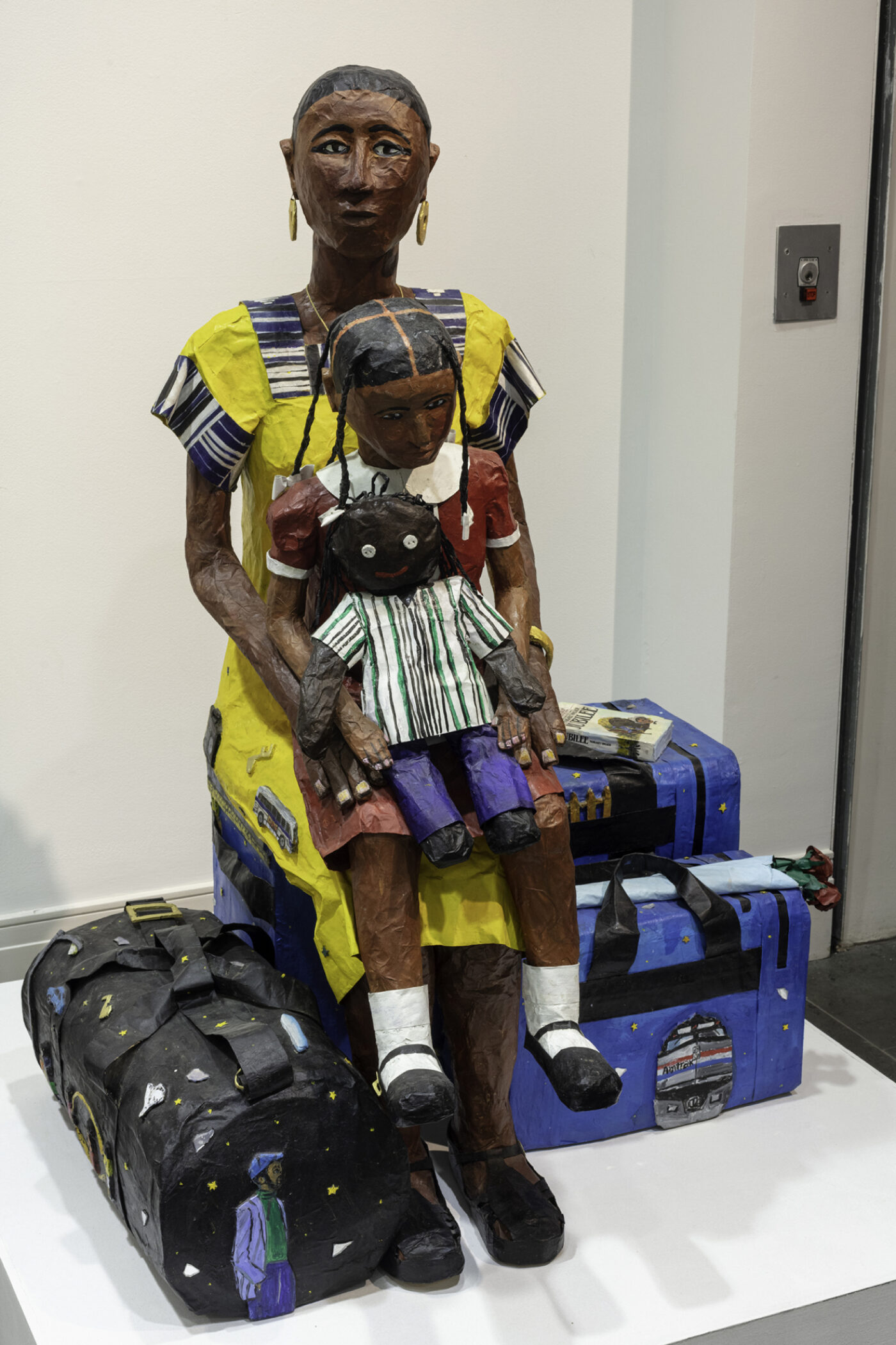
Willie Birch, Going Home, 1992, painted papier mâché and mixed media, 55 × 39 × 37 inches. Courtesy of the artist.
Ron BechetWhat really resonated for me was the conversation that we had when you returned to New Orleans about black-and-white images and just how colorful this city is. We both thought then and now that black-and-white is far more colorful than using color. When you see these drawings that Mr. Birch does, they’re not really drawings—they are literally performance. I could see him dancing and working in front of these pieces because the process of making these works is performative. The idea of color having to be the full spectrum is not necessarily what we’re talking about. You know that in using the charcoal and the materials that Mr. Birch uses, they become far more colorful than anything. For example, the minor resistance to light that we see with the charcoal, the variegation of the charcoal—the grays, the browns—has become important. And that incident is something that I could relate to, that we both talk about a lot. Sometimes you would get a piece of charcoal that’s a bit of a stray and makes a brown mark—
WB—but it’s blue. (laughter)
RBExactly. And sometimes that’s the beauty of it. Relating that to where we come from becomes extremely significant. Sometimes, in our everyday lives, you have an opportunity where you think it is brown but it’s blue. Or you meet people on the street in a particular moment that colors your experience. I think it’s important to respect the opportunity and learn something different. That’s what I think I’ve come to understand with Mr. Birch.
WBAnd we played the clarinet.
RBRight, we both played clarinet. (laughter)
WBAnd who’s Ron’s great uncle? The great jazz soloist Sidney Bechet. That is all part of our practice. All those different layers are why we came together then and continue to come together.
RBWe both gave up that black wooden instrument to use charcoal. (laughter)
Chandra McCormickI didn’t know Willie before we were on that panel in Virginia.
SgYou recall what year that was?
WBLate eighties, early nineties.
CMIt was 1989, and I didn’t know him. But Marilyn Nance was really bragging. She was like, “You’ve got to know Willie Birch. You must know him. He’s from New Orleans.” When we met on the panel, I actually learned a lot about New Orleans that I didn’t know, especially colloquial terms. During the panel, I spoke about how we use the Interstate. When I said, “I-10,” Willie said, “What did you say? That’s highway nine years.” (laughter) The event was focused on New Orleans’ St. Joseph’s Day so we talked a lot about how we celebrate here. Marilyn’s talk was about how she lost her shoe during her experience here.
Sg Who is Marilyn? I’m sorry.
CM(In unison with Willie Birch, Ron Bechet, and Keith Calhoun) Marilyn Nance!
WBShe is an incredible artist and photographer in New York. Marilyn and I could relate in terms of the African-ness of what we were experiencing in New York. I could have conversations about New Orleans with Marilyn and her husband, a Black Puerto Rican brother. These are the people I gravitated to.
CMAl Santana.
WBYes, Santana. I gravitated to those people because they were more like New Orleans than a lot of the other artists were. So, at some point I was more interested in the Dominicans and the Puerto Ricans and the Haitians and Cubanos.
SgSo, Marilyn brought y’all together?
CMYeah, she brought Willie and I together and we did that panel and that was good. It was educational for me. We bonded, just like Willie said. We talked a lot about his work in black-and-white, I think it’s so beautiful and I can see it because I shoot a lot of black-and-white photography. Usually, you see artists of color using a lot of colors. Black-and-white to me is more dramatic because you’ve got all those tones: Grays, whites, blacks. And when we first started shooting, I didn’t shoot color at all; black-and-white was more striking to me. What brought me into color were publications and people asking me, Oh, you don’t have color? So, we just started shooting more color. After all, this is a colorful city. It is beautiful when shown that way, but there are black-and-white visuals that can produce the same effect.

Willie Birch, Spring, 2021, charcoal and acrylic on paper, 72 × 90 inches. Courtesy of the artist.
WBAaron Neville and I were in 10th grade together. I’ve got all this history in terms of people from my community. And I grew up across the street from the Dew Drop Inn [a Black jazz and supper club] in the Magnolia Projects. Given that, there isn’t too much somebody can tell me about my place, you know? I can tell you stories about seeing Sam Cooke and all these great entertainers and going to school with the Inn’s founder, Mr. Pania’s nephew, who’s also named Frank Pania. That was my environment. Seeing all these great people that came through New Orleans to eat at Hayes Chicken Shack and spend time along Louisiana Avenue. I studied History and Philosophy in college at Southern University at New Orleans (SUNO) because I really wanted to know and invest in this place. That kept me alive when I went to Europe after art school and then I went to New York and then finally, in 1994, I came back here to New Orleans. This was the place, like no other place, where I’d been able to do what I wanted to do and be embraced because folks here understood the language I was using and how that represented them.
Keith CalhounHe couldn’t help but stay. (laughter)
SgHow would you describe Mr. Birch, Keith?
KCI call him Professor.
SgAll right. Professor. I like it. How would you describe the Professor?
KCWillie was an artist who came here to see the beauty of a city that has been called ugly. We would walk through the streets of New Orleans—what we called backatown—and the housing was not like now after gentrification. Before gentrification, we had texture. So, it wasn’t nothing to walk down the street and see an old lady peeping out the screen door. By the time Willie came back, he moved right into the neighborhood in South New Orleans where everything was. People always came from other places to document us. Even now, when I go on the back road, I find people from Germany photographing an old church. But Willie’s thing was to make sure that we stood rooted in our community. Because everybody wants to move. Now, when we go to these same streets where old ladies used to be peering in the screens, all that’s painted up. So, we were able to chronicle a Black New Orleans that’s pretty much done and vanished. Don’t you agree?
WBYeah, I agree.
KCRon, Chandra, and Willie have been a strong inspiration. To come here and see what was thought of as the hood… But now, some of these houses, you can’t even think about buying them. We were able to stay rooted here, even though museums were not buying collections from us. Some of the best artists in this city are overlooked. We all just kept doing our work. See, I’ve made photographers come from all over the world. When they get here, they don’t want to leave because of the subject matter here.
WBI’d gotten recognition in New York. The Metropolitan Museum owns six of my pieces, five from my folklore series and a papier mâché sculpture. I wrote grant applications for a Guggenheim grant three times and the last time I wrote, I specifically applied to come to New Orleans. In ’89, I got a $10,000 grant from New York State Council to come and do research on slavery. I came to New Orleans and worked with its public libraries. So, I went back to New York with New Orleans on my mind. And then, Robert Farris Thompson’s book, African Art in Motion… I’ve talked to a lot of young people, and they ask, Have you read that book? I always laugh. Of course, I have. There’s that section about New Orleans that makes the connection between Brazil, Cuba, and New Orleans. We are the same people.
My personal history, and my love for history in general, pushed me to realize that New Orleans is a unique place. It may be poor, but it’s also rich, and as a visual artist, I can tap directly into that in terms of coming up with something that is unique to see. The music has already been established. What people created here was just so unique to the rest of the world, but it wasn’t embraced through a visual point of view. It was embraced through an oral or musical point of view.
The great artists Romare Bearden, Elizabeth Catlett, Charles W. White, Jacob Lawrence—they all came to New Orleans. Charles White didn’t get the prize at NOMA [New Orleans Museum of Art] when they found out he was African American. He and Miss Elizabeth Catlett were married then [1940s] and living here. Miss Catlett is the one who integrated NOMA in her own unique way, which allowed me at eleven years old to be selected to go to that museum.
RBI often tease Willie and call him the mirror because he will give you back what you reflect. He will tell you about yourself. It’s a beautiful skill. It’s important to the way that he works and the way that he creates with his community, the Seventh Ward. Willie understands that there are multi-levels, multiple ways of seeing things. And he’s willing to have you see all of those layers if you’re willing to see them.
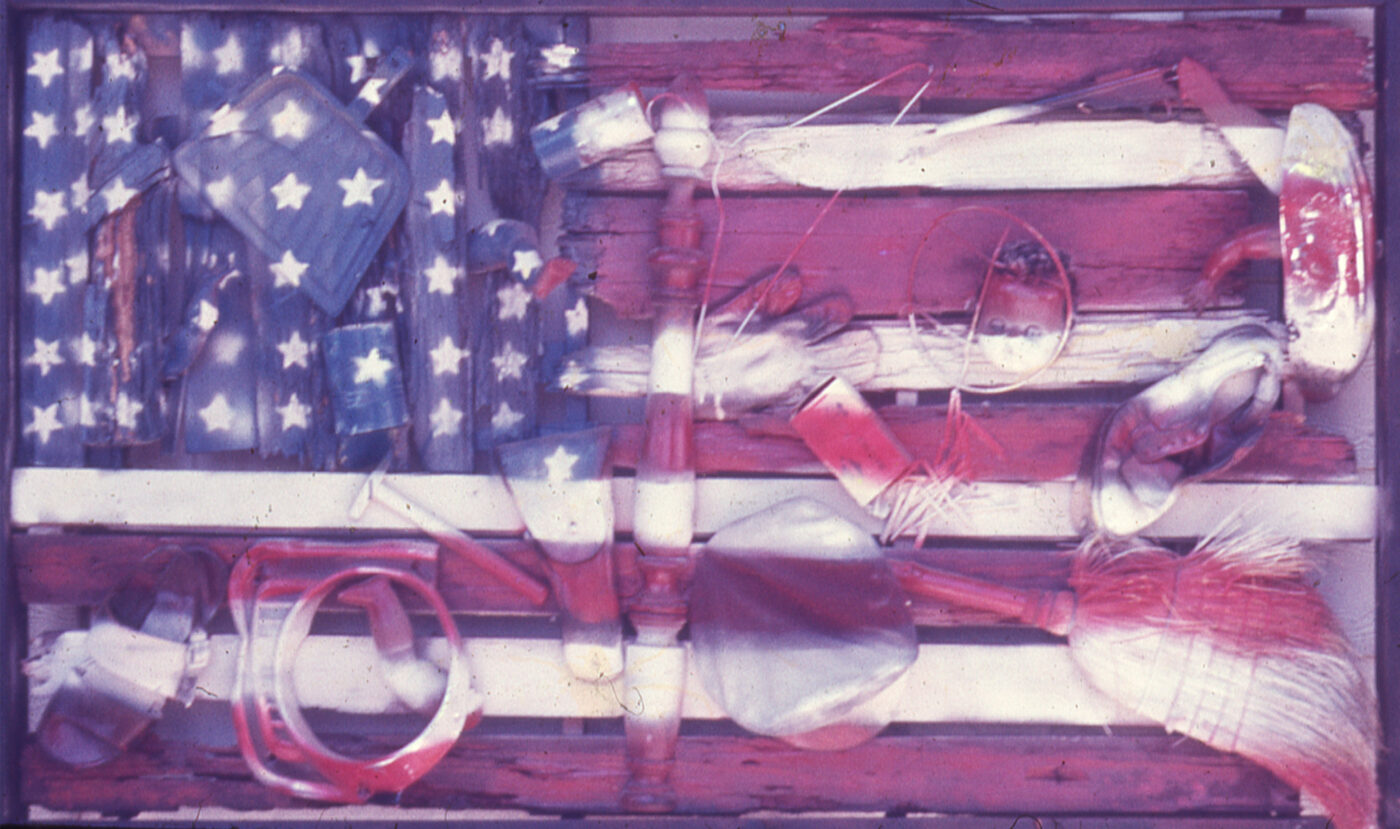
Willie Birch, Two Faces of a Nation, 1968-69, wood, paint, and found materials, 4 × 3 feet. Courtesy of the artist.
SgIf you’re willing to look in a mirror. Mirroring is a way of remembering and seeing. Ron, you mentioned Mr. Birch would tell you about yourself. I thought about Zora Neale Hurston just now. She claimed people in the South engaged in what she called factifying. Hurston would tell you about yourself and every generation you’ve come from.
It’s like memory. You can decide whether you want to see it or not, or hear it or not. (laughter)
WBMost people in the United States don’t seem to be able to go back five and six generations into their memories, their past, but I can. My maternal grandfather Daniel “Big Dan” Poindexter was from the Thibodeaux area, Lafourche Parish, and my maternal grandmother, Kitty Poindexter, was from Bertrandville, that’s south of New Orleans on the mouth of the Mississippi. A couple years ago, my kids did a DNA test on me. Sixty four percent of my DNA is from Mali, Ghana, Cameroon, Nigeria, Congo, and Senegal. I did the Lila Wallace Reader’s Digest International Artist Fellowship in Nairobi, Kenya and met an African anthropologist who explained to me that the way the slave trade went, they would march people from Sudan and then over to Senegal. It’s common to think the slave trade only included West Africans, but many were from East Africa. The anthropologist talked about the devastation caused by the slave trade.
SgThe trans-Saharan slave trade.
RBIt’s so much to consider too when you think about where people have come from and how we retain that history.
SgSometimes, we’re doing things because it’s innate. We’re not always connected to the source, but when we see it, we can feel its merit. It makes me think about our different masking traditions and where that originated.
CMRemember when you spoke about the Luba people in the Congo and how it relates to our beadwork?
WBI remember, I said, “Man, this work is not indigenous beadwork, this is African beadwork.” And I remember telling Tootie Montana that, and Tootie hollered, “Wow, man.” I said, “Y’all ain’t never left home.”
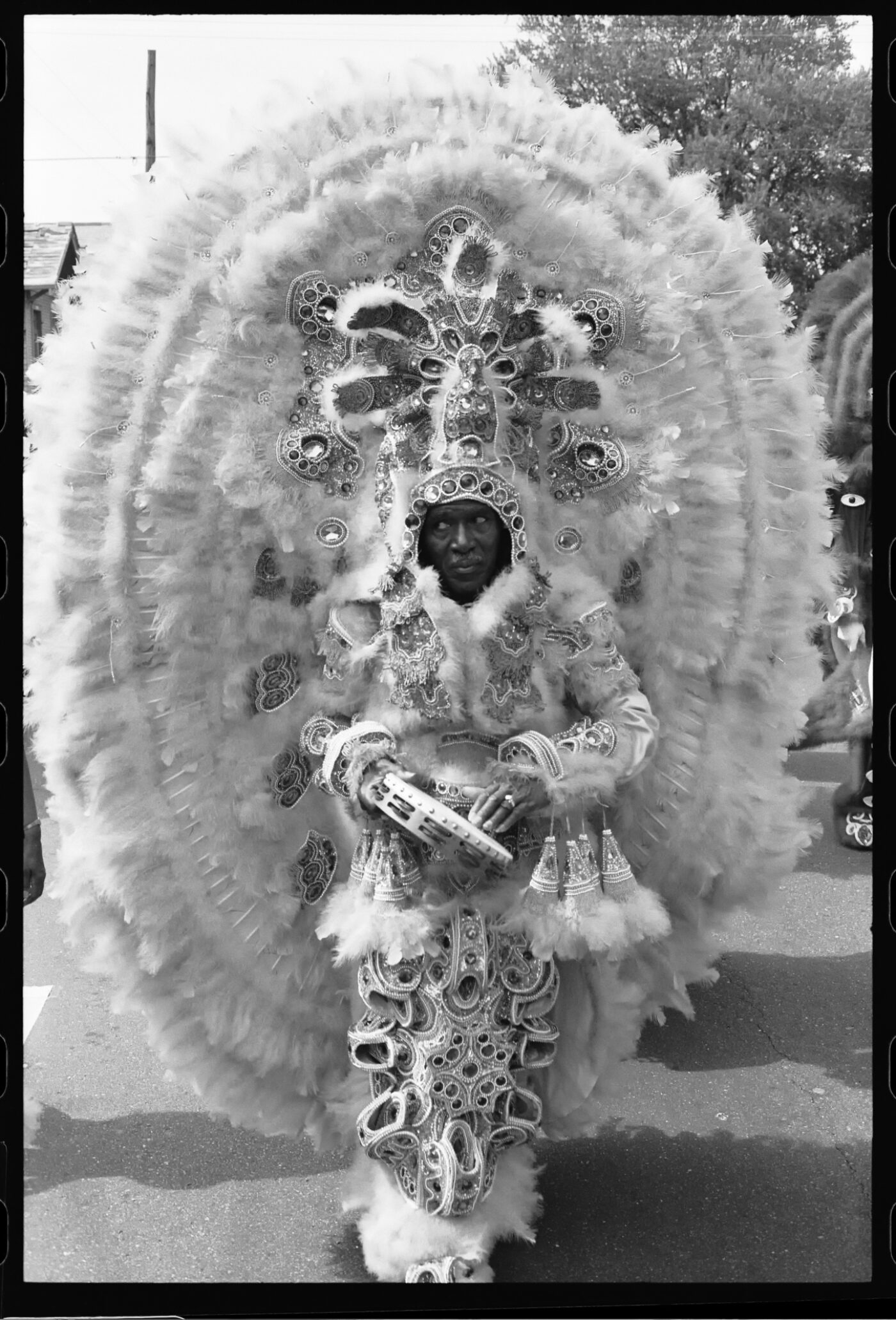
Allison “Tootie” Montana, ca. 1990’s. Photo by Eric Waters.
RBThe Indigenous people here do not use feathers and beads. They use other forms of cultural expressions.
WBWhen you study the mask-making tradition of Mexico, its wood carving is basically a synthesis of Catholicism and African mask-making traditions. We refer to it as Mexican masking, but its technique comes from the Africans. I learned that in New York. And I’m thinking, Man, we are everywhere. That’s where they dropped us off after slavery was abolished in the United States. This is the connection that we see. We are still unravelling why art looks like it does. There is a sensitization of African, Indian, and European understandings of creating something that fits within what we define as folk art. So, I think that that’s important too for them to understand.
CM It seems like we’re always ready to embrace someone else for what we already do and create.
RBThat’s part of us being colonial people.
WBThe first thing we have to accept is that we are a post-colonial people. And we need to understand the consequences of colonialism. The rhythms–all of that–is part of what we have come to understand as, on some level, being New Orleans. But when you hear our rhythms, underneath I hear the rhythms of Mali. I’m just fortunate enough to have been able to study this stuff. Eventually, I believe that more of us, particularly these young kids . . . I heard something on the radio yesterday about a library here that is doing an art show here with kids’ political art. That’s revolutionary as far as I’m concerned. Because if those young people are able to make something that they really believe is that personal, they will begin to understand that this is what creativity is about. It’s not about imitating whatever somebody else did, but it’s about making things that you feel passionate about. And then, if it sells for some reason, you’re onto something else. That means that we’re really getting closer to being ourselves rather than attempting to fit into another structure.
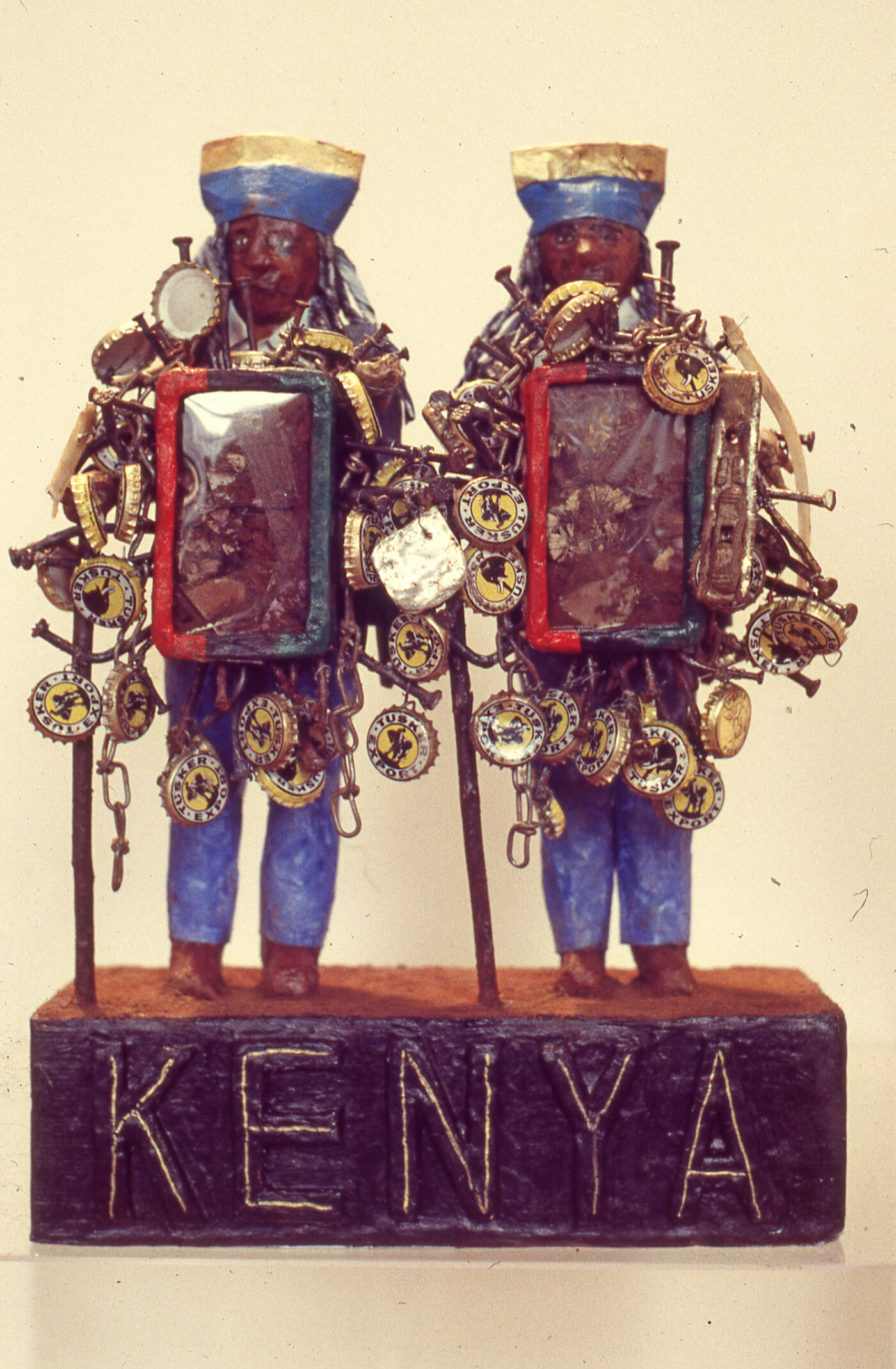
Willie Birch, The Nairobi Series: For the Mau Mau, ca. 1992-93, painted papier mâché and mixed media, 20 × 18 × 13 inches. Courtesy of the artist.
RBFor a long time, we used entertainment as a pacifier to things that really affect our lives. I think young people now, hopefully, recognize that there’s a difference between how we use entertainment as a pacifier rather than as something that you can use to actually talk about things that are going to affect you and your people. That’s something that’s changing. But, getting back to the significance of what you were saying earlier Willie, since the Europeans first came here, they brought enslaved Africans with them. So, we’ve always been here and a part of New Orleans. By the middle of [Jean-Baptiste Le Moyne, sieur de] Bienville’s reign (1702-1743) as the governor of French Louisiana, New Orleans was about half African because they needed a host of folks to build this place and that’s a significant thing to talk about.
SgYou’re pointing out the complications and the contradictions. The things that we know and the things that we don’t know. And what’s political. Well, almost all things are political. I do this exercise where I ask, When you think about the city of New Orleans, what are the images that come to mind?
CMI think other people see New Orleans as a big party town, specifically the French Quarter. Tourists come here to have a great old time.
SgWhat about the food?
KCThe hospitality of New Orleans… Neighborhoods like Tremé, you don’t even have to know folks there and they’ll offer you food.
WBWe’ve got a strong community.
SgThat’s our thing: Belonging. Like I know people that move here, and they feel like they found themselves.
WBIf you’re human, you can find yourself here. Geronimo Smith and I were talking about why people say Good morning and Good evening here. Visitors say, Wow, y’all are so nice. And I remember Geronimo saying, You do that because it’s a survival skill. Once somebody looks you in your face, you’re humanized.
RBThat’s right.
WBSo, the fact that we will speak to everybody is another mechanism of survival. I’ll use that visually some kind of way. But that’s what makes this place so incredible. And the fact that we are survival people, we have been able to take most of the stuff that has been cast away and made it into food or into dance or into costumes. Rituals. That comes out of our humanity. The music, the sounds that have been created, comes out of a need to express certain ideas. It’s an amalgamation of a lot of different things. Like we don’t have a North, South, East, West. We have Uptown, Downtown, Backatown, front of town. You have to improvise. The Mississippi, the land, forces us to improvise. Like most African peoples, we build according to the natural terrain; we don’t build according to a geometric North/South structure. We feel that if the river is coming through, or a stream is coming through, we will respect that natural path.
This city is not some accident in terms of architecture: It’s all part of a plan that Europeans understood.
SgOne of the things I want us to think about are the two versions of New Orleans. There’s the city that we know in its multiple layers and textures and sounds and colors. And then there’s the city that has been commercialized and sold. And so many people come here looking for the commercialized city and not the city we know.
CMIt’s out of context.
SgIt’s a kind of parachuting in and out, not naming the tribes or the people. How do these controlling images and narratives associated with New Orleans, including images from disaster, guide peoples’ perception?
CMAnd those are the type images they showed of us during Katrina.
SgThe world saw us at our worst.
As we’ve been talking about the slave trade, it’s clear that New Orleans could not exist without Blackness. And New Orleans exists as a city on top of an area that already had an identity. This place was known as a trading village that no single Indigenous Nation owned or necessarily claimed. Speaking of unclaimed, people don’t think about the slave trade in New York this way.
RBIt was the biggest slave trading post.
SgNew York became the largest slave trading port among the thirteen colonies within thirty years. New York City became a global economic superpower through slavery. Even after slavery was abolished, New York City was still invested in it and didn’t want to join the Union because it benefited from the cotton and sugar from the plantations. So, you have a city whose economy was rooted in racial slavery. It’s also a port city, right? And so, there’re these connections. But New Orleans, starting in the 1820s, and Savannah and Charleston were the primary port areas for about sixty percent of enslaved people who came to the Carolinas. And then we think about the domestic slave trade after international slave trade was abolished, New Orleans became the largest slavery port in North America.
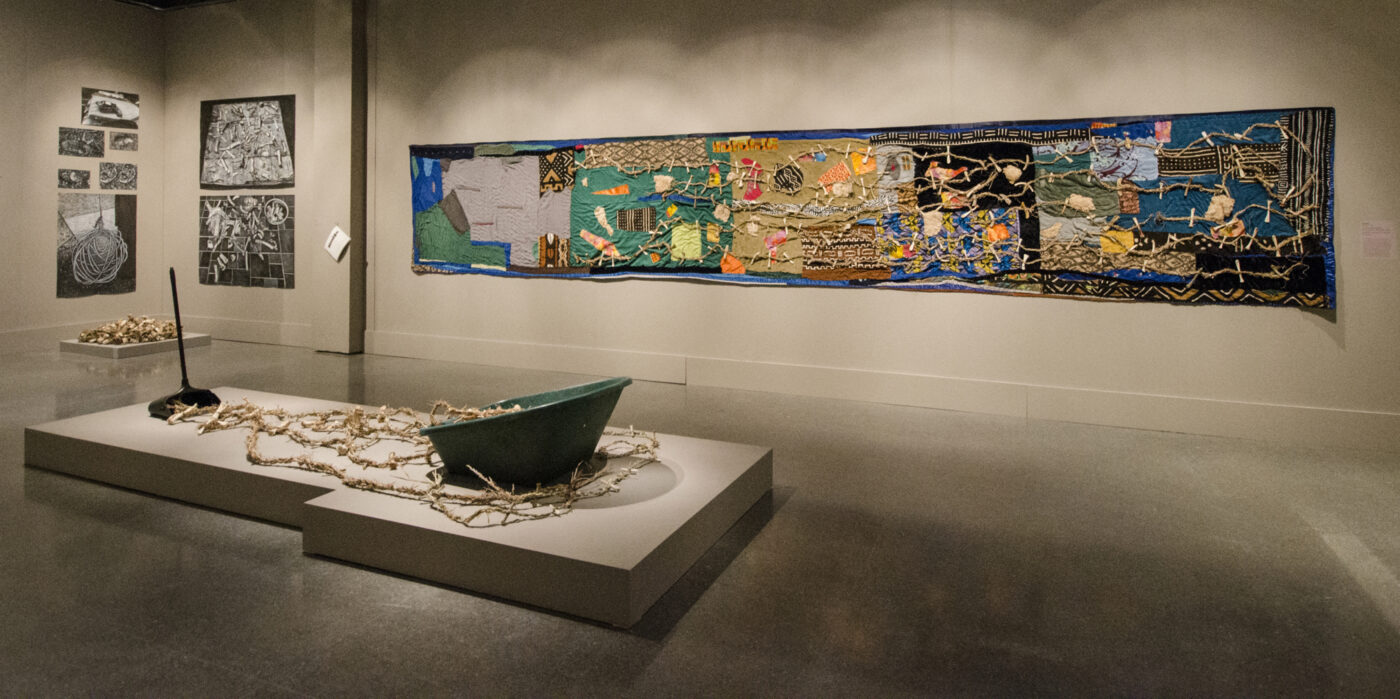
Installation view of Willie Birch, For a Generation Not Yet Born: The Louisiana Slave Revolt of 1811, 2018, quilted fabric, sweet grass, bones, and cotton, 24.5 × 4 feet. Courtesy of the artist.
WBI used to bring this history up in New York. As a matter of fact, I did a project with the Repository Group in Lower Manhattan. There was a law way back when that three or more Black people congregated together denoted a riot. Now, nobody ever wanted you to know that history. So, that makes what we are doing here, what Keith and Chandra have done with their prison photos, what Ron is doing in terms of the environment issues, much more important. And they’ve done this in a way that can’t be denied in terms of how we look at so-called art, and the way it has been defined. We have been trained enough in those institutions that it would be very difficult to say that our artwork has no worth. At the same time, this has nothing to do with western art. We are defining ourselves in a whole other sensibility. It’s like what we call outsider art. So, Ron and I have had the opportunity to delve into the layering of this. As Ron said this morning, We are projecting to the future. Our art is projecting to the future.
RBLet’s hope.
WBRight. But the art that even [Henri] Matisse and them were creating comes out of surrealism. It was to reject the art of Europe because Europe had been in wars, and it was a decadent place. It was its whole history. So here we come after that as artists, not as historians, and all of a sudden, we’re going to make something that reflects our experience, which you cannot deny. They have nothing to do with each other, that is the conspiracy. To me, art is always subversive. And I have no problem working in that platform. At this point, it’s very difficult for you to reject what I do because it fits within your canon, yet it has its own lifestyle.
SgHow would you describe or define the swag of New Orleans? I think it’s in the rhythmic patterns and sounds, in the soul of New Orleans. Because it’s that swag, those rhythmic patterns and sounds, that show up in the work. I think about your work, Ron; it reflects trees and nature. I feel like the trees become the witness and they hold space and they also reflect out. Looking at your work here, Mr. Birch, how it’s mirroring everyday life . . . I think about the work that you all have been doing documenting Black life in real time, documenting the everyday that becomes extraordinary. But it’s the everyday right? And how that wants to become extraordinary but can fall flat when everybody’s trying to be like Beyoncé or some other pop figure.
WBWe speak in double entendre. There’s a reason for that. It’s makes me think of the Negritude Movement.
SgTell me more about Negritude.
WB Aimé Césaire started the movement. We’ve heard of Richard Wright, James Baldwin, but we don’t talk much about Negritude. These brothers were beautiful, physically and in their attitude. It’s the same attitude that we have. So, the swagger is not something that we have to invent. All we do is stand on any corner. And when I stand up, you know this brother here got to be dealt with. (laughter) It’s just like that sister in my neighborhood. This sister comes up and she puts her hands on her hips and she just looks at the men working nearby and all of them stopped. (laughter) I decided to get my camera. I need to take a shot of this moment. (laughter) And the sister stood there and grinned. Because actually, that’s historical—
SgThe posture, that gesturing, that reflection.
WBIn fact, from my studying of African retentions through fractals, I realized that those things are part of us, intuitively, we live that, it’s just a part of your DNA. The key is getting this information to young people so that they can understand how powerful they are. We are engaging young people by talking, we’re trying to find young people who are writers now. That’s important. We have the visual artists and we’re looking for the writers.
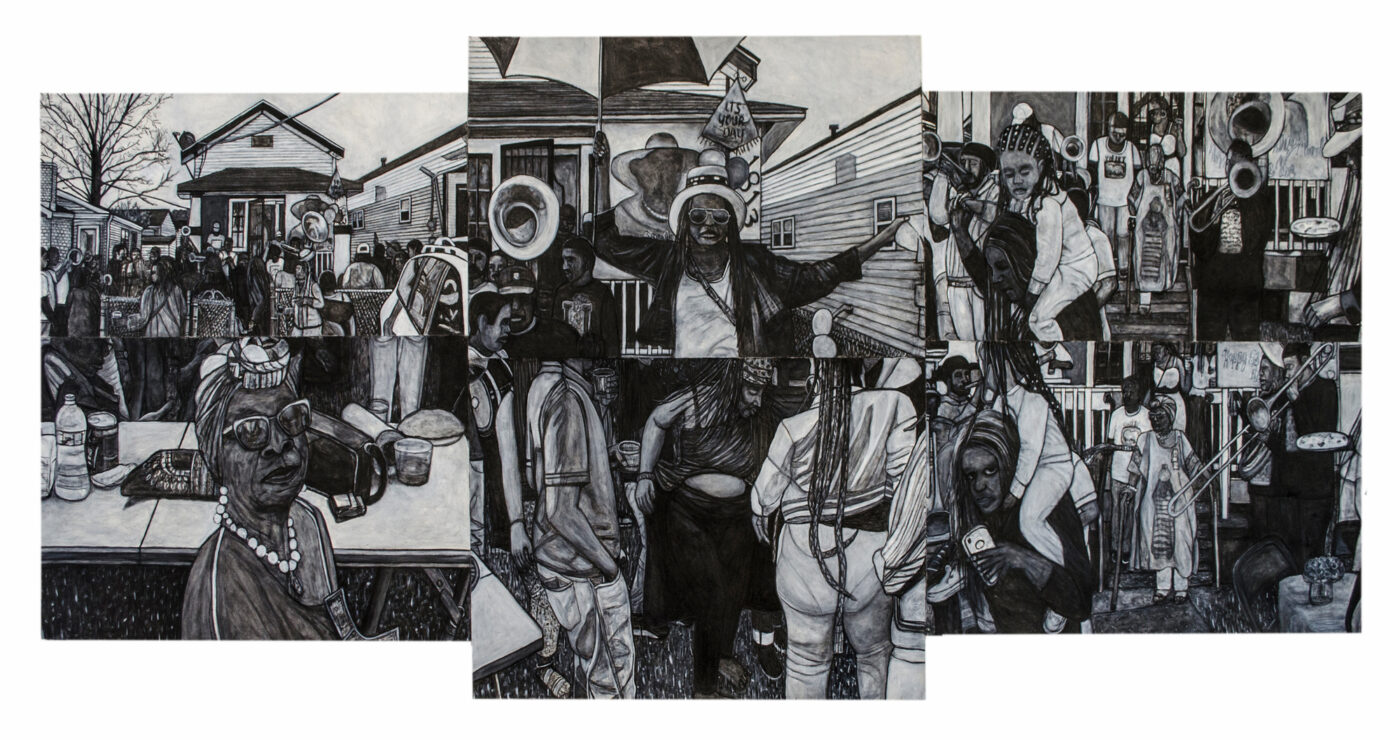
Willie Birch, Happy Birthday (We Celebrate You), 2023, charcoal and acrylic on paper, 62.5 × 143.5 inches. Courtesy of the artist.
CMYeah, the attitude, the swag, the postures, like you say. When I’m around my people, I’m seeing so much, and then I see it, again, in the work we do. It’s just beautiful. It’s as colorful as color is. It’s just very dramatic. When I’m out in my community, they move me. And so, I gravitate to pictures that do something for me. I hope to capture that moving feeling in my own work. To capture that and let your viewers understand it and see it and feel it as you do, that’s a beautiful thing. That’s the work.
WBThere’s another level to this. I’ve been in art schools since I was thirteen. In school you develop art skills that give you command over your materials. I also learned to create layers of history that spoke to the time I lived in. But we also understand there’s a history that’s not being seen. So, what do I do? I decide to continue this dialogue by creating another way of seeing that’s reflective of this time. That’s another layer, making something that visually excites you because your time frame demands that. It requires taking risks.
RBAnother thing about swag: It’s being a survivor and understanding your survival techniques.
WBRight, we bad mojo. Louis Armstrong saw that when he visited Africa.
SgOr even his art, his collages.
WBYeah. His full repertoire and how he was able to use it and help to make something that was so unique to the world.
RBMy maternal grandfather was interesting; I learned a lot from him. He would stand there and talk to white folks and tell them in his own way to go to hell and they would still look forward to the trip. (laughter)
KCI was just thinking, when I go to the second line for the parade, I don’t even think about shooting . . . I’m looking on the sidelines. We come and we make all our clothes, the fashion is there. When I go to other cities, they don’t have this same juju that’s running through here. The imagery of New Orleans invites you to walk out of the door.
SgIt’s right in front of you.
WBIt always has been.
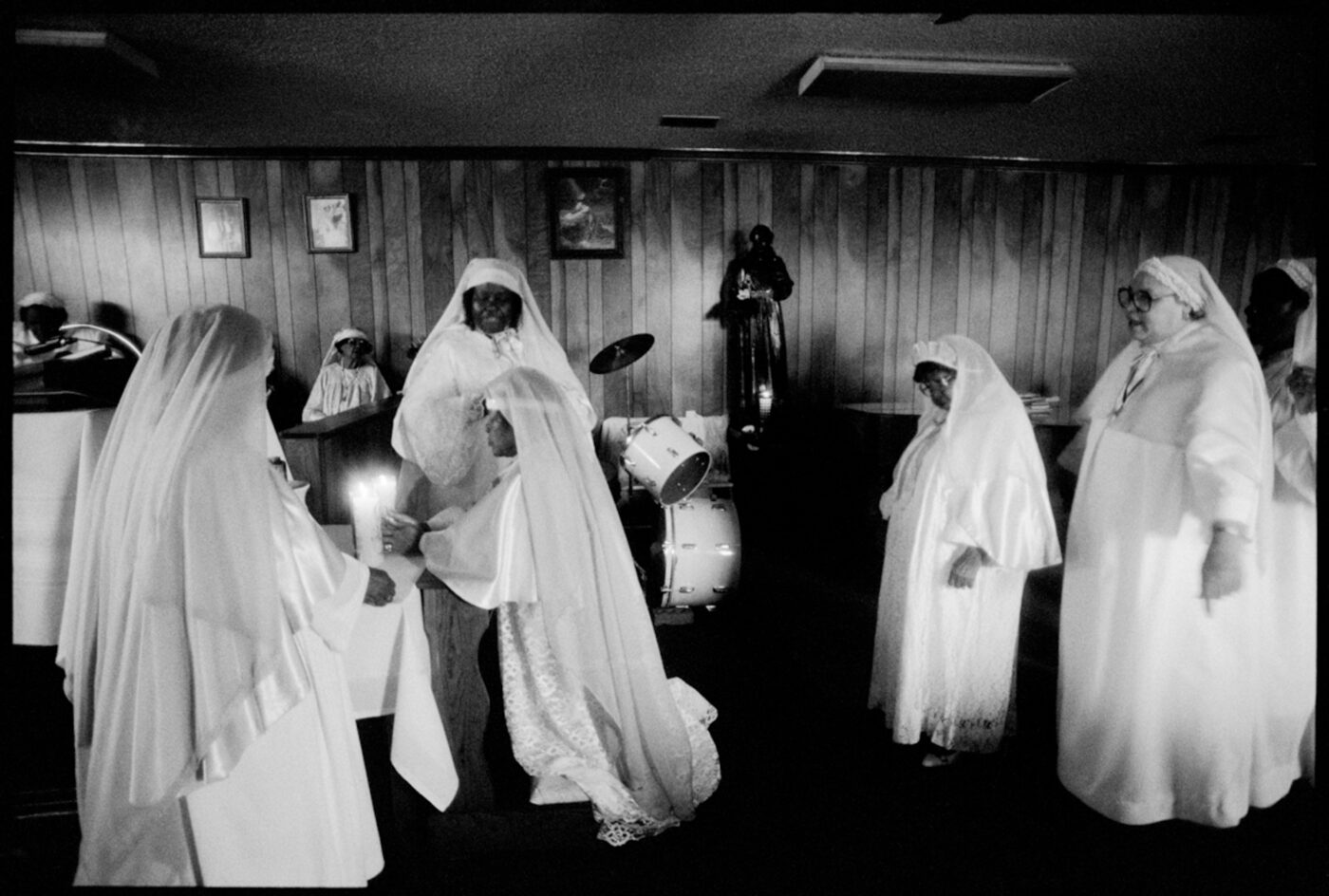
Chandra McCormick, Holy Family Spiritual Church, 1986. Courtesy of the artist.
KC
That’s why we work to teach the kids things they might not have seen. Chandra and I documented the last of the Black spiritual churches here in New Orleans. A lot of our spiritual practices were demonized. Anything we did that kept our juju going was called voodoo. And still today, a lot of these churches don’t really open up to the community because of what’s been said. Here in New Orleans, right in the Ninth Ward, I was able to document churches before Katrina that are now empty lots. No energy is there; it’s all gone. So, we’ve been fortunate to have seen that before it disappeared. The port of New Orleans, that’s sort of beginning to change.
WB
That’s why we’re talking about getting a lot of this work into public spaces. Because I had a wonderful experience with the first Prospect New Orleans exhibit I was in, and that was after the museum decided to buy three or four of my pieces.
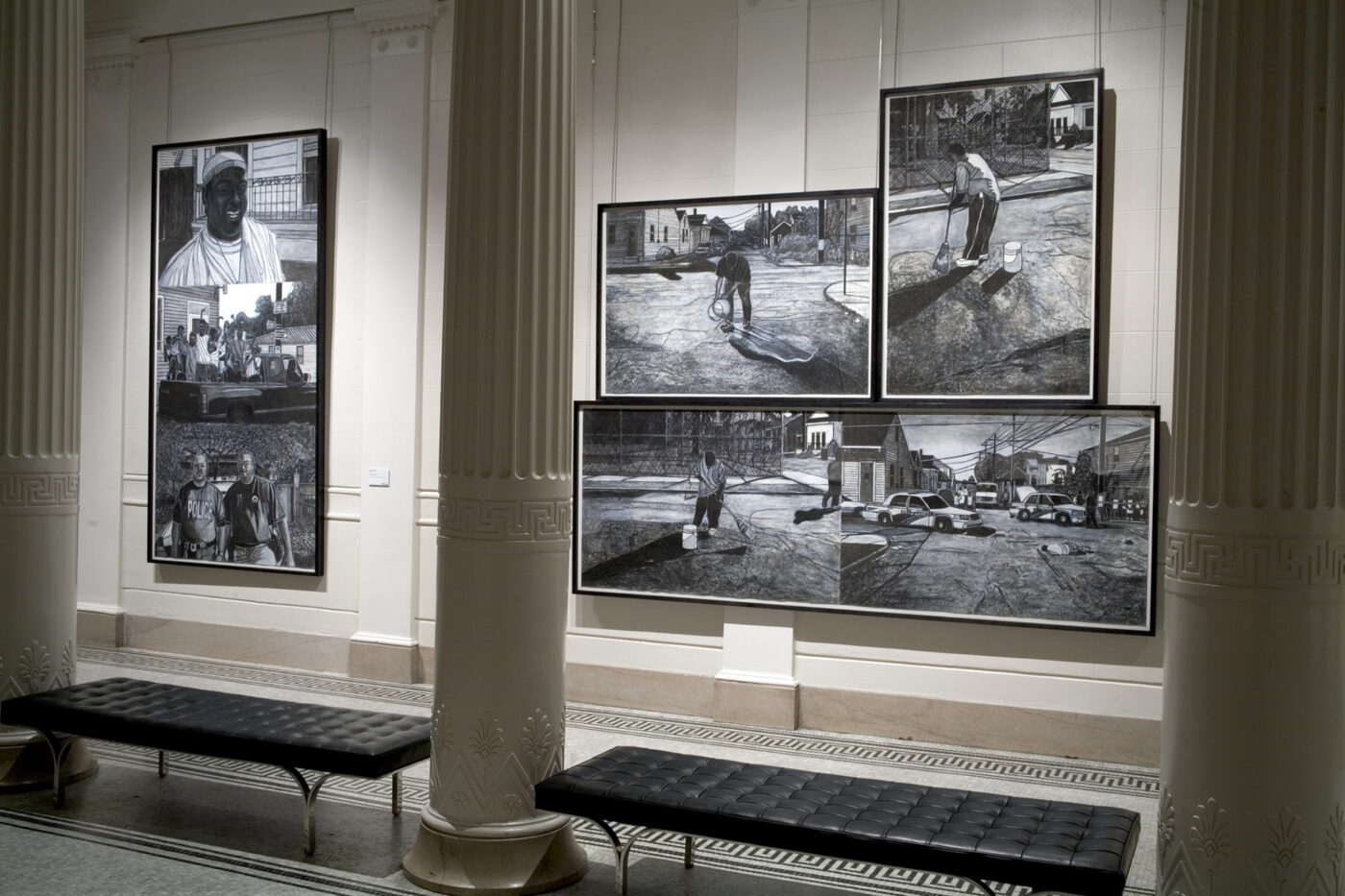
Installation view of Willie Birch, Black Boys and Sweeping, Scrubbing, Washing, Healing at Prospect 1 at the New Orleans Museum of Art, 2008. New Orleans, Louisiana. Courtesy of the artist.
WBThey extended my show for six weeks after Prospect. I learned two things: More Black people came to see Willie Birch’s show after Prospect, and people value seeing themselves. I did the LeBron James thing. I can count too, okay? Y’all are going to pay in terms of the museum. But at the same time, I realized that we are still intimidated by these public spaces because we don’t believe that they have anything to offer us. But look at the record they kept for Tootie’s show. Tootie’s show was one of the most revered shows in this city.
SgThis is in reference to the 1997 Tootie Montana show at the New Orleans Museum?
KCCalled He’s the Prettiest.
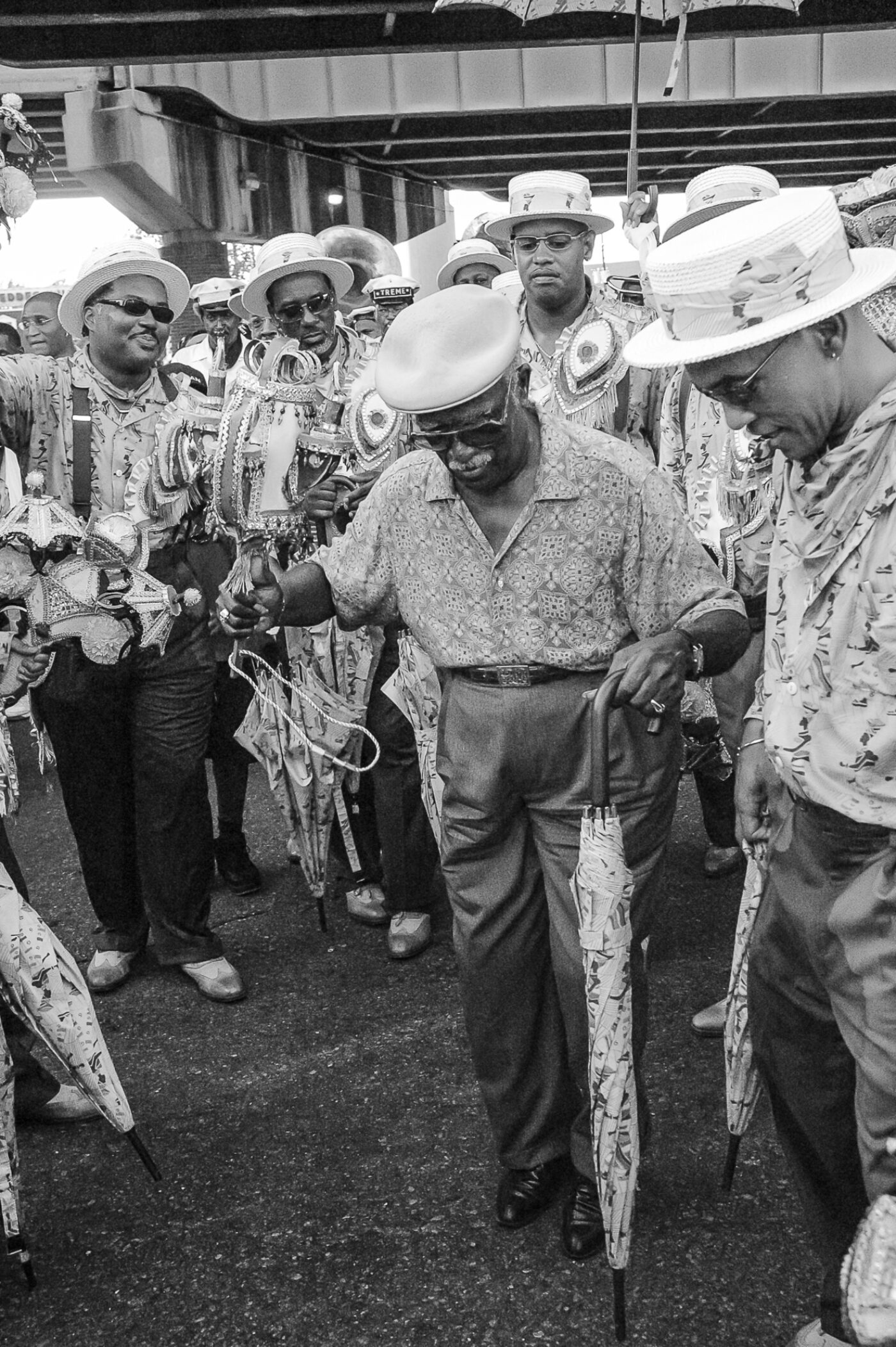
Allison “Tootie” Montana second lining at the Black Men of Labor Parade, 2004, New Orleans, LA. Photo by Eric Waters. Montana was the Big Chief of the Yellow Pocahontas Mardi Gras Indian Tribe. He’s The Prettiest: A Tribute To Big Chief Allison “Tootie” Montana’s 50 Years Of Mardi Gras Indian Suiting exhibition at the New Orleans Museum of Art celebrated the Big Chief’s folk art form of dressing on Mardi Gras day in elaborate handmade costumes.
WBI keep pushing that documentary that Keith and Chandra produced for that show.
The museum underestimated them because they didn’t realize the power of that film. And this whole city should see that. See, the information is there; we just have to make sure that we find enough people who understand the power of this culture to begin to project it to a larger community. This is the soul of America as far as I’m concerned. It was an incredible show.
RBWith a great catalog.
KCThe one thing about Tootie Montana, Tootie stood up for the artists.
CMWe’d been documenting him for years.
KCHe knew the importance of having us there to be part of this moment in time. They had other photographers and the museum wanted other people in mind for the film.
WBThe public sometimes thinks that something’s not valuable unless it’s in a museum. These are just the struggles of a people who have been enslaved and oppressed. But now with Black Lives Matter… As far as I’m concerned, this is our fourth revolution and women, once again, are taking a rightful place in this whole struggle. That’s what I appreciate about y’all sisters, and I welcome that because we only move as a village. Doing this in terms of divide and conquer has never and will never work. Now this is the time when we all could bring something beautiful to the table. There’s some incredible young artists that are a force. They give me credit for mentoring them, but the talent was always there. I just happened to offer a helpful critique. And told them, don’t be afraid to go there.
RBYeah, that’s when you know it’s done. (laughter)
WBMr. Romare Bearden told me, Willie, when you start stealing from yourself, you know you’re an artist. (laughter) I’ve had great mentors; so, it’s easy to pass that on because I can’t take it with me.
KCAlso, Ms. Carrie Maxine Holtry Daniels.
WBShe studied at the Sorbonne and the Cincinnati School of the Arts in 1942. She’s the one who came into Magnolia Projects and told my mother, Anna Poindexter, that she would work with me. Then, Ms. Daniels created an art school at the YMCA. I took classes at the Y twice a week, from eighth through ninth grade.
SgWhere was she from originally?
AllNew Orleans.
WBBorn and raised.
KCHer daddy started as a shoeshine man. And he worked his way up to owning an insurance company. And through that insurance company sent a lot of those guys to law school.
WBMs. Daniels was something special, too. She taught at—
All—Gilbert Academy.
WBAlong with Tom Dent and Harold Battiste. I was too young to go, plus my mama didn’t have the money.
SgSo, where did you go?
WBI went to Carter G. Woodson Junior High School. Can you imagine going to Woodson and learning that he’s the father of Negro history and this school was named after him?
The first paper I wrote in eighth grade was on Woodson. That’s why I’m fighting now–there are people trying to change the name to KIPP. I did a body of work a while back. They’re all black-and-white. I asked, Why are all of our icons either in ill repair or no longer exist? The Dew Drop and Magnolia Projects are part of that erasure.
RBIt’s interesting to think about school naming.
CMOne school, they’re changing the name from Martin Luther King back to Lawless. And people have a problem with it being Alfred Lawless, the Black man who founded the school. Of course, there’s nothing wrong with Martin Luther King.
RBBut Lawless was actually from New Orleans.
CMExactly.
RBAnd he built up this city. He brought education to the Ninth Ward. We have a history of that, communities building community schools.
KC He lived in the Ninth Ward.
WBYou can say the same thing about the first public library to serve Black patrons on Dryades Street. You could go right into it. Ms. Daniels introduced me to that library. Each summer, between eighth and ninth grade, we had to read so many books.
WBSo why do we do what we do? Because one of your questions must deal with that. We do this work because we owe those people who raised us. We would not be here without them.
SgOne of the things I’m noticing in your work is a fight against forgetting or a protest against erasure.
WBI truly believe that nobody throws away something that they feel has value. That’s the premise for why I create, why I do what do. Most people don’t know the activist Oretha Castle Haley, but she was one of my mentors. See, I had all these incredible people to pull little eighteen-year-old Willie aside and help me.
SgWell, why do you do what you do?
WBBecause I’m propelled. Compelled.
SgAnd what are you doing?
WBMaking imagery that I feel good about, that I feel represents my existence as a human being. I’m an artist. It’s that’s simple.
SgYou’re more than an artist.
WBI’m a person that has had a certain level of training that allows me to make the type of imagery I want and if I do it right, like I said, nobody is going to throw it away. That and if enough people believe in it, I like to think they’re going to find a way to preserve it. That’s all I do.
SgWhat do y’all think of what Mr. Birch said and shared?
RBI absolutely agree. Our artwork is the only thing that we have control over. The things that we do on the wall are all we have. It’s not up to us whether that is going to survive. We have no control over that. But we do have control over what we’re trying to say and do, understanding that all of this comes from someplace else other than us. And that it’s bigger than just us.
Like, Willie, I feel compelled—I have to do this. When I’m not doing this work, I feel incomplete. I like to use trees and natural elements, and those things are metaphors for me. We are of a tree that is represented to me as humanity. And there are several branches to that tree. We’re rooted within that structure and in humanity. It’s important to understand who I am as a human being within that bigger structure. When I’m drawing on that wall, I’m working through my understanding of my place in the bigger picture.
KCI’ve seen Ron talking to those trees before.
WBThey’ve been talking. (laughter) I’ll be blunt: Seeing Ron talk to trees and watching them talk back scared the shit out of me a couple of times. (laughter) I said, Woah, Ron, I need to go back home. (laughter)

Ron Bechet, Hariette’s Advice, 2020, charcoal on paper, 19 × 10 feet. Courtesy of the artist.
RBIt scared me too. (laughter)
KCNow, Professor Willie will bite you up, but Ron, he’s a good guy. Willie will say, I don’t care, take that shit off the wall. Ron, on the other hand, will try to engage everything.
WBRon’s more diplomatic.
KCWillie’s going to tell you, Who told you to put that on? (laughter)
WBYou’re learning too much now. (laughter)
SgI already know. I’ve seen you in action. (laughter)
WBHey, this is New Orleans—everybody has an opinion, doesn’t make you right or wrong. You’ve just got an opinion.
KCI was fortunate to document places we won’t ever be able to document again. I was fortunate to go into a maximum-security prison and now, when photographers call, they aren’t able to get in. We were blessed to survive Katrina. And I had no idea that the places I’ve documented before Katrina, like the Ninth Ward, that those neighborhoods would be boarded up and no more people sitting on the steps. Destroyed. So, when I look at the record that I have, we were fortunate, me and Chandra, in documenting New Orleans. It’s interesting to look back. People used to say, When are y’all going to move out the lower Ninth Ward? All the people who sold their houses moved to McComb and Slidell. Now, everyone is coming from Slidell to buy in the Ninth Ward. But those neighborhoods will never be the same.
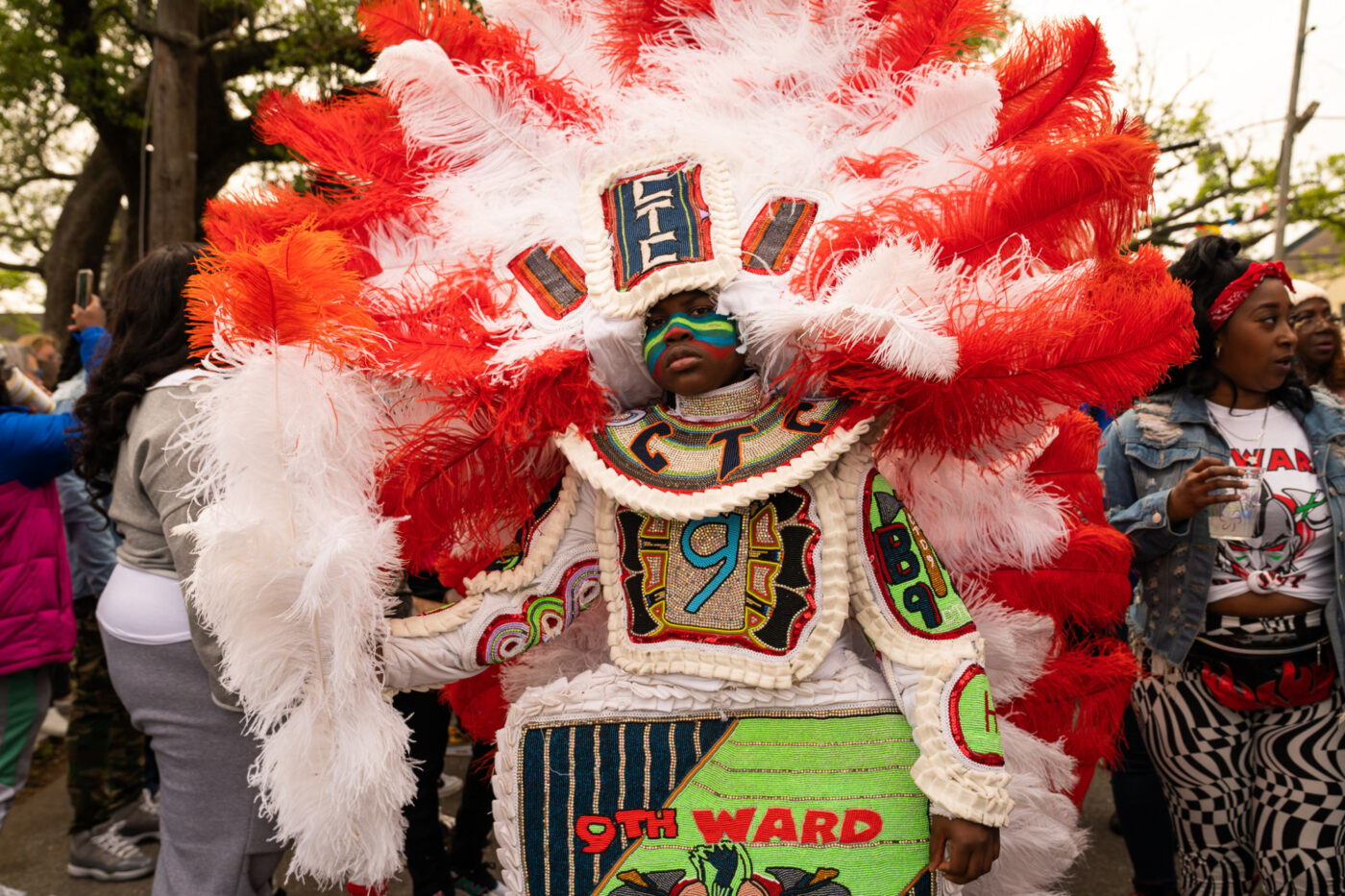
Herbert Motton, Lil Chief Scout of the Black Hatchet Black Masking Indian Tribe, Lower Ninth Ward, New Orleans, LA, 2023. Photo by Keith Calhoun. Courtesy of the artist.
So, you got to understand the soul that we had in this city was always right here, every day. You could go to Bullet’s or Seals and get a drink with your people. I think going to a second line [procession] is almost like a family reunion. Some people I only ever see during the second line at Mardi Gras or at a funeral.
The energy of this place and our work is freedom. A lot of artists come to me and say, Man, you’re still shooting in black-and-white. They didn’t realize that I could barely afford to shoot film during the time we shot all that black-and-white imagery. I’ve been blessed to have Chandra. When a lot of Chandra’s girlfriends would come by with their new pocketbooks, Chandra was spending her money on film.
We were fortunate to have foresight about the value of this work and still be able to have a base in New Orleans. But what has happened is we’ve been tricked out of our city. A lot of the young, educated Blacks, they’re not buying in the city. Now they want to buy out in the suburbs, and these white people move into the Ninth Ward, buying up the whole block. When my father came to the Ninth Ward at twenty-two years old, he knew the value of buying a piece of property. That’s where we’re losing.
RB
The highest incident of Black-owned property before Katrina was in the Ninth Ward, right?
WB
That’s right. Yeah.
RB
We had been given the okie doke. But we were tricked into thinking white-owned businesses are better.
WB
That was the problem with integration.
RB
That okie doke is something we have to wrestle with. That we’ve been told, again and again, through slavery and through this segregationist and supremacist lie, that something is wrong with us. How do we teach our younger people to deal with that? I understand that they have tremendous value, and they matter.
WB
I’m proud of the young people right now. Because I see a new way of thinking. As I age, my role is to be consistent because you never know when you’re going to be called on. When that call comes, you’ve got to be ready. Everybody didn’t like my black-and-whites when I started. They didn’t understand the switch because they love my papier mâché. But before my papier mâché, they loved my collages. I got about seventy bodies of work in each medium that has moved me to whatever I was moving to. I’ve been fortunate enough to be able to find a way to make a living by consistently making art for myself and to pay for the four babies I created. All their mothers knew that making art is the only thing I wanted to do. (laughter) It also helps me not to judge the younger generations.
RB
It is what it is. (laughter)
WB
I had a vision to really nurture all of us as a community. Five years ago, when I first tried to get a grant for this vision, somebody told me, This ain’t no art.
Sg
What was the vision?
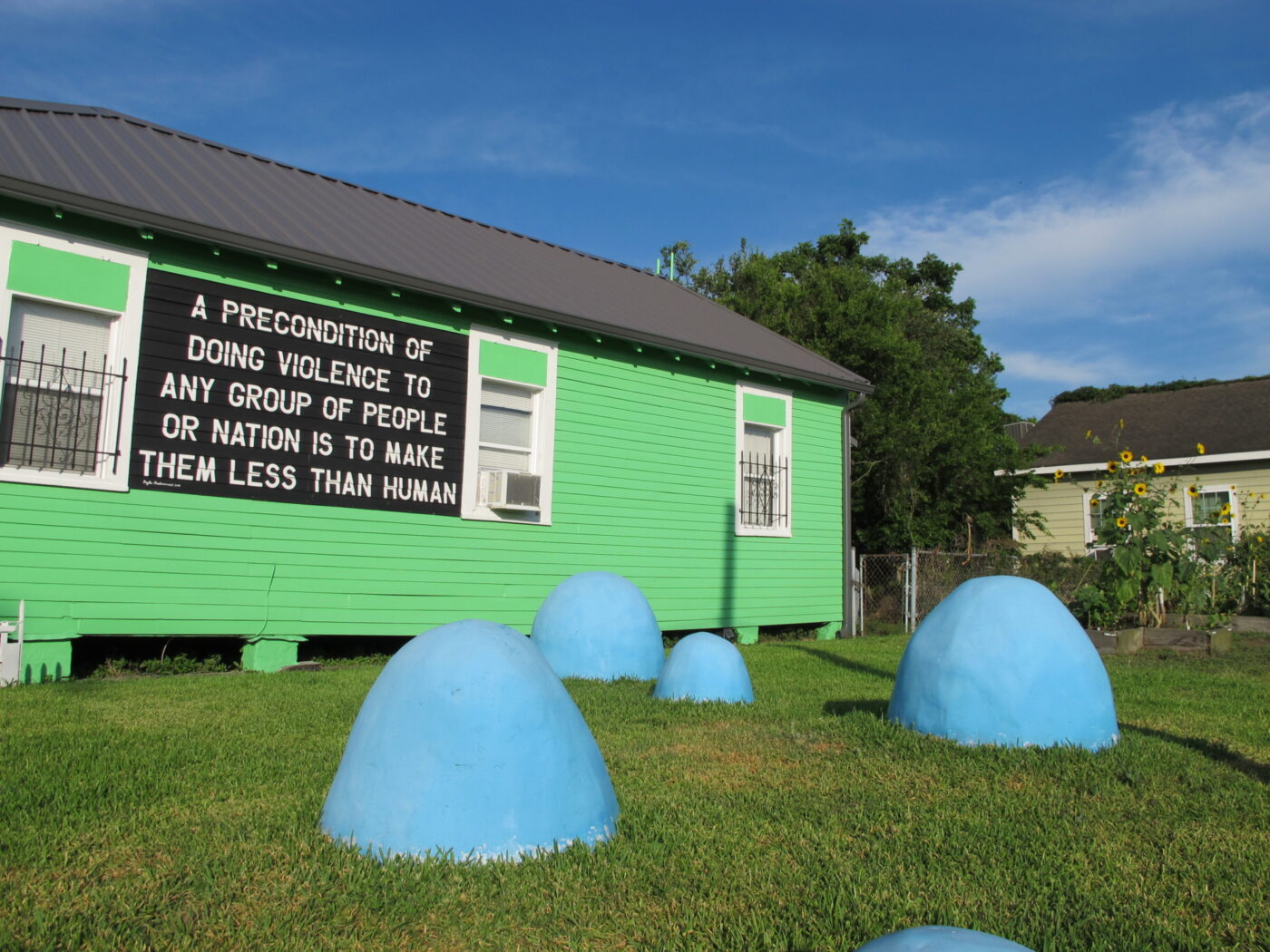
View of Rajko Radovanovic, A Precondition and Jennifer Odem, Blue Mounds at the Old Prieur Community Garden, 2016 to present. Courtesy of Willie Birch.
WBI wanted to create a garden and use it as a metaphor for art as a tool in the empowerment of the community. Initially, that vision was totally dumped on because somebody had decided that art was painting on easels. (laughter) And I’m saying, You folks don’t have any idea of conceptual art. This is the thing that I bring to the table. The conceptual art is not the paper it’s on, but the idea. These ideas come out of other European institutions, but they can be valid as we move forward in terms of what we bring to it. This is why when I saw your piece, Shana, at the CAC [Contemporary Arts Center], it gave me another sense that this young lady and I are going to have a real talk someday because she’s on and there are things that I can help her with, but I’m going to back off. I’ll await my spot.
SgYeah, I’m ready.
WBI know you’re ready. (laughter) But I can wait sometimes. I don’t always just say what’s on my mind unless I feel like the opportunity presents itself where we both are respectful of each other, and understand my critique is coming from an honest place. Because sometimes I can be brutal. But my intention is to help resolve this piece.
We have a hard time taking criticism because we’ve told everybody how talented they are. But we’re not that fragile and we have to get people to understand. You have to be more thick-skinned if you really are going to excel in this community because the whole world out there is not a very nice place. I remember when I taught a course at the—
RB—The Ogden Museum of Southern Art.
WBThe Ogden on Tremé. Tremé is a neighborhood with profound African and Creole heritage. So much so, they were doing a special program about Tremé on MSNBC, and they had all these kids who didn’t live in Tremé or know anything about Tremé. I was supposed to educate these kids on how to create art around a certain concept. And the kids were really brutal. So, I got all their numbers, and I called their mamas. (laughter) Everybody straightened up then. And then they made great stuff. When they went on MSNBC, everybody thought their work was wonderful.
I did a project with elementary school kids. This was a special project for me because I understood that life for young people in New Orleans changed after Katrina. I asked them, If you want to build a house, what kind of house would you want to make in New Orleans? They made shotgun houses out of cardboard. And then we had a show in their library. One of those kids is going to be like me after Ms. Daniels gave me my first shot. When I work with young people, I just trust that something will click.
RBTreat them all the same.
CMTreat them like they are somebody.
WBI did a workshop at YAYA Arts Center in 1995, teaching kids who were painting furniture, and who wanted to consider a practice beyond that, not to eliminate the furniture because the furniture is powerful, too. I invited Ron to come and do critiques. They’d never had those kinds of critiques.
SgWow, they were all products of YAYA?
WBIt’s a whole bunch of ’em. They’d say, Oh, Mr. Willie, we wanted to beat you up. (laughter) Well, you know, I grew up in Magnolia Projects so I can handle that. But the point is that that’s what we have to do, continue to do this work and help others to do it too because we are precious, and this moment is precious, and New Orleans is an untapped resource as far as the visuals. It’s perfect.
RBWe sound like we’re making you out to be this big bad wolf, Willie.
WBAnd I don’t want to be.
RBSometimes it’s about being genuinely concerned and caring.
WBWell, we played bad cop, good cop.
RBRight. (laughter)
CMYou’re stern. And if you have an opinion, you’re not going to change it. Or try to make somebody feel better. You want them to know whatever your truth is. It’s about learning how to accept constructive criticism.
RBYoung people don’t know what we know. The problem arises when you don’t say anything.
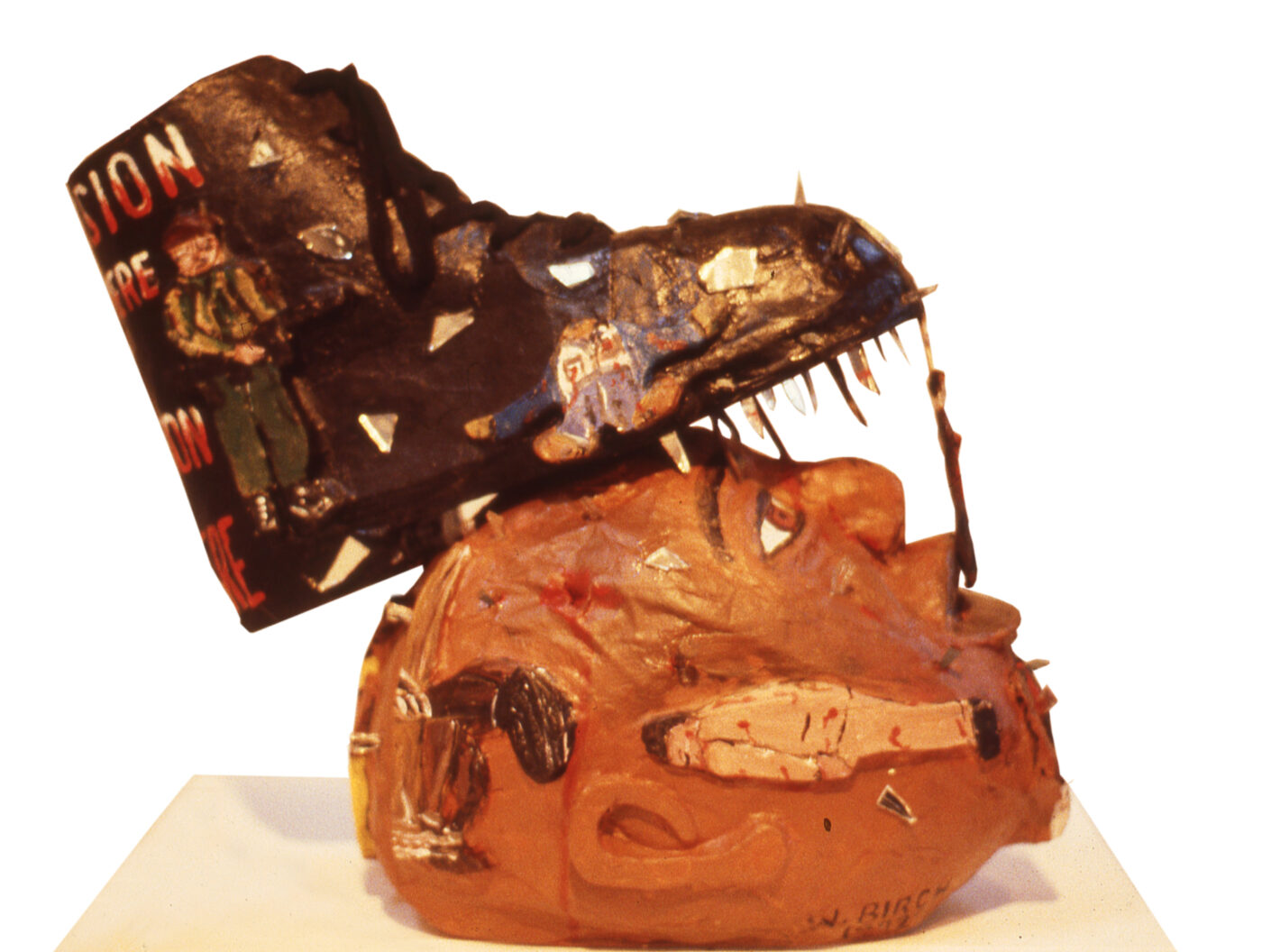
Willie Birch, The Nairobi Series: Oppression Anywhere is Oppression Everywhere, ca. 1992-93, painted papier mâché and mixed media, 14.5 × 16 × 7 inches. Courtesy of the artist.
WBSilence is acceptance.
RBExactly. As adults, when we work with the young people, we are obligated in some ways to give them a footing. We need to give them all the right information.
WBThat was so important in the Civil Rights Movement. When you are quiet and you know better, you have done a disservice to everybody. If I know what I want to make and I decide that I can’t make that because it’s going to offend somebody, that’s problematic. See, I got in trouble years ago. I did a piece called Black Jewish Relationship for the Piccolo Spoleto Outdoor Art Exhibition in Charleston, South Carolina. CNN wound up doing a big old thing about it. The Jewish community came to me and said, We’d like you to take that piece out of the show. I said, If you take it out, you’re going to make me a very wealthy man because I’m going to sue the shit out you. And so, at the opening, I’m standing over here with the Yoruba priest and the Jewish lady who gave this show, and everybody else on the other side. The next morning, when I checked the local paper in Charleston, it said, Artist dead serious. (laughter) I got on a plane and came back to Harlem. But of course, most people don’t know that about me. Ron knows a lot about me, but I don’t go around telling everybody all these stories. I am fighting for your ability and my ability to say what you feel. Here’s the caveat: As long as you’re respectful with what you say and you’re really trying to help somebody else get to a better place. If I can do that, then I’ve done what I’m supposed to do.
RBAnd to make sure that you can go to sleep at night and feel comfortable with it. And know that the community respects the fact.
SgKind of like that chant: We won’t bow down. (laughter)
WBHere’s some background: The Director of the Spoleto Festival came to me because I was left out of a previous show for whatever my politics are. When they chose the next artist-in-residence for Spoleto, that brother looked at me and said, Willie Birch, I’m going to support you. So, then the show went from Winston-Salem, where it didn’t create no harm, onto Charleston. When it got to this museum, that’s when, after they put the work up, somebody said, Now we could deal with all these Black issues, but once you started coming across those so-called racial divides, we don’t know if you should do this. So, that’s the issue that people had.

Willie Birch, Black Jewish Relationship,1993, mixed media on paper, 40 × 36 inches. Courtesy of the artist.
WBIt was a piece from my dialogue series. I did a whole body of work, matter of fact, my last body of work while living in New York in 1992. You had this radio program. This dude called Playthell Benjamin, journalist, and this very progressive Jewish brother. And they were talking about issues dealing with Black and Jewish relationships. And at the end, Playthell said, which was the punchline of the whole piece, “Sleeping in the same bed, dreaming different dreams.” And I said, Woah. So, when the curator for the show at Winston-Salem came here, he immediately saw that piece, and he loved it. So, of course, it was in the show. It’s in the catalogue. The controversy happened later. My gallery at the time sold the piece. (laughter) Sold it to this sister in California. The sister must have put it on her wall in California. Later on, she called me and said, “Willie, I’m sorry, but I’m having so many problems with this piece that I want you to keep the money, but I’m gonna send it back to you.” The piece is right here. Now, my gallery in New York wants that piece. Everybody wants that piece.
KCYeah.
WBI just found out a couple years ago that I was two-percent Jewish. (laughter)
KCYou know, we might be more than that.
WBThey’re Black people as far as I’m concerned; some have lost their way.
SgPalestinians also.
WBWe are all brothers and sisters.
SgOppressed people can also engage in oppressive systems.
WBThat’s my fear for Black people: That we get caught up in this whole dialogue because we can become as oppressive as anybody else. I want us to find a way to become a people that understand themselves as chosen.
SgYeah, I don’t think we have the power or the resources or institutions to back up any prejudice that we may have. Because we have prejudice. We just don’t have the power.
WBNot yet. (laughter)
SgI do believe that we’re going to get caught up in views to justify the oppression of others.
WBI agree. That’s why my art is very much geared to turning things on its head. Because it’s a conversation we need to have. And this is what artists do. For example, Philip Guston’s paintings with Klan figures. They’re critiquing the system. It’s about having dialogue.
SgWhat is the role of art in the liberatory movement? What is the visual sound of the revolution?
RBThe first rule is to keep things honest. Tell the truth.
WBThat’s what the role of the art is. That’s what Van Gogh was presenting.
CMPeople don’t always like to accept the truth.
WBYeah, initially. In this line of work, you have to trust your feelings. That’s where New Orleans is separated. I have a saying I always tell my students: Through intellect you can justify anything, but this artwork, your feelings about it, will tell you ninety-nine percent of the time if you’re right or wrong. So, I have learned to trust the intuitive part of me, as opposed to the intellectual part of me. Look at the artwork of self-taught artists, outsider art. So many outsider artists make brilliant art.
Unfortunately, it’s usually about the money. I’m struggling now with who I want to represent me as far as dealers and all that because we don’t have that many Black collectors. The ones who do collect, for the most part, are caught up in the nostalgia.
RBYesterday, the New York Times released a report about recently bought art, through museums and organizations. Eleven percent of it is from women artists.
WBFifty percent of the population. (laughter)
RBOnly two percent is from people of color. We’re about twelve percent African Americans in this country. More than half our population are women. The distribution is pitiful. So, when you use art as a reflection of the society, we’re way behind.
WBBut you know how hard it is to donate? (laughter) And I’m not saying that’s the issue. In 1976, my friend Dr. Leslie King-Hammond said to me, “Willie, if you think you’re so bad, see if you could donate a piece to a museum.” I thought that was pretty easy. So, of course, I chose NOMA, but they didn’t like the name of the piece, Land of Black series. I started it in graduate school, a piece based on the map of Africa in 1972. We went back and forth for about six months. They kept telling me, “We’re not going to take the piece unless you change the name.” And I said, Screw you. Finally, the curator, Bill Fagaly, said, “We want this piece.” That piece is in NOMA’s collection right now. (laughter)
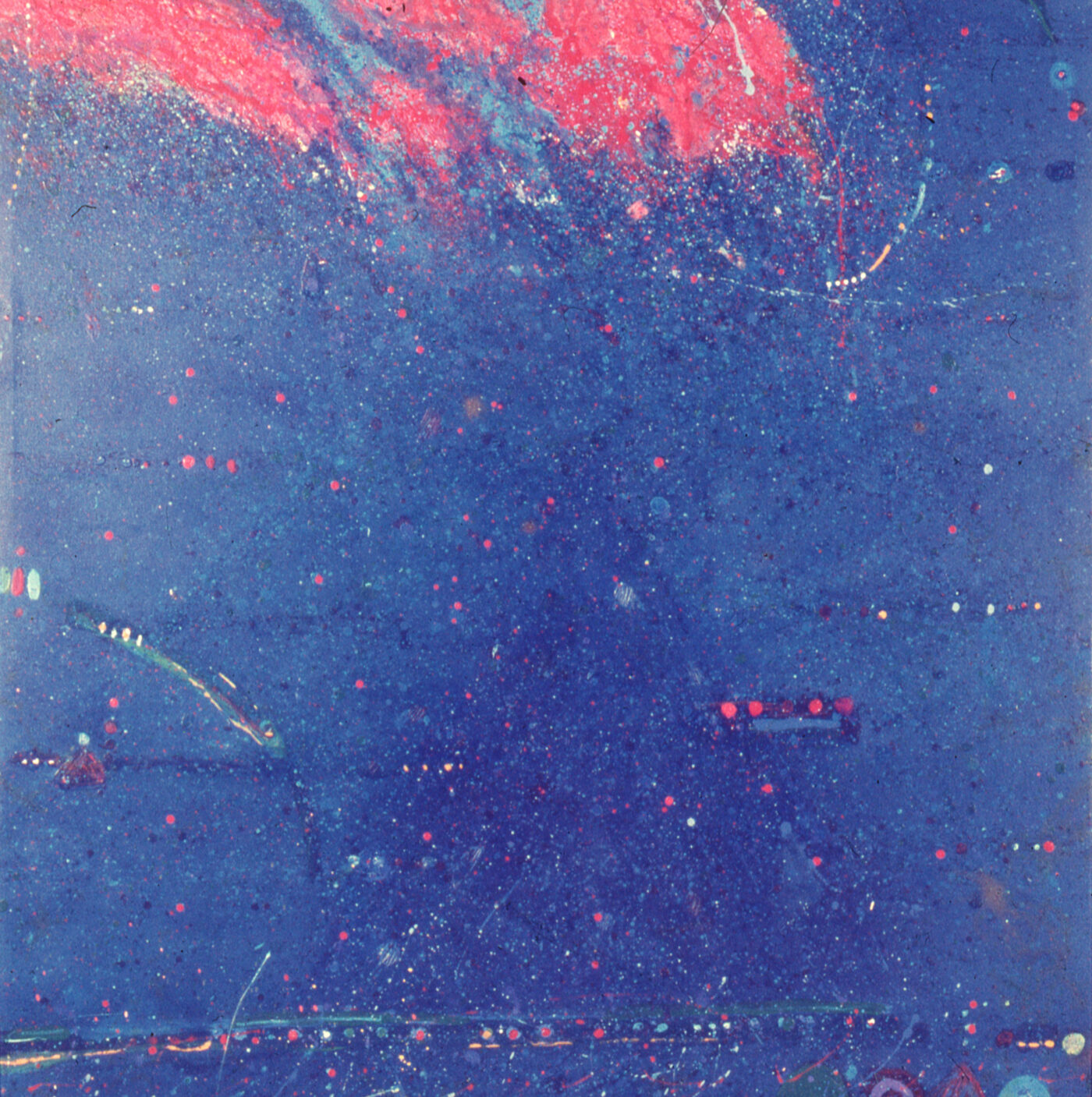
Willie Birch, Land of Blacks Series #6: Homage to Kitty Poindexter, 1973, acrylic on paper, 67 × 68 inches. Courtesy of the artist.
CMBut they wanted to dictate to you what to title your piece. That’s not—
WBThey tried to.
KCIt’s power.
WBThat’s why I came up with the statement about my mother. I said, “I want my mom, Anna Poindexter, to understand what I do.” The way I was working, doing so-called abstract work is a language. It’s not a literal language, it’s a tutored language, and I understand that very well. But at some point, it no longer served what I needed because I wanted another audience, and that audience was centered around Anna Poindexter. I slowly went back to the figure and have never left. In my show at Exit Art in 1992, I talk about the fact that I wanted a balance between content and process. I want both because I want to literally speak to the people about what I’m doing. At the same time, I want to speak to the art community. Because the art community can be just as revolutionary as any other body of people, except they choose to do what they do. So, I don’t have a problem with the ask from the museum, but that ain’t what I’m going to do. I’ve been riding this horse for a long time. Even then, I’m probably farther along than if I had played the game. But I’m from New Orleans.
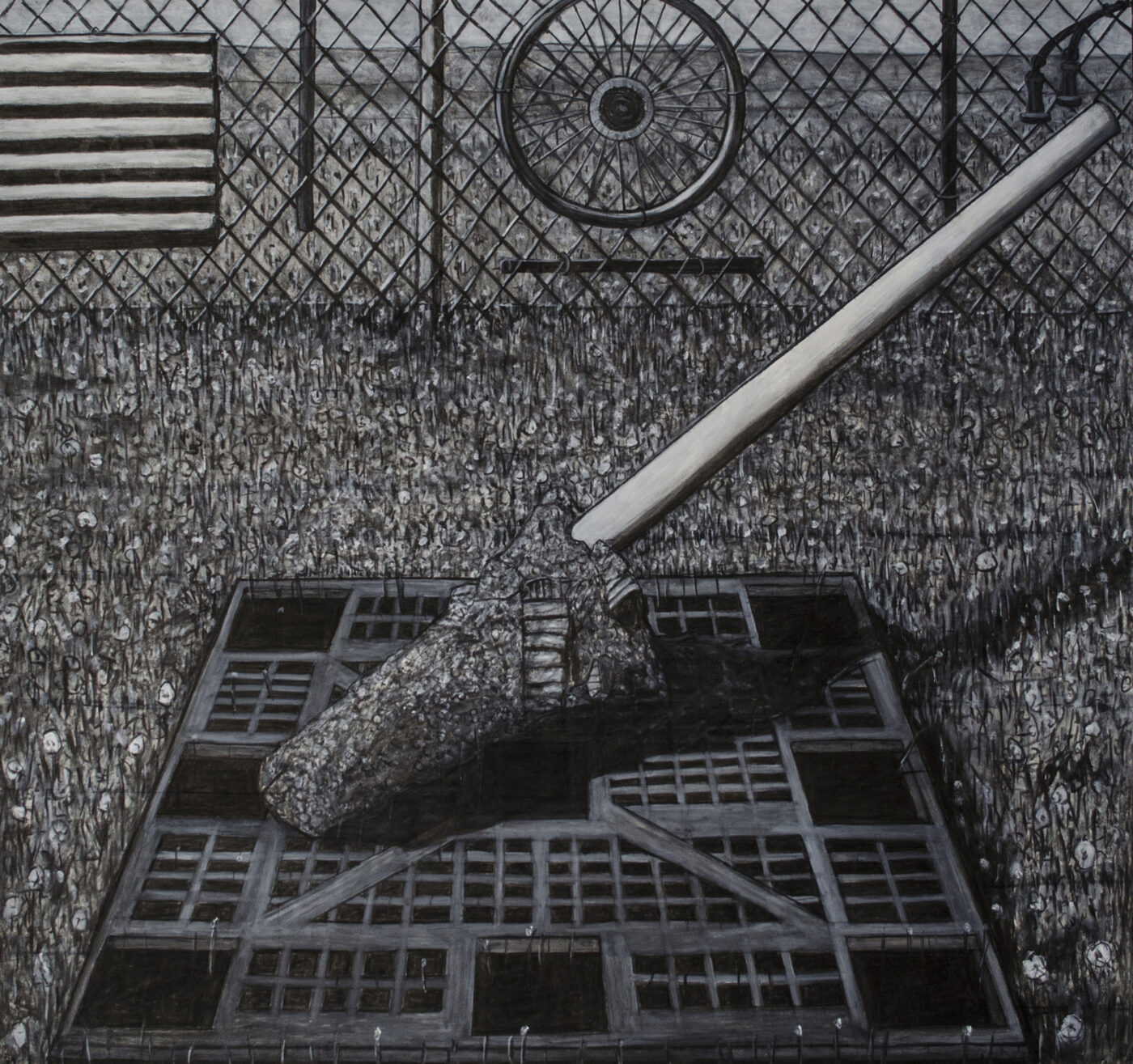
Willie Birch, We Are Always in Survival Mode: Homage to The Fallen Man, 2022, charcoal and acrylic on paper, 68 × 72 inches. Courtesy of the artist.
SgHow do you all reconcile these issues? There’s the representation part, then there’s also acquiring the work, and next there’s the historical function and purpose of museums. The archives of museums. The death of materials. How these institutions value certain artists’ work over others’. There’s a lot there. And, when people buy privately, no one sees it. So, there is a responsibility, when museums do acquire these works, for the general public to be able to engage the work. It begs the question, Who is the general public? Who do museums serve? Museums are mostly open when people are at work and everyday people won’t have time to come. That’s one thing. And secondly, museums shouldn’t be the only site where people can engage art. Artists are part of our community. There’s a role that artists play. How do we support the art and the artist? How do we encourage the relationship between creativity and art and social or civic life?
WBIt’s a lot of different layers.
SgI’m curious because it’s not easy to navigate.
WBIt’s not supposed to be. (laughter)
SgIt’s also intimidating. There are all these capitalistic impulses. How do you push back against that and make art a part of a liberatory movement?
KCTo be honest, I think it’s time for us to start creating our own museums in our communities.
WBWe don’t have the people inside of these institutions who understand the importance of what we have.
KCIf you look at most museums, where do they hire us? In education. We never see us in the power.
CMSecurity. (laughter)
KCI’ve been behind the scenes at museum parties where me, Ron, and Chandra might have been the only Blacks at the party. So, until we bring it Backatown… Like this conversation in Willie’s studio is a museum to me. It’s the kind of institution that Miss Leah Chase built. We need to organize it and get more educated young people who should be in the art world. Young people like y’all are trained but can’t find work in those institutions because they hire from within the circle. We need our own museum family. Ron could be a curator. If I’m the director, if a young person studies, they can get a job in the museum. I see a lot of young Black people in museums that are so talented, but they’ve got a ceiling there. Maybe we can start our museum family by tapping on some of these brothers with all this money in basketball and other sports. Get the money to build institutions.
WBIt’s a slow process. I call it eating—one bite at a time. I mean that. One day, the door is going to fall and Black people are going to rush in. New Orleans is an unusual place because the nature of the culture is based upon the lives and the rituals of Black people. You cannot eliminate us from the conversation. The fact that they have let me in the house is enough. Each time I’ll come out and tell you what’s in the house. Art is a conspiratorial act. Because in creating, I define me, not you. Now, you may reject what I do because you have that right, but you don’t have the right to tell me what to do.
RB You can sell, or you can sell out. That’s an important concept. It’s more important to understand that there is no compromise on what I make. It has to be authentic to me. I’m not concerned about my work being in a so-called gallery and having to sell it. I do other things if I need to for the daily bread but for my daily soul, I have to create.
WBI remember when everybody said, Oh, that’s the end of Willie Birch. (laughter) Ha-ha. A point I like to make is in this country, the only art form that has come out of the western hemisphere is jazz. Where did it come from? It came from New Orleans. What is it based upon? It’s based upon a people who understood how to reinvent themselves, to make things that were relevant to them, sounds unique to their experience. The rest of the world called it democratic; they called it freedom. You call it what you want. New Orleans is a dangerous place because what we do is not based on money. It’s based upon a need to speak to and for ourselves. No different than when that brother goes to the second line on a Sunday. It’s the greatest show in the world.
CMI do this work because it’s a passion to me. I love it. I love the people. Throughout history, a lot of our contributions, our passion work, has been erased. I’m just not going to speak well of institutions. And I might sound like I’m angry.
WBYou are and that’s okay.
CMIt is okay. But let me just say this: I don’t have to answer to nobody because it came out of my pockets. I helped to create the work that I have and I’m happy about it. I do it for me; I do it for my people. I think we need to stop tap dancing around the fact that the people who are running the institutions here do not patronize us and they do not care about collecting our art.
WBWe all agree with you. (laughter)
CMI think that we need to start with a dialogue. What do we do in these institutions? We are the security. We are the education and programming. We are the custodians. The curators and directors make hundreds of thousands of dollars. My tax dollars shouldn’t be paying that when we’re not welcome there. That’s why we need to start with the institutions.
WBNothing you’re saying I disagree with.
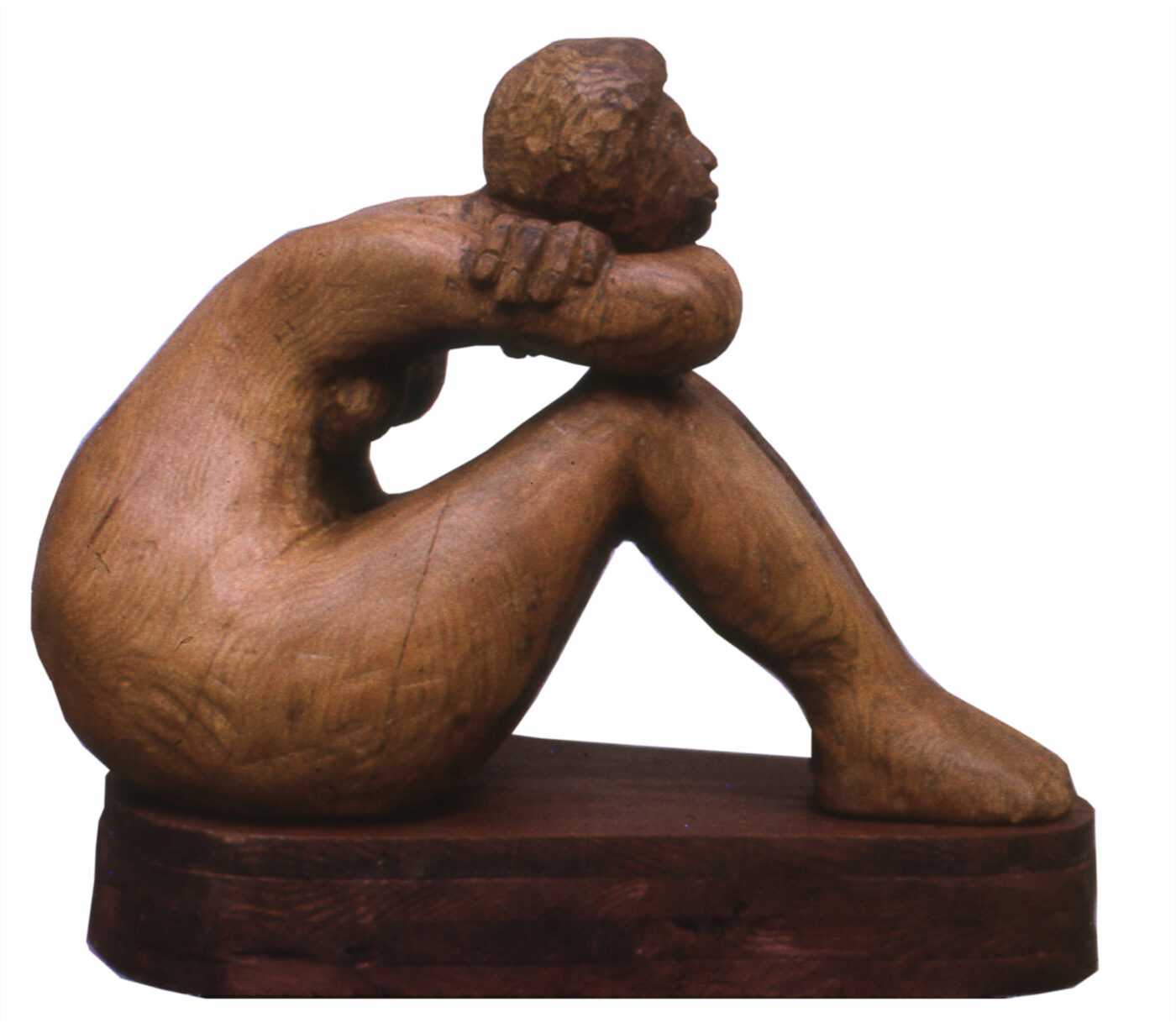
Willie Birch, Seated Female Figure, ca. 1970-71, carved found wood, 18 × 18 × 10 inches. Courtesy of the artist.
SgSo, I think there’s a couple of things at play here. One is we know that there are no easy answers when you think about our engagement within the arts field. And then there is the distinction between socially conscious and commercial art. Some artists create specifically to sell. There are other artists who create to reflect the communities from which they come that have nurtured them and that they work in. They want their work to be accessible. Then there’s the question of value. How do you value not just art, but Black art and Black women artists or other people of color that are always on the margins? There’s no easy answer so how do we enter into a dialogue? How do we consider that we might be complicit even in our critique? For example, there are some people who support The Helis Foundation.
WBRight.
SgWhy is it called the Helis Foundation, John T. Scott Center? It’s already his center. It conveys a sense of ownership.
CMThey put their name on it.
SgThey’re investing in it but what does that investment really mean? I think some of their investment is in ownership. When you come from a community and a history of conquest and enslavement, there’s always suspicion about the intentions of others. Owning the work is like owning me. Is it possible to exist in a world where we can have a natural transaction that includes recognition of my creative work and my desire to have an audience see my work? We live in a world where people pay lip service to equity. Equity costs and people are not able to invest in that.
WBI agree. It’s incredibly complicated and there is no easy answer. The key seems to be understanding what you’re most comfortable with. I find that I have a real problem with selling my own work. All I can do is put a value on it. A gallery I was with was trying to undersell my work because me being the highest paid artist was a threat to everybody else in his gallery. When I found that out, I got out of there. Sometimes it feels like you are by yourself, always being challenged.
KCThat’s why we need more collectives. If not, things will stay the same.
RBWe have to teach us how to value our own culture.
WBI’ll give you an example of something that just happened. I’m supposed to be SUNO’s most prestigious graduate. They’ve got this brand new museum. They offered me the first show but they don’t have a curator. I suggested that they hire Laura Simms or Leslie King-Hammond or another art historian interested in educating, especially Black people, about the importance of what we create. Then, we can have a major conference at SUNO. They could bring all these people here for a week and dialogue around the issues that we are discussing right now.
RBIt’s a battle. You have to be willing to take on institutions and be a warrior for the work that you want to see.
WBUnfortunately, we’ve grown up in a system that says old people have no value. I mean, this is part of how we have been programmed. We have bought into the idea that the individual is more important than the collective. I have a daughter that says, It’s about me, dad. And I say, No, baby, it ain’t about you. I have these arguments every day with young people. I’ve got Black kids from Harvard. I tell them, You think you’re just at Harvard because you’re supposed to be bright? No, there’s a whole system at work that allows you to get there. So, what are you going to do with this opportunity? How can you support your community? How can you bring somebody with you? They usually tell me that’s hard. Of course, it’s hard. I’ve been in this lane longer than them. It’s going to continue to be hard, but we keep moving forward until the body runs out. And then someone else will take on this hard work.
SgHow do you use yourself as a platform to bring other people in?
WBYou put it in writing that these are the terms.
SgWe are racialized subjects, and we have a strong grounding of where we are. So, what are those opportunities? We know these Black institutions—most of them are not perfect. Some of them are also challenging to work with.
RBAmen.
SgSo how do we do both?
WBI only can speak for how I do it. But there is no single answer. And we need to be realistic about that. And invite as many people to the table as we can.
Shana, I was intentional about working with you. I remember when I saw you out.
SgWe were in Whole Foods. I saw this fly cat looking sharp. You wore these overalls with a blazer and a hat.
WBYou were with someone who didn’t speak to me.
SgLet’s be honest. You can be intimidating. (laughter)
WBBut I’m not trying to be.
SgYou don’t need to try. It’s your presence. (laughter) You have a reputation. Your works speak for themselves and who you are speaks for itself. You’re the kind of person that critiques people. You call them out and they just want more. Especially the white ones. (laughter)
WBThe real beauty of me is that I don’t want to edit this.
CMIt’s because you’re honest.
WBBecause I have no problem with what I say. I can defend it.
Did you know that we made Chasing Dreams: A Leah Chase Story–the film on Ms. Chase–and won first place in the New Orleans Film Festival?
SgI didn’t realize it won first place.
WBThey showed it at the Orpheum when Leah Chase died. They didn’t invite me, but my great friend, Sonia Sanchez, was there. So, Sonia said, Where’s Willie? She couldn’t believe they were showing this film and didn’t bother to invite me. But that’s why I move the way that I do. I won’t convince you who I am. The work will have to convince you.
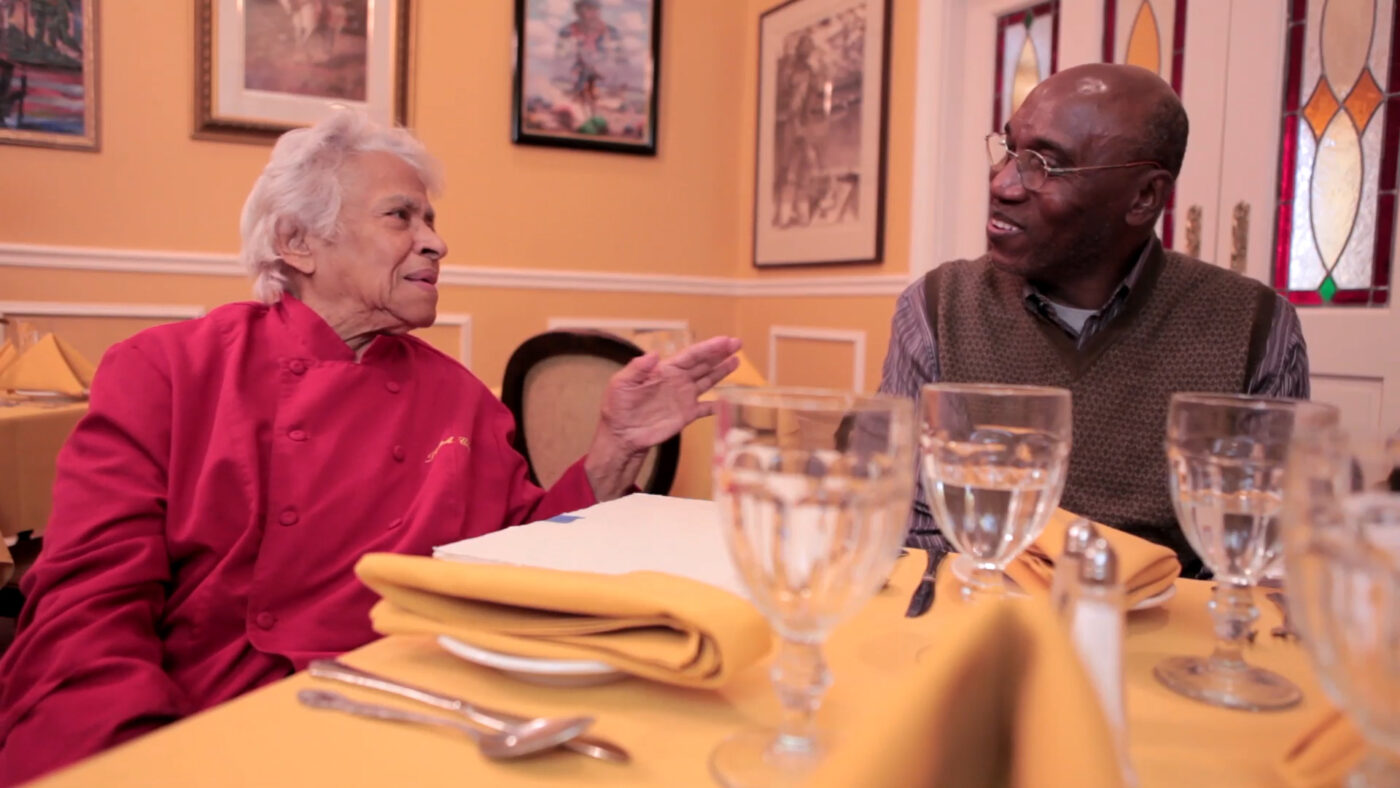
Still from Chasing Dreams: A Leah Chase Story, 2011, dir. William Sabourin O’Reilly. Courtesy of William Sabourin O’Reilly.
SgHow do we create opportunity in a way that’s not predatory? Think about post-Katrina, immediately after the storm—the properties that people were selling were so low. We’re never going to see that again.
All(in unison) Right.
Sg Also recognizing the landscape, being able to see a vision, having a vision, not just in this moment, five, ten, twenty years later. People acquired a lot, and now certain neighbors can’t even begin to consider buying, right?
CMThey’re not going to let it go, so you’d be lucky if you can get to buy it.
WBSo, this is what’s nice: That I have my real close friends. The three people I invited to this kitchen table talk. I also realize that people watch my back because they trust that I’m doing something that’s relevant to their lives and their children’s lives.
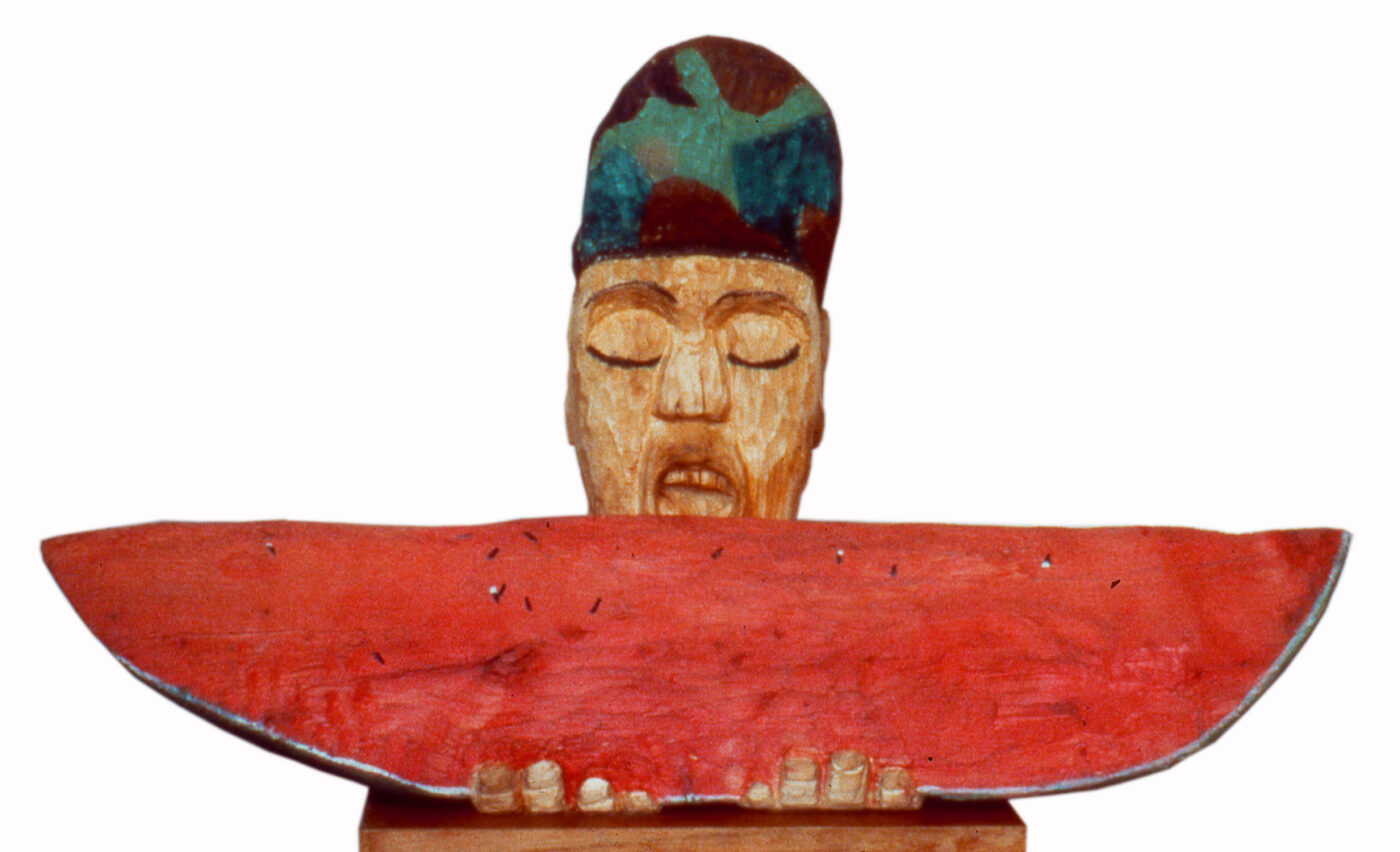
Willie Birch, A Break from the Revolution,1984, painted wood, 16 × 28 × 10.5 inches. Courtesy of the artist.
WBMy mother was the main cook for New Orleans’ Mayors deLesseps, Morrison, and Schiro when they had the big meals. But then when I got in trouble in the Civil Rights Movement, they had to fire her. (laughter)
KCBecause of you?
WBYeah, she couldn’t control me, and I didn’t understand. But I understood later on that what I was doing affected the lives of a lot of people. So, my mom said, “Willie, you gotta go, you got us in trouble.”
SgDid you learn to cook from your mother? The gumbo for your party?
WBOh yeah. I once cooked for about thirty people. I made gumbo.
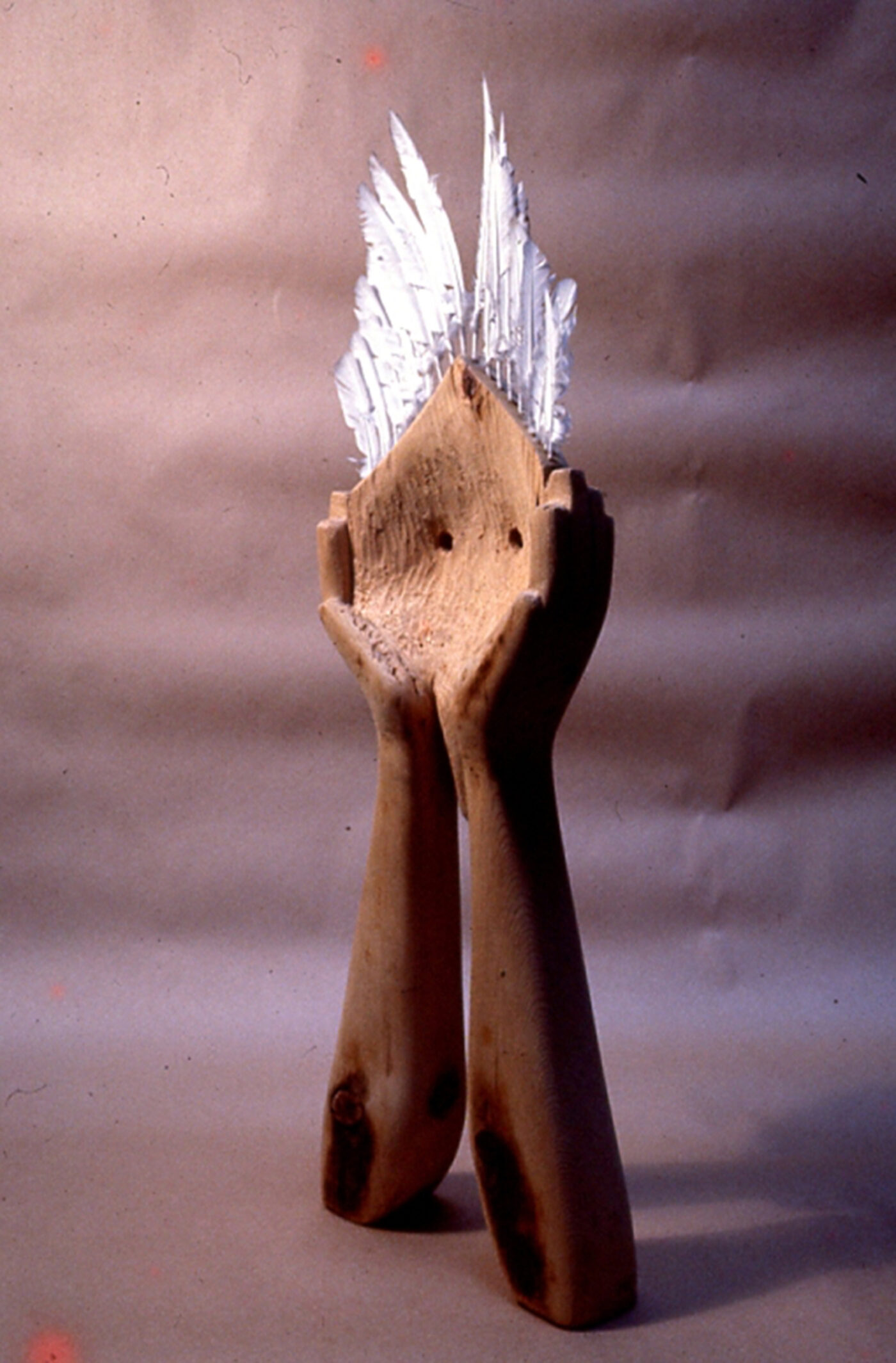
Willie Birch, Voices from the Belly of the Earth, ca. 1979-82, carved wood. Courtesy of the artist.
RBYou know, back to art, we make art for a reason.
WBRight. I’ve been thinking about how culture changes. Cultures are natural phenomena, but how do you keep the root? Sometimes culture changes to suit another understanding.
CMWhich makes it not what it was anymore. They’ve already had people infiltrate our culture. They’ve already invited people in who are not like us. So, I don’t even know what makes it sacred.
WBBut I don’t worry about us in New Orleans when it comes to this infiltration.
CMI have never worried about it until the last twenty or fifteen years; I’ve noticed other people being involved.
WBI remember Tootie had people involved who were not explicitly a part of his culture.
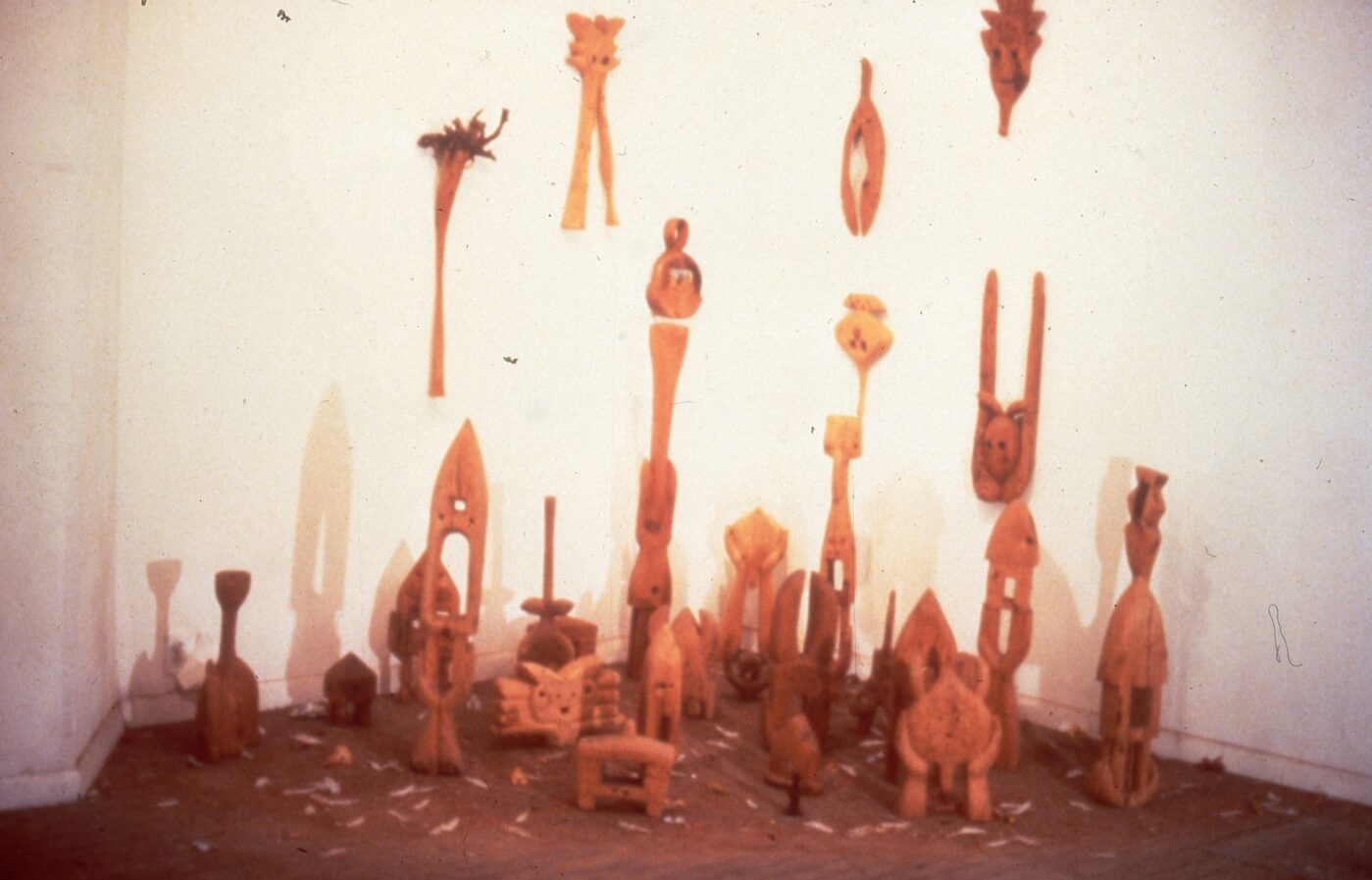
Installation view of Willie Birch, Voices from the Belly of the Earth, ca. 1979-82, carved wood. Courtesy of the artist.
CMThe beginning of the infiltration was in the ’80s when the media from New Orleans attacked the Indians because we would not let other people into our sacred traditions. That’s when they began to be called Mardi Gras Indians.
WBThey’re always called Mardi Gras Indians.
CMNo, they weren’t. They were called Indians and we already knew that they were Black.
And Mardi Gras wasn’t even Mardi Gras for us. We called it Carnival.
WBWe always called it Carnival because all over the world they call it Carnival.
CMI’m just saying Mardi Gras is a pagan day that we created.
WBYeah, they got Bacchus and all that stuff. But the key is that I don’t see all white people as my enemy.
CMAll I’m saying, Willie, is this: I grew up seeing Indians in the second line. But when I started getting involved–by this time I was a young woman–it was a segregated experience.
WBI agree with you. When I would come out at five-years-old and stand on the South, on the neutral ground, and watch the Indians, they’d come out of the Magnolia Projects on one side and come out of the 6th Street side on the other; and then they’d come out and they’d come down going toward Jackson.
CMHow many white people were in the Indians?
WBNone. This was at the Dew Drop. Why do you think the Dew Drop had that big battle of the Kings—B.B. King, Earl King, and Lil’ Freddie King? It was because the white people were interested.
SgIt’s not only the infiltration of white people. What about people who are not from New Orleans and moved here? Even my daughter asked if she can join. I’m like, Be quiet. (laughter) Because I’m confused trying to take all of this in.
WBI had this conversation about Congo Square. There was a point where the white gay community rented Congo Square. They went there and started taking their clothes off. So, this sister comes to me and says, Willie, I want to beat them up, I want to punch ’em. And I say, Look—they obviously don’t respect what Congo Square means to you and me, but we can’t control that. What we can control is how we relate to it and make sure that anybody who comes in contact with us understands the importance of Congo Square to our enslaved ancestors, and to us, now. But Congo Square is not sacred to everybody. Neither are the Mardi Gras Indians sacred to everybody. But how do you maintain?
RBHow do you maintain your own truth?
CMMy own truth is in the work that I have made. But I am starting to see drastic change. It’s drastic.
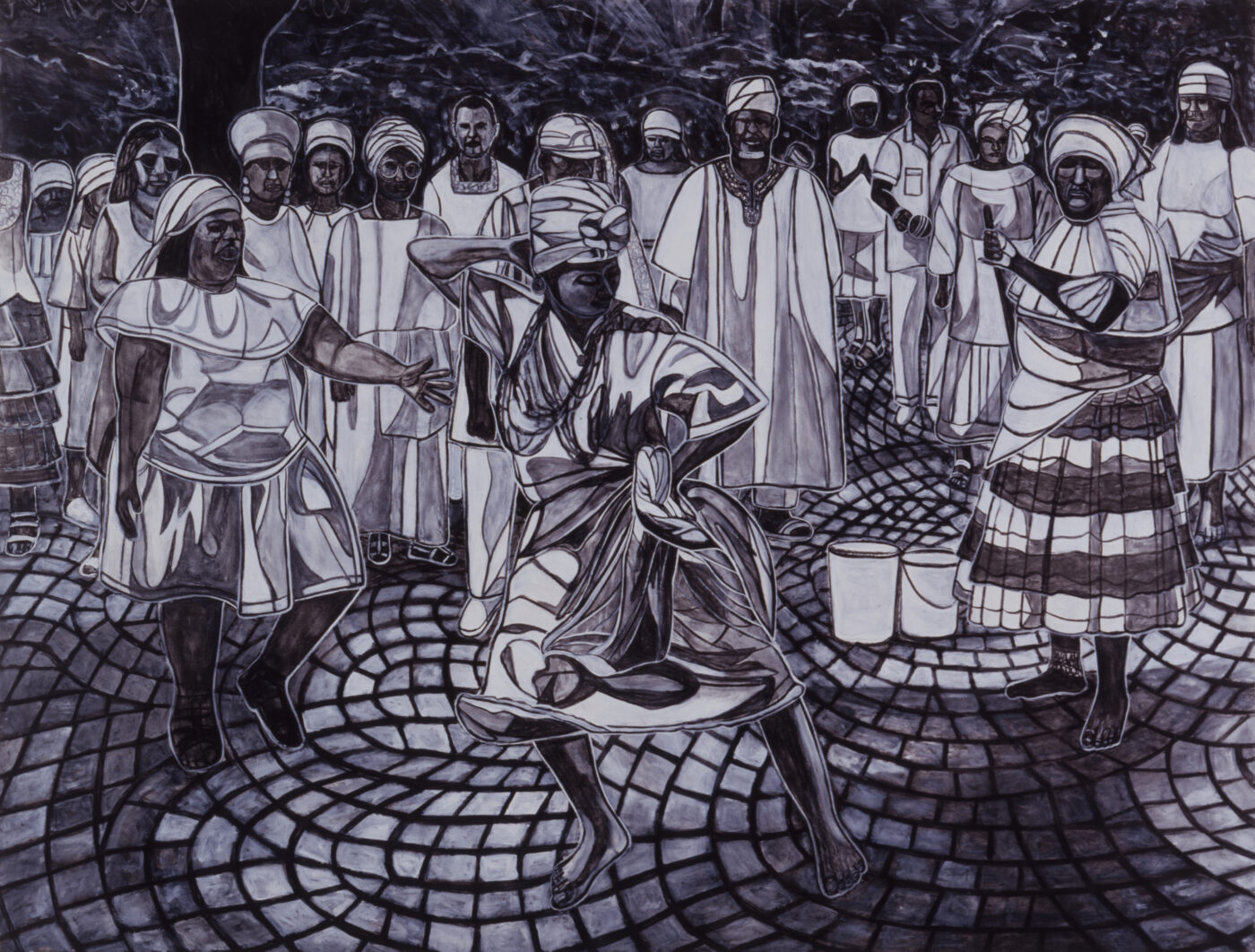
Willie Birch, Evoking the Orishas in Congo Square, 2003, charcoal and acrylic on paper, 72 × 96 inches. Courtesy of the artist.
Sg I went to second line last week. I hadn’t been to one in a while, and I was shocked.
KCOver in Tremé?
SgYeah, to see the floats. It’s like, Wait, are we going to see the steppers? (laughter) I was confused.
KCEverybody is on the float now.
SgI understand what you’re saying, Chandra, because things do change. You have hybrids and they evolve. That just felt different and off.
WBI just had a big argument with somebody about changing the name of the Sankofa. [Sankofa is an African concept meaning we should retrieve things of value from our knowledge of the past.] They put Sankofa into another category. And I said, You don’t get it. You just moved here, and you could do what you want, but I’m just telling you. And before that, we had this thing about the history of the African burial ritual. Outsiders don’t understand why we celebrate that, but we do now because we couldn’t before. When I meet people who don’t know, I tell them where the historical tradition comes from. And then if you still want to go and shake your booty at somebody who’s dead that you don’t even know, then you do that.
RBI guess we have so many examples of that. We went out to the Oshun Festival, and they had the Oshun parade. I’m going, Where’s Oshun? (laughter)
CMWell, what was that we were recently at at Armstrong Park? They had the Tanzanian people there with the peanuts.
RBThat’s it. How do we let those kind of things happen?
WBYour photographs maintain the lifestyle. What we used to do is dead. So, it’s a record of the past.
KCRight.
WBAnd if we do it right, it is going to stand in when somebody starts talking about what it is. And then they see what it was. They’ll see my brother. They’ll see me. Then, they’ll have to come up with another understanding.
SgThis is not dead. We’re talking about Blackness. The dead and the living are the same.
RBHe’s just talking about the event.
WB(laughter) I hear you, Shana. I told you before this is what I’m learning to really respect about you: You will push back. And I like to be able to explain. I got this buddy who I’ve been talking to for twenty-five years and I like that we tell each other when we’re wrong. We can give each other the right to do that because we want each other to have the best representation and appearance. We can do this and still be friends.
Everything is built into what our ancestors have given us as a model. So, I’m saying to my sister, I hear you—those folks who have no idea and don’t really care about what Congo Square represents. That’s on them.
SgWe have to make sure that we engage in the past so that the present and future become one and the same, the ways in which we survive have not always looked good. So, we cannot paint a different picture, a romanticized version of who we are or who we want to become.
Nor should we pretend that when our parents say, We’re from kings and queens. Well, how did that work out for us? Not that well. If it was that great, how the hell did we get here?
RBAnd how’d those kingdoms come to be?
SgExactly. I’m like, I don’t need to be from a king or queen. I want to be pumped from the workers, the people who built the damn pyramids, not the people at the top.
WBIt all comes down to being human. See, they divide and conquer. And I fight that every day, every time.
SgHow do you do that in your work? For all of you, how do you address these issues in the work?
WBI just do what I need to do based on what I’m experiencing. That’s an abstract way somewhat.
SgNo, that’s fine.
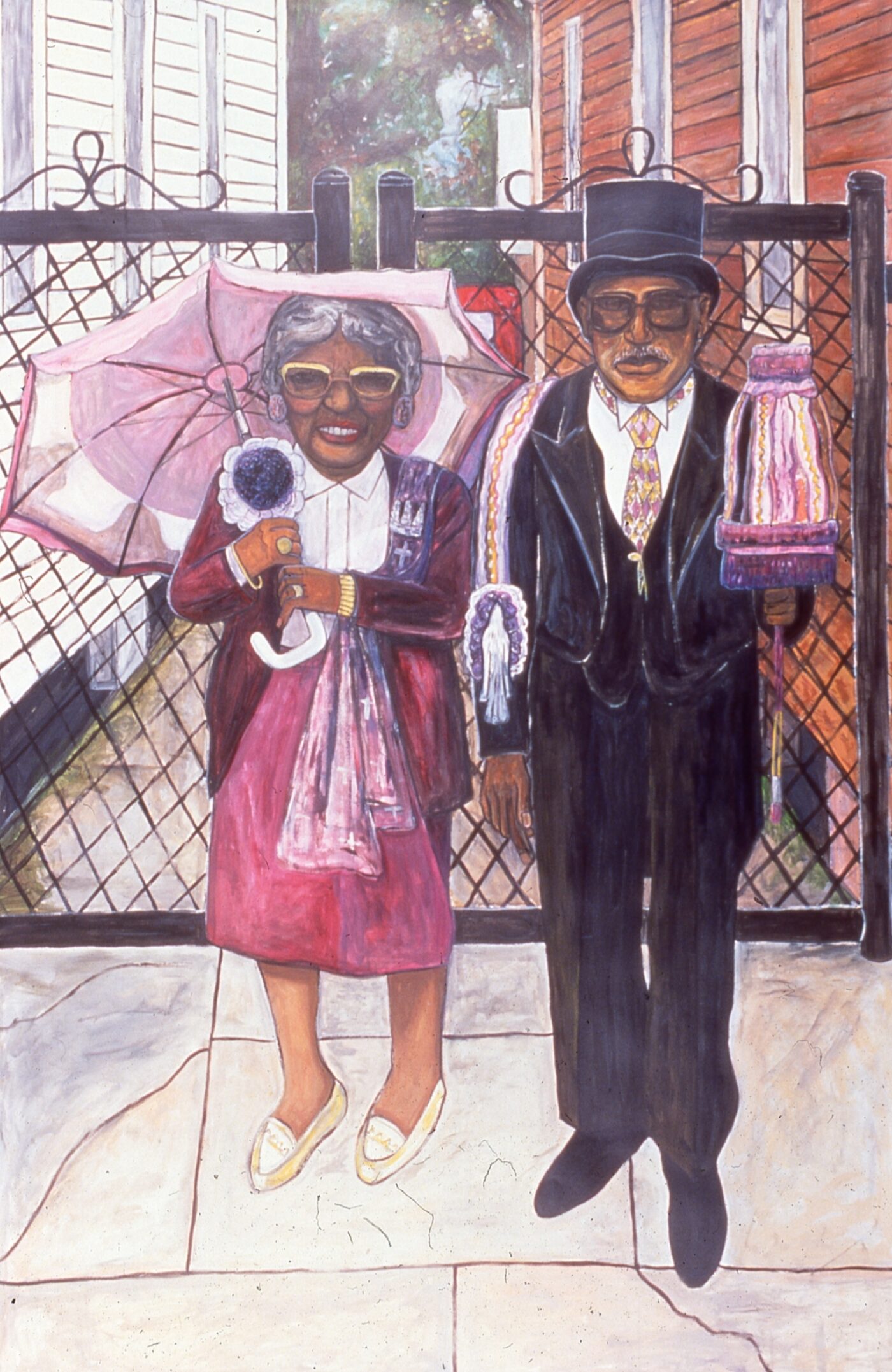
Willie Birch, Grand Marshals, 1997, charcoal and acrylic on paper, 92.25 × 60 inches. Courtesy of the artist.
WBThat’s how I do and what I do. I’m very conscious of telling the truth because that’s all I got in the world. I did a portrait of Tootie and Joyce as the Grand Marshals. When I was trying to figure out how I was going to render my figurative stuff, I chose them. I did it within what I call a Chagall-like cubist quality. The piece sold just like that. (snaps fingers.) And Tootie said, “That’s the ugliest thing I’ve ever seen in my life.” I tried to explain to him that it comes out of a tradition from when Russia colonized the Jewish people. And he said, I don’t care what you say, but that’s ugly. (laughter)
CMThat’s Tootie.
WBTootie was a Sagittarius. We’re both Sags. That’s part of our relationship. So, I said, “Tootie, I hear you.” I realized that if I decide to work like this, it ain’t going to work for Black folks because they need something that is more representational of who they are. Now, how can I do this without compromising what I have to do as a creative force? You say you’re not supposed to compromise, but there’s a way that you make these adjustments. Where you do not compromise the integrity of the piece, instead you compromise the process. But I got all these different ways of doing that.
SgYou’re saying he didn’t see Black in that piece.
WBHe didn’t see enough of it in that style. I had a moment like that, too. I went back to the first time I saw Romare Bearden collages. They offended me because they were people cut up with imagery of slavery. I started trying to figure out why this light-skinned Black dude would do this. When I discovered cubism, I understood Bearden’s pieces and then it became very beautiful. Because there was more than one layer in that work. It was the layering. But, at the same time, there was a layer of a sentimentality so that anybody with a tutored eye could embrace these pieces. I saw that these collages were about ritual, about everything else that I wanted to see.
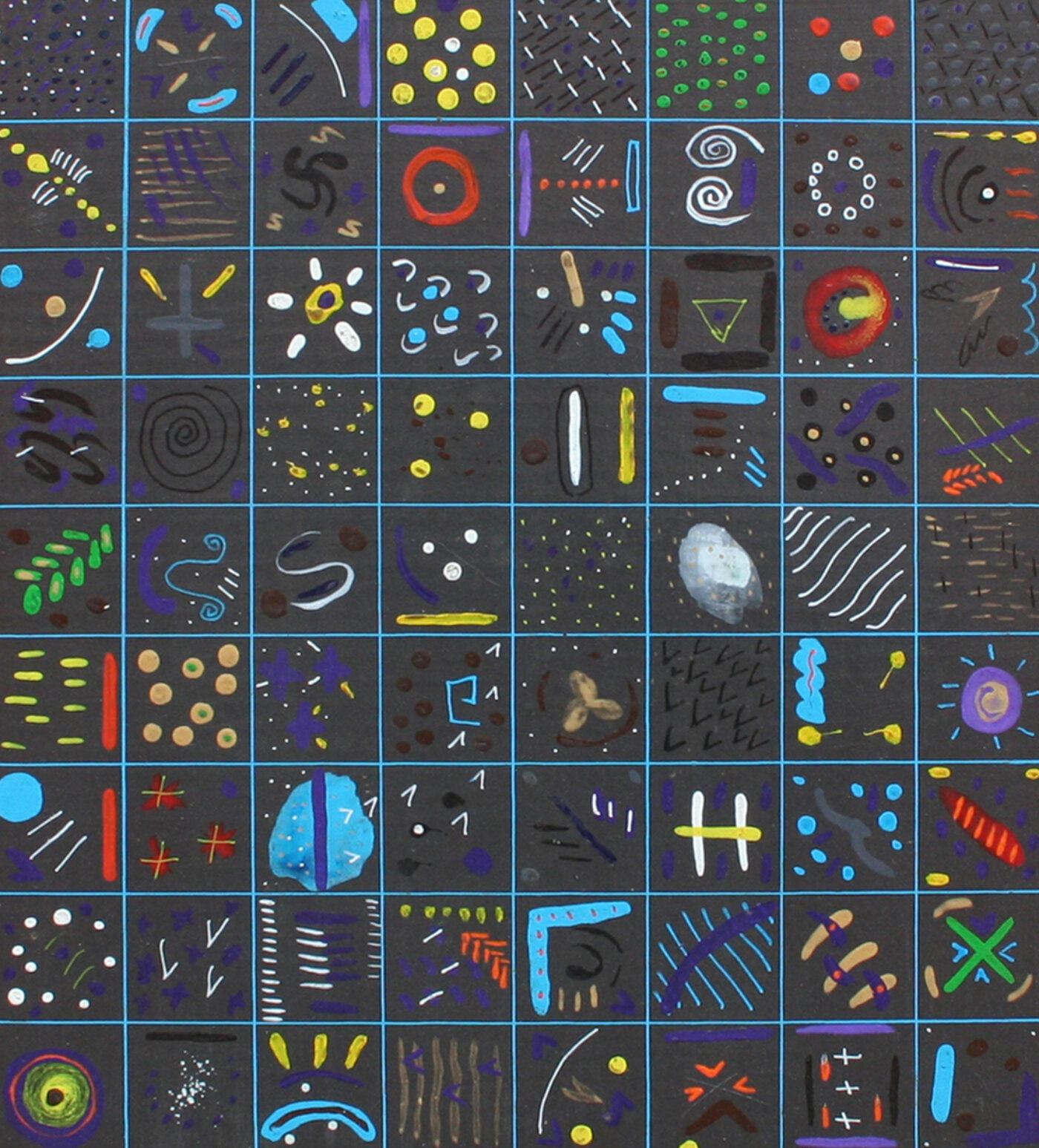
Willie Birch, New York City Jazz Series #4, 1977-78, acrylic on cardboard, 21.75 × 20 inches. Courtesy of the artist.
SgI’m thinking about Spike Lee’s film, Mo Better Blues. There was this moment when Denzel Washington’s character and Wesley Snipes’ character are going back and forth. Denzel’s character wants to play “pure” jazz, and Wesley’s character is playing other stuff. But the people are coming to Wesley’s character’s shows. He says, If you want them to want what you have to play, you got to play what they want to hear. How do you take your audience along with you? A lot of Black folks struggle with abstract work.
So how do we—and maybe this is what you’re hinting at—give them what they want so they can want what you have to give? What is that relationship?
WBY’all know I like progressive music. I’ve really enjoyed what many people talk about as noise. Ornette Coleman was scared because his music wasn’t as melodic as his earlier music was. In an interview he said, Man, I don’t know about this stuff. And I said, Brother, sometimes you have to take yourself out of this New Orleans context and put yourself in a broader world. By doing that, you begin seeing that there are other ways to tell the same story. You may find you can reinvent yourself. We didn’t talk after that. But that was the beauty of being in New York.
SgBut you didn’t have to take yourself out of a New Orleans context to engage in New Orleans’ story of music in a different way. How do y’all do that in your work–maintain what you’re interested in and also engage people who are not art folks?
KCI think you just go through your heart; I just go out and make work. I don’t worry about that relationship. I’m working in the outer parishes, documenting where the lumberjack men used to be before they cut all the pine down and then took out the earth. So, we found older people who were part of that transition. But I’m not going to wait on anybody to give me a grant. I know I need to go do it. That’s the beauty of all of us in this room. Ron’s been doing his work for years, but he stays very sellable. He’s constantly putting out work for the grandchildren. I’m pulling up stuff forty years ago that I took for granted. Now it’s gold to me. I have about fifty hard drives so ten years from now, it’s going to be here. Willie and I, we’ll be gone. But there are going to be children one day that might say, This is where Willie Birch did this work. So, when you make it work, it’ll find its way into the universe.
WBThank you.
KCBut me and Chandra never had a gallery. There was no telling who might pull up to my old raggedy house in the Ninth Ward. People would say, Oh that’s Robert De Niro going in there. I had George Soros come. Came right here in the Ninth. I was like, Well, look at all the bodyguards here today. You never know when you create energy. That’s what I tell Black audiences. Willie took all this dead space and made energy here. A lot of times we don’t see what’s around us. People ask, When y’all going to move on to Eastover or somewhere?
CMThe East just doesn’t have a lot of character.
RBIt’s like Houston.
KCSome of the best artists I have met in this city, Martin Payton and all these guys, they’re never worried about commercial success. Willie, you’ve been the same since you came back from New York. You would go down to Canal Street on your bike and shoot. Now all that’s gone.
WBOh, yeah. I’d shoot the preacher who used to be out there every day with umbrellas and a bible.
KCHe used to have an umbrella.
CMOn his head.
SgI remember him. Is he still out there?
RBHe’s got to be ninety-six.
SgI would see him all the time and one day–it was so hot–I got him a drink. I said, Here, I got some for you. And after that, every time he would see me, he would speak to me.
WBI loved that brother. The symbolism was right in your face. It was beautiful.
People sometimes want to buy something that is already considered a success, but it was also important to show less known folks, like Fred Johnson. Fred Johnson was important. I did a show called On the Black Male. It must have been about twenty pieces. The problem was white folks walked in the gallery and then back out. They didn’t want it. I wish I’d had a videographer standing there just taping these folks because my work was taking them to a place they had a hard time processing. It took about four years for me to sell any of those pieces. Now they’re hot. Sometimes you have to wait, and you just move on, and it will all happen. You just got to be patient.
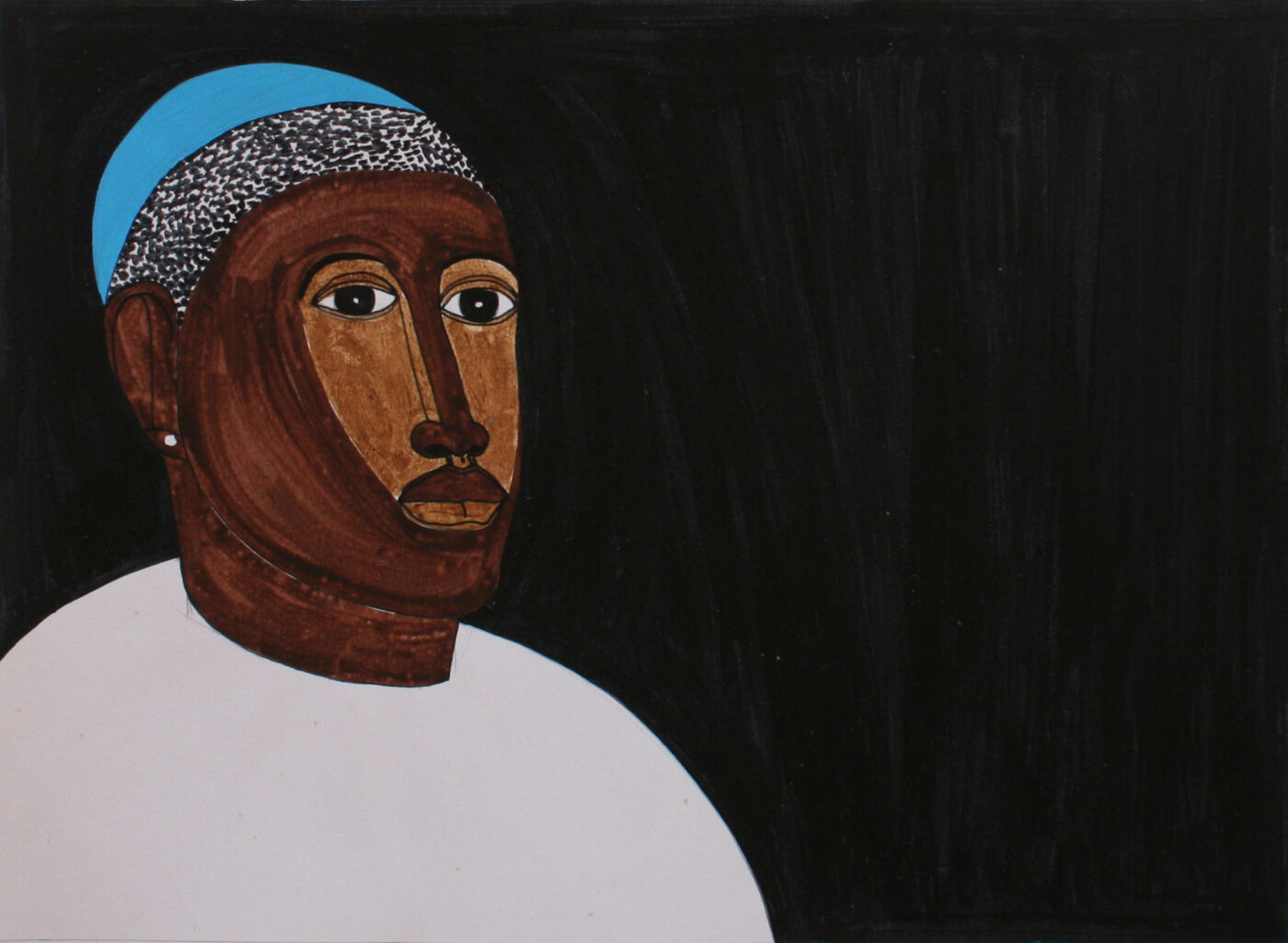
Willie Birch, Portrait #5, 1982, acrylic on paper, 16 × 21.5 inches. Courtesy of the artist.
RBWell, when you speak to why you make the art, you also think about who you’re making it for. Who’s your audience? How do you stay true to yourself? The honesty that Willie brings, how do you shift it to the audience that you’re trying to serve? That becomes a significant factor in what it looks like and how you layer it. How you make those forms into something that becomes meaningful for the long haul. We often get caught up in the moment and forget about why we’re making it. Like Keith said, I’m thinking about my grandchildren when I’m making a piece now.
WBThe best work is always layered. That’s something I tell myself when I’m creating. Different people are going to approach the work on different levels depending on what they know to look for. Mr. Bearden talked about Chinese art. It could be read left or right but it allows the eye to go back. Then, the whole brings it back around and then you re-enter the piece. See, these things are not new, but we have had the opportunity to study and learn. Now that’s not a Western thing; that’s Asian painting. The point is that I will use all of that. (laughter)
KCWillie’s mixing all that in.
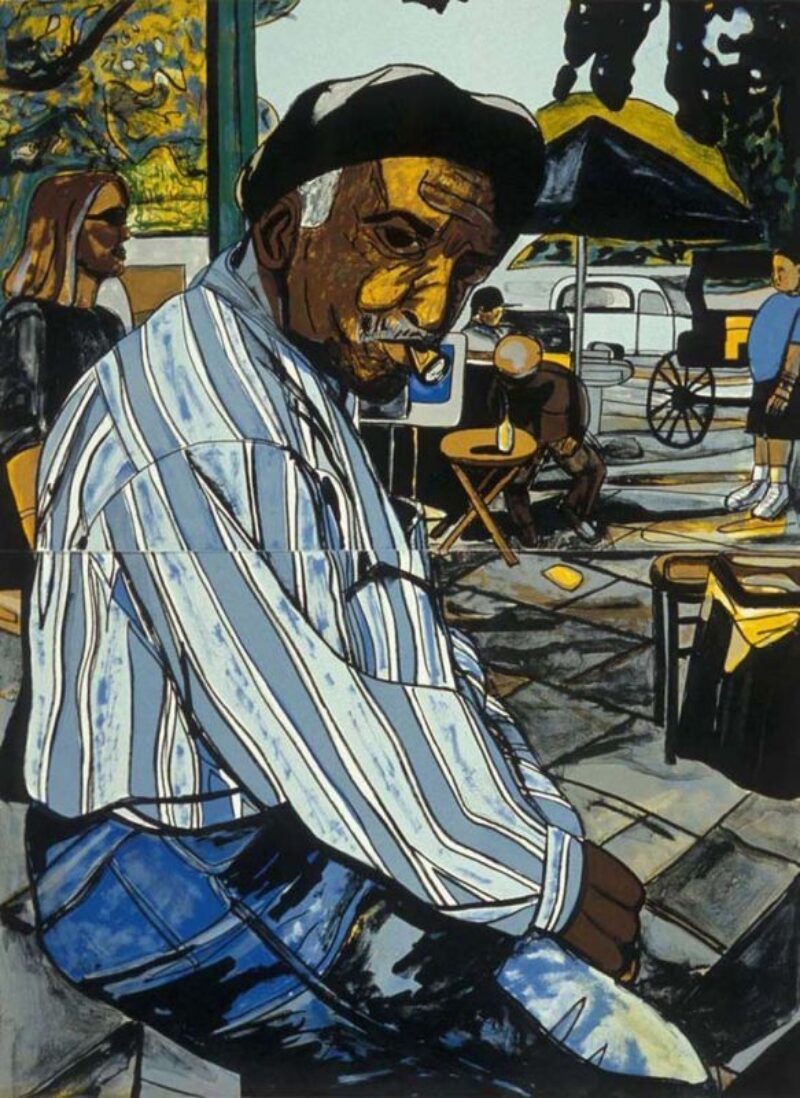
Willie Birch, Big Man with Cigar, 2000, 10-color lithograph, 50 × 36.5 inches. Courtesy of the artist.
CMLike gumbo.
WBYeah, right. It’s a gumbo. It’s a gumbo. So, that’s the experience that we’re trying to bring. Chandra and Keith do this. Keith is a brilliant photographer. Chandra figures out how to look through the viewer. She captures something unexpected.
RBThe way she crops.
WBVisually, it’s always incredible. And I love Keith’s photography. I got one of the sugarcane ones.
SgHe’s trying to claim a lot of Chandra’s work.
WBOh, you’re getting bad now. (laughter)
CMWe shoot the same thing sometimes. Early on, it would be a conflict. We’d be like, That’s mine. I processed the film and all that and he says, That’s a Keith Calhoun. (laughter) So, I had to start taking pictures of him shooting and he’d take pictures of me. Or, when I start my roll, I go pop and shoot myself. It was funny. (laughter)
SgHe said that’s a Keith Calhoun right there. (laughter)
KCLet me tell you how Chandra used to do me at the second line. I thought I bought a whole brick of film. So, I looked in my bag and I only have about three rolls. Then, I checked her bag and she’s got like ten.
CMWell, let them know about who was carrying everything.
KCShe was stealing all my film, and then she stole the best camera.
WBThis is the real deal, you and I know.
CMWe’d get home and look at what we shot and say, That’s something. (laughter) And I’d say, Oh yeah, I shot that. If I brought you, I’d say, Hey, we’re going to shoot this. Then that’s mine.
WBI don’t know if it’s true or not, but Chandra comes out of Keith to a large degree. So, let’s call it like it is.
CMI don’t take that from him.
WBBut I do know that y’all are different. There’s a softness in the way you light, Chandra. We study this stuff religiously. (laughter)
RBDid you see her show? Oh, man.
WBThat was a monster.
KC Let me tell you about, Chandra. They got Chandra a whole dang hook up at Seeing Black. You know, you don’t think I’d be hearing things, but it’s like they got Chandra. I’m checking her out.
SgOkay so let’s keep talking. Whether it’s the art world or society writ large, Black women experience the same rate of violence as Black men.
KCIn some cases, more.
SgIn society and the art world, we still have a long way to go when it comes to people of color and especially women of color. Even with this project that Chandra is in, Seeing Black, we might be at ninety photographers. And of that ninety, we have about thirty or thirty-six that’re women.
KCReally?
SgThat’s a good number, but that’s also—
CM—not even.
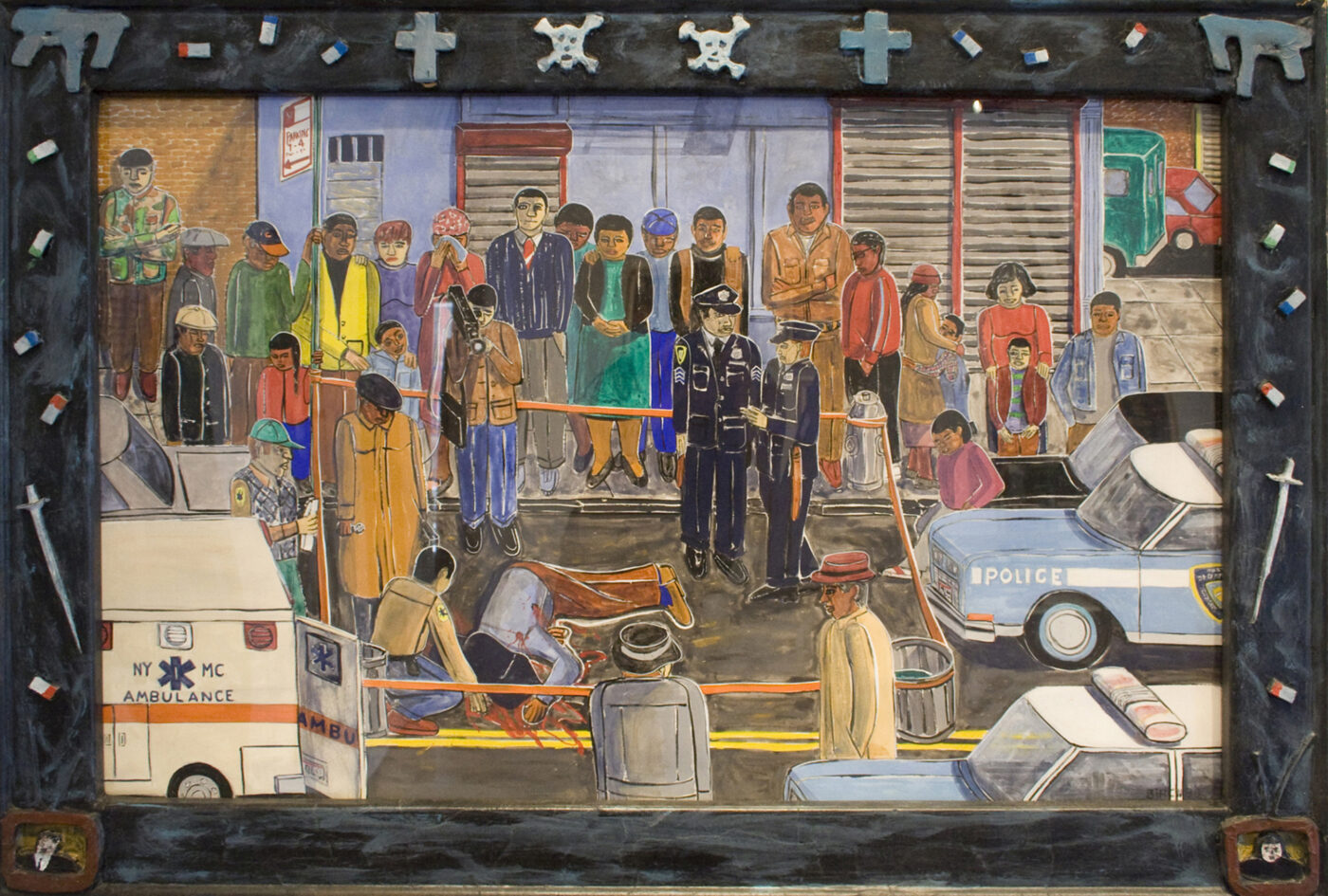
Willie Birch, Johnny Makes the Nightly News, 1988, gouache on paper with papier mâché frame, 32 × 46 inches. Courtesy of the artist.
WBHow long have we been here?
CMWe’re almost at four hours. (laughter) Let’s go for six. Ming Smith.
WBI’ve been knowing Ming Smith since the late ’70s from New York. She has always been a great photographer and can hold her own with any of her peers.
Remember that show that that dude did at NOMA, the Black photographer?
SgOh, Dawoud Bey.
WB The curator, Bill Fagaly, happened to be white, but he was knowledgeable about brilliant African American artists.
KCOh yeah.
WBThat’s an incredible show, I go all the way back to seeing Jules Lion at the Louisiana State Museum on Royal Street in the French Quarter in the ’50s. Miss Daniels had sent me to see this show of his photographs. That’s the first time I saw Jules Lion. But who he had photographed! John Audubon, the bird man, he photographed all these people.
SgYou know he is supposed to be Black?
CMYeah, yeah. Yes, technically.
WBThat’s not what I heard.
RBPart of the controversy.
SgIt appears that he brought photography to New Orleans [from Paris, where he was born]. That’s uncontested. His identity as a person of African descent is highly contested. It is very likely that he was more a person of Jewish descent.
WBOkay, well, if he Jewish, he Black too. (laughter)
SgWell, his photography is beautiful. But there are less than ten images that depict people of African descent in his vast 2000 pieces of work.
WBI don’t know. All I know is, I went to see the show, and I saw a portrait of the African American novelist from Georgia named Frank Yerby. He was the first Black writer, I believe, to write Black people as a protagonist, that I ever read in my life.
SgWhat was the book?
WBI’ve read about three of his books now. I got those books from the Black Library on Dryades Street. This is in the ’50s.
SgJules Lion was born in Paris, not in New Orleans. Just so you know.
WBOkay, I missed that. The point here is that there are a lot of these folks for whatever reason, they Mama or Daddy didn’t want them to be a person of color. Well, we’ll wait and see how that shakes out because as far as I know, Jules Lion was said to be an African American—
SgYeah, a free person of color.
KCBack then being Black wasn’t popular to most of the Creole people—
WBSo, anyway. Whatever it is, we are claiming—
SgNo, you can’t claim him. (laughter) You can’t claim him right now.
WBRight now, Willie is going to claim him because I grew up with him. I’m going to have to repeat?
SgI’m listening.
WBI saw the Akhenaten and Nefertiti show at the Brooklyn Museum in 1972. I believe the story has changed, but anyway, Queen Tiye was Tutankhamun’s grandmother. It changed my understanding of who the Egyptians were. There is a head of her carved in a black stone. So, things change as information moves forward.
SgMy next question: What advice would you give to young artists coming up now? And it doesn’t matter what they choose to do, whether they choose figurative, abstract, or whatever. What advice could you give them to take with them through life, to get started in the field?
WBThe most important thing is to study your craft. Somebody decided what would be the standard so that becomes debatable in terms of what’s good and what’s bad. But the most important thing is study as much as you can and be open to understanding what you want to do.
SgGood, Professor, okay. (laughter) You have a question, Keith? Ron?
KCOkay. My question, for a lot of artists working who don’t have galleries, who haven’t got exposure in the museums and galleries, what do you recommend for them to keep their spirit going? Like when you showed with Arthur Roger Gallery here in New Orleans, there wasn’t many Black artists being shown.
WBI turned down Arthur in the ’80s because I felt my work didn’t fit into what his gallery was selling, and I was more interested in refining my voice. But when Arthur opened his gallery in New York in the ’90s, he sent this beautiful letter of his appreciation of what I did. He still had the gallery in New Orleans and that could work, having representation in New York and New Orleans. Choosing gallery representation is tricky. You have to ask others who know the gallery owner. And go from there. There is no one way to decide what can work for you. In the end, write up a contract.
SgAbout advice to young people.
WBOh young? Yeah, just go to shows. See, we don’t go to shows enough. Go. Go and look at the real stuff instead of looking at photographs of it. You two understand, photography flattens everything out. Some people may be very talented having skills, but they may not have anything to say. Some people are just natural, but most people aren’t. You have to study and then you become natural at what you’re doing. You have to practice. I cannot tell you how many hands and feet I’ve drawn before I even decided to pick up a paintbrush—that was the beauty of Ms. Daniels. And then with Eddie Jack Jordan at SUNO.
CMDidn’t he deal in sculpture?
WBSculpture. Yes, Ms. Daniels taught us composition, proportions, perspective, contrast, spacing. All part of learning the craft of how you make things we see. We had to draw so many hands, then went and drew so many self-portraits. I find that most young people, when they initially see their own drawings created totally out of their intuition, there’s a problem sometimes in liking it because it’s too close. It doesn’t remind you of some master that you’ve seen. But once you start reading and working at that, you begin to like your own mind, your own mark. And once you find your own mark, man, nobody can make a mark like you. And once you begin to understand that, then you put that to practice. Because people will look and know that’s a Keith Calhoun photograph. That’s a Chandra McCormick. Because of the nature—none of us see the same.
KCThat’s true. All right.
SgThe gallery, Arthur Roger, can you just share with us—
WBYeah, I joined Arthur in 1992 when he decided to open a gallery in New York, but also kept his gallery in New Orleans. Arthur knew about me since I had donated a piece to NOMA in ’75. I remember Bill Fagaly suggesting I go up Magazine Street and look at Arthur’s gallery; I walked in and said, This brother ain’t ready for me, and got on the plane and went back to New York. But they never forgot that. (laughter) Who would? So, eventually we did hook up. He made a studio visit in New York and still didn’t know what to do with the work but his assistant, who was from New York, said, I think you need to give this brother a show right now. And he took that advice and I got my second New York Times critique in four months, which is unusual. But I had that show with him and just blew everything out.
SgYou were represented by Arthur from ’92 to when?
WBI was represented by Arthur until we fell out around 2016 or 2017. We were getting ready to have a show with Lin Emery who was one of my mentors. I loved the kinetic aspect of what Lin was doing. Plus, she was one of my big supporters in New York and I didn’t even know her then. But what happened was Lin and I were having this two-person show, mentor and mentee. I wanted to tell this story in one of my pieces: Something happened when I was on Veterans Highway. This dude pulled in front of me in this pickup truck; he had this gun rack in the back. He had Nazi symbols all over. I called the piece that I made from that experience The Landscape of Fear. So, when Arthur came over, I said, That’s the piece I want on the cover. (laughter) And Arthur said, I want to choose. I said, No, man, we don’t have that kind of agreement. So eventually there were threats made and as Ron knows, I mean what I say.
RBIt was the end of the show. The show was called off.
WBWe called off the whole thing. It was time. There were some other incidents because museums were coming after me then and that made my prices go up. Arthur was having a problem with my prices. Galleries try to control the artists’ prices.
SgHe should have supported your transition.
WBWell, that was the end of that. And then I did what I had to do and just worked.
SgSo that’s like twenty-five years he showed you?
WBYeah. We placed a lot of work. And then when was the museum show?
RBThat was what, 2018?
WBYeah, it was the next year. The 300 Year Show at NOMA. Arthur Roger still tried to be a nice guy at the end of the day. I just no longer showed at his gallery. So anyway, we made a clean split, and he returned my work. I got two galleries after that. One in LA and one in New York. Well, I’m still with the one in New York. Now, forty years ago, certain high-powered gallerists came to offer me to be in their gallery after being an artist-in-residence at the Studio Museum in 1978.
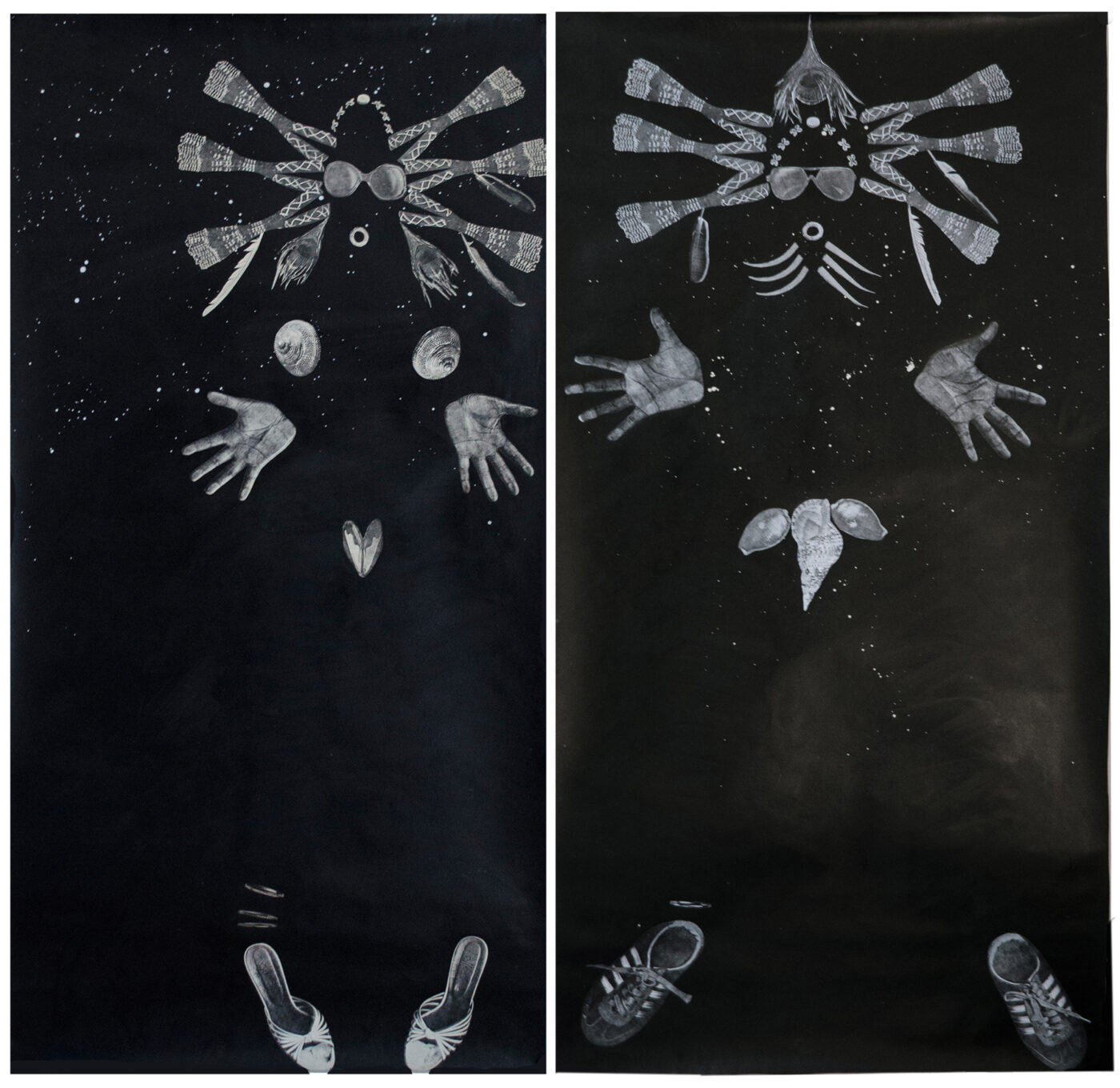
Willie Birch, Voodoo Series #1, 1978, xerox collage, acrylic, and graphite on black Fabriano paper, 71 × 71.5 inches. Courtesy of the artist.
What happened was that I had this show and the trustees of Studio Museum expected me to continue to do what I was doing, these collages about Black folk and stuff. And I said, Look man, I’m not ready for a gallery because I’m still developing what I’m doing. The nature of New York then was such that once you do something, that’s what you do. But they were looking at making money. And I’m saying that’s not where I am. So, there was a point where people at the Studio Museum said we’re going to run you out of New York. (laughter) Ron knows all about this.
RBYeah. There’s a piece around the corner over there.
WBYeah, there’s a piece right there. I did a show outside the Studio Museum called For Those Who Wear Rose Colored Glasses. I borrowed underwear from all of our friends, and we made masks. And then we had the show. And they said, Man, you too much for us. (laughter) So, that’s just part of it, the practice.
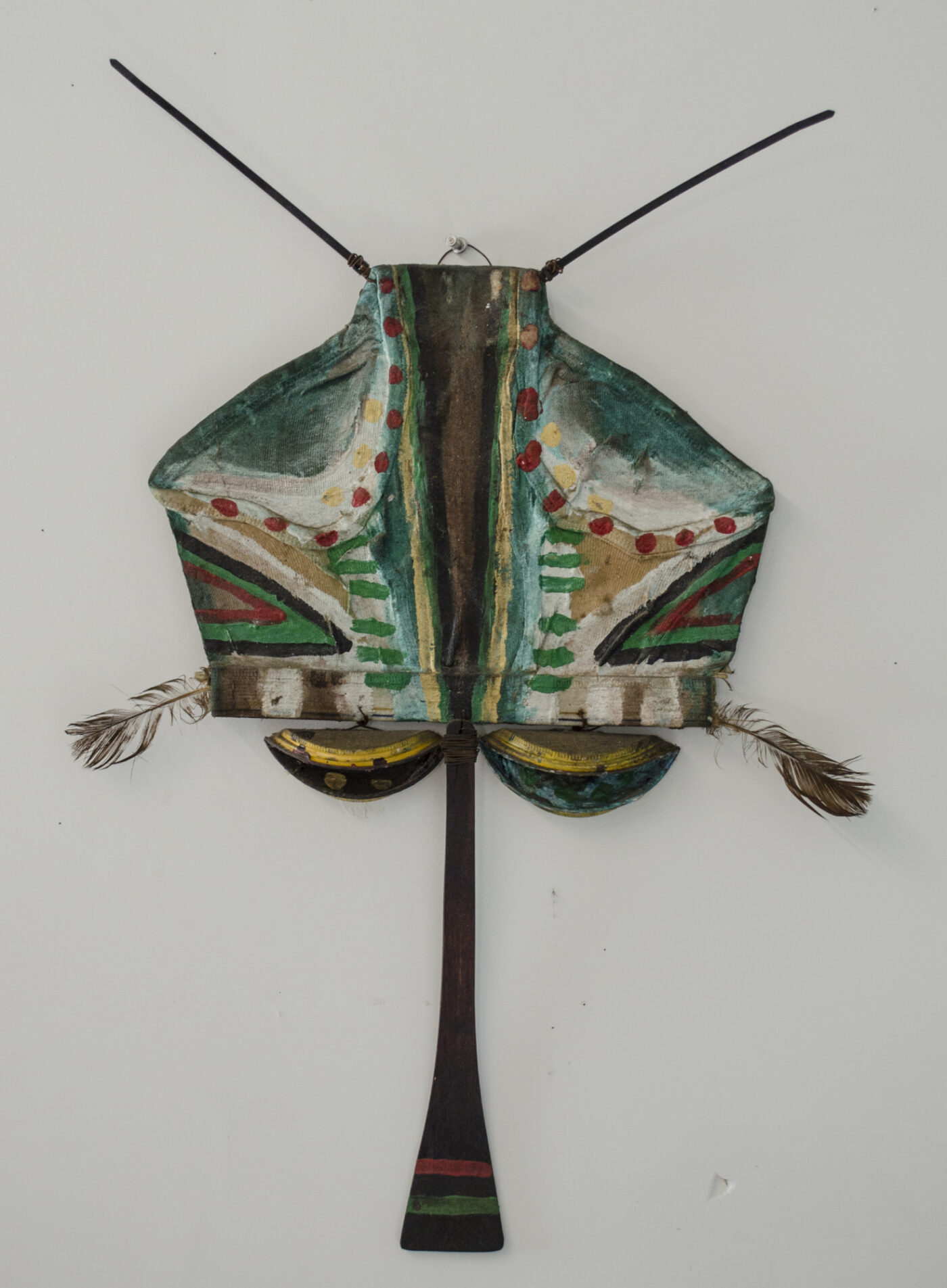
Willie Birch, For Those Who Wear Rose Colored Glasses, ca. 1978, mixed media, 27 × 18 × 2 inches. Courtesy of the artist.
RBWhat makes you able to have a filter to decipher… bullshit? How do you stay focused?
WBI just trust what I see. And the experience in this neighborhood has been incredible. Just to watch people, to watch what’s possible. At the same time, when I showed at NOMA, that was really important for a lot of people, including myself, in this neighborhood. I forced NOMA to do a panel of four people from this neighborhood. I said, You’re going to pay ’em, you’re going to feed ’em, and then you bring them home. So, they don’t have the cost of transportation. I decided that I wasn’t going to go to the panel because I wanted them to tell the truth about what they think about me moving into the neighborhood and all. And today people still talk about that. That’s the kind of stuff that I want to do. See, that’s the kind of stuff that builds a history for most of the people who have never been to NOMA. That’s how we will create another context. I’m sure it’s not the last time we’re going to do it because poor people don’t come to openings. Like Ron says, I will wear my overalls to an opening because this reminds me of everyday people. It’s symbolic, yeah, but that’s who I am and that’s what keeps me motivated.
And I take snapshots instead of me walking around with the sketch pad, you know? We’re in that time frame. It’s a faster time. I got to move fast.
CMBecause there’s so many mediums, right—
WBYeah, that. Acrylic forces me to work quicker because of the drying time. With oil, you can let it sit there for days and then go back. I learned certain techniques from living in Holland and understanding glazing. But then I reached the point where that’s not what I wanted to do. And getting back with just acrylic was not respectable in the ’60s. So, as times change, people change. That’s what I’m saying. So, you just keep that in mind. Now acrylic is okay, and we think that it’s always been that way. It wasn’t.
RBIt’s similar to the idea of a hierarchy in the arts. Painting is at the top, then sculpture.
CMI remember when they didn’t consider photography as fine art.
WBBut who defines art? Who in the hell are you to tell me what art is, right?
RBYeah, so what is it that causes you to stay focused on your principles?
WBI’m sure that’s my family. My grandfather. My mother was one too.
SgGrandfather on which side?
WBThat’s my mother’s side.
SgBertrandville?
WBBertrandville. My grandfather walked between white dudes and with a shotgun, he and his buddies, because they were getting ready to hang my oldest uncle. That’s the legend. I don’t know how many people are still alive from then, maybe one or two people, but they claim that my grandfather said, I guess we all going to die here today.
CMAnd he is copping that gun.
WBThey cut my uncle down. Then he moved to New Orleans. My grandad was a bad dude. Yeah, that was Dan Poindexter. And my daddy was Wilson Birch. I look like my mom and her people.
CMYou look just like your mom.
WBI was Little or Lil’ Poindexter most of my life.
CMYou know how they usually say, Oh boy, I could tell that’s your daddy, look like he spit you out. His mom spit him out.
WBMy uncle was a teacher and preacher in Bertrandville, which is in Plaquemines Parish. The brother who they sent to New Orleans had a railroad car called the Brass Rail which I couldn’t go to because I wasn’t old enough. So, I come from people like that. And my daddy was a longshoreman. I remember my uncle building his own house with the barroom attached.
KCListen, more than an interview, just to come hang out with Ron and Willie. It’s a great inspiration for us. Because everybody doing their thing and it’s like now, since COVID, we don’t come together like we used to. So, making this time because we might not get this time again, we’re blessed to be here. Hopefully this can fuel or create a platform. Again, we were doing this type of talking before COVID.
SgAnd how can the talk be not just a talk but more of an exhibition of the work? Bring the conversation together.
KCThat’s what I was saying. To build a collective—how can we make all this work come together without depending on NOMA or anybody else?
SgWhere we control the narrative and as you just described with the panel at NOMA, we control the terms of conditions.
RBWell, again, we always have this conversation.
WBThis is every Sunday.
RBWillie and I touch base every Sunday. But it’s a pleasure and it’s an honor to be able to sit down and have this kind of conversation with people that I love and trust.
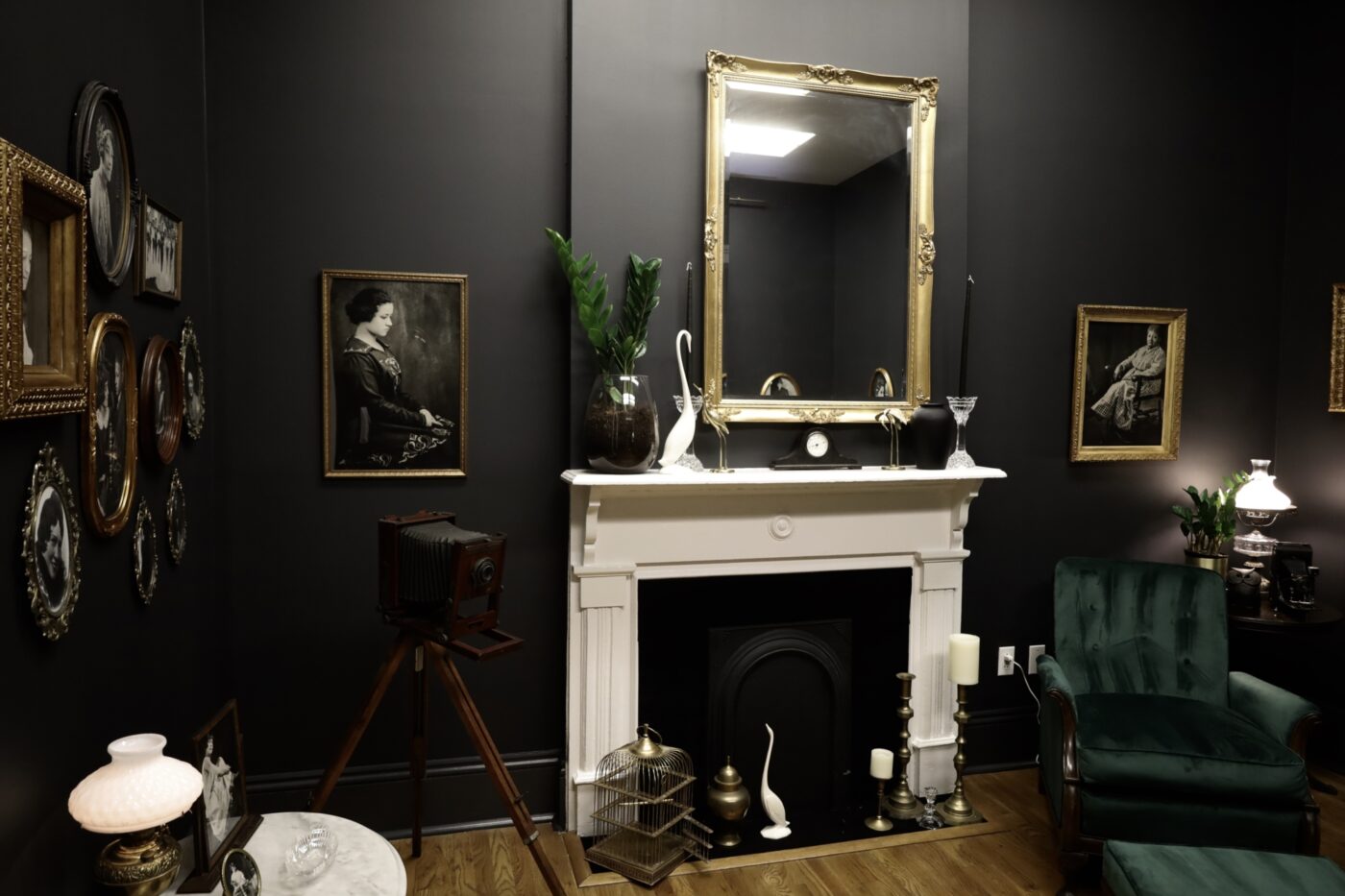
Gallery view of First Frame, curated by Shana M. griffin, 2022-23, New Orleans African American Museum, New Orleans, LA.
SgAlright, so Keith and Chandra have a copy, but this is called The Crescent City Pictorial. It was published in 1925. One of the photographers is Florestine Perrault Collins. But the primary photographer is Villard Paddio; he’s credited at the back. Florestine was primarily a studio photographer, and this is a testament of some of her outdoor images. But she worked under Paddio, and she’s not credited. That was the time period—a lot of photographers worked under him and even though he didn’t take the picture, he would take the credit.
This popular saying is quoted on the cover: “America’s most interesting city.” Mr. Birch and all three of you could live anywhere in this country. You chose to come back home and Ron you chose to stay home. After Hurricane Katrina, you all chose to stay home and to invest in this community. Why? And Keith and Chandra, as photographers who’ve shown in Venice, in Prospect, all kinds of exhibitions, you’ve said people ask why y’all are still in the Lower Ninth Ward.
KCYou can give me a place up in them Hollywood Hills, right now.
SgCan all of you speak briefly to why New Orleans is still home? On the back cover of this souvenir book is another quote. Mr. Birch, if you can read that quote.
WB“I’m glad I live in New Orleans.”
SgThat’s the conversation we’re having today about the sense of place. The textures, the swag, the rhythm, the sounds, the practice, the reflection of memory. “I’m glad I live in New Orleans”—that’s serious.
WBI think that the more things change, the more they stay the same.
KCI’ll go to many other places, but ain’t nothing like home in New Orleans. I’ve been fortunate to be able to maintain a base here after Katrina. Seeing how disaster capitalism moved a lot of us out. Most of the artists I know live in a one-bedroom paying $1300 a month now. So, to be able to still have a place here, I don’t know, I need that check from BOMB because I got to pay taxes. (laughter) But I’m fortunate to be able to see the change in the city and document it and say, This is what I remember. And people like Tootie, and Ron and them, they keep us here. We got a little juju working down here. And it helps us keep going.
CMI love New Orleans. I love living here. I love working here, A lot of what I love here is the people. We’re very colorful, we are rhythmic and musical. I know that I could probably live other places and sometimes I have a love-hate for New Orleans. You know what? Let me go try somewhere else and see what’s going on. But it’s only just for a visit. Because when I get wherever, I love to come back.
SgRon? RBWell, I’ve lived in other places and it’s the only place that really feeds my soul. That’s all I could say.

Willie Birch, The Wedding (The Couple Jump the Broom), 2001, charcoal and acrylic on paper, 78 × 66 inches. Courtesy of the artist.
Willie Birch with Shana M. griffin: May 1, 2023.
Willie BirchI’m trusting you. Let’s not miss anything I got to say, all right?
First, I’m honored that BOMB decided that I have something to offer in terms of their magazine. That’s very important to me. And I hope that we can say some things that give other people who are interested in culture and the artmaking process some sense of how they want to play or how they already play as visual artists. And yet,
I don’t limit my perspective to visual artists. I feel that as cultural agents, we can run the gamut.
I went to see a commemorative memorial for Kidd Jordan that documents his funeral procession. Edward “Kidd” Jordan is one of the finest avant-garde musicians in New Orleans. I happen to have met him in New York City through a friend of mine, a fellow New Orleanian named Steve Cannon. This was when Kidd was playing in one of those progressive festivals with the New York bassist William Parker. I’d also known Parker because we were neighbors; we both lived on the Lower East Side. When I told Kidd I was moving back to New Orleans—this was after I got the Guggenheim Fellowship in 1993—he was very enthusiastic about it because he was still teaching at Southern University at New Orleans (SUNO) where visual artist Ron Bechet was head of the Art Department. Ron and I hit it off immediately after I moved back and settled in and began entertaining the thought that it might be a wonderful opportunity for me to engage with the students at SUNO. But back to Kidd. Kidd would always say nobody knew him in New Orleans, but outside of New Orleans, Kidd was a legend. I was able to get close to Kidd through Ron. Later, Ron and I came up with the idea of me doing a one-person exhibition at SUNO. The students there did not have an official gallery, and we just wanted to expose them to different ways of thinking and working. Ron took a regular classroom and painted it, and the classroom became a gallery exhibition of my work.
One day Ron called me, and he said, “Wow, man, Kidd just came to the show. Then he went back to his office, got his instrument, and played to your pieces. And here is a sheet of music that he wrote based upon what he got from your work. He said how honored he was because you two are soul brothers. He respects what you are trying to do.” Kidd’s response to my work made coming home that much more special to me because I knew I was returning to folks like Ron Bechet and Kidd Jordan who under- stood the cultural uniqueness of New Orleans. I could relate to them and push this whole idea of creating art as we lived it, or as Kidd called it, creative art. Being home allowed me to think about concepts, and how our work could challenge the art community to recognize that we weren’t trying to imitate other artists. We were going to make things that related to our experiences. Outside of John Scott, and, maybe, Martin Payton and Clifton Webb, you weren’t seeing that progressive mindset in New Orleans, reflecting who we are and pushing the whole paradigm of what we call American art.
Shana M. griffinI want to situate us in time with what you’re sharing about Kidd Jordan. I find it fascinating.
WBI moved back to New Orleans in 1994. I was supposed to come back in 1993 after receiving the Guggenheim Fellowship but I had committed myself to two other projects. One was an artist residency in Nairobi, Kenya where I was able to complete a body of work called The Nairobi Series. Then, in the summer of 1994, I became an artist-in-residence at the Skowhegan School of Painting and Sculpture. Skowhegan is a progressive summer art program where talented and knowledgeable artists and students are invited for nine weeks. I was nominated and chosen by my artist peers to be one of the artists-in-residence visiting instructors. This too was a total surprise. I did it but first, I had to figure out how to commit because I’d just got this Guggenheim and I was really ready to come back to New Orleans.
When I got back to New Orleans, I immediately connected with my mentor and life-long art teacher (Carrie) Maxine Holtry Daniels, and she offered to sell me one of her properties in the Seventh Ward. I had talked to a few people who said, Willie, I don’t know if you want to move over there. But I had done research and realized the great Mardi Indian Chief Allison “Tootie” Montana lived on the same street as one of the houses Ms. Daniels was offering, along with another Mardi Indian Chief named Ferdinand Bigard and a Mardi Indian group named The Spirit of Fi Yi Fi, led by their leader Victor Harris. I didn’t know much about this group at the time. Many of these great Mardi Indians were right there in this community. So, I chose the shotgun house with the eleven-foot ceilings because it was perfect for the work I would do.
The other thing was that one of my friends, a college classmate, was the principal at the A.P. Tureaud Elementary School in the neighborhood. When she heard that I was back home, she invited me to do a slideshow presentation at the school, which concluded with a second line through the neighborhood. Oh, guess who shows up at my slide presentation? Tootie Montana and his wife, Joyce. We immediately hit it off, especially when he learned he knew my cousins. Tootie visited my studio, and I visited his home, where his family allowed me to break bread with them. That began a relationship with long conversations, mostly about him not just being someone who made Mardi Indian costumes, but an artist. That relationship lasted until his death.
I had already known Keith Calhoun and Chandra McCormick. I met Chandra in Virginia on a panel to talk about the New Orleans that I grew up in and the New Orleans that she grew up in, which were very different. When I moved back home, we reconnected. I seemed to have returned here already having a group of people who were documenting and making imagery reflective of New Orleans. Eventually, I bought this house, which was easy to do, but I also felt that I should keep my place in New York. So, I did. But in 1997, I began to feel very comfortable back in the place of my birth, considering the neighborhood I was in because the Lower East Side was just as bad as this. I figured, if I can survive the Lower East Side, I’d damn sure survive the Seventh Ward. Plus, I had family in the Seventh Ward. The beauty of New Orleans is when you tell somebody who your momma is, they’ll start making connections, and then you become more comfortable because you realize that somebody’s got your back, especially if you think they think you’re doing something that positively reflects their cultural experiences.
SgMm-hmm.
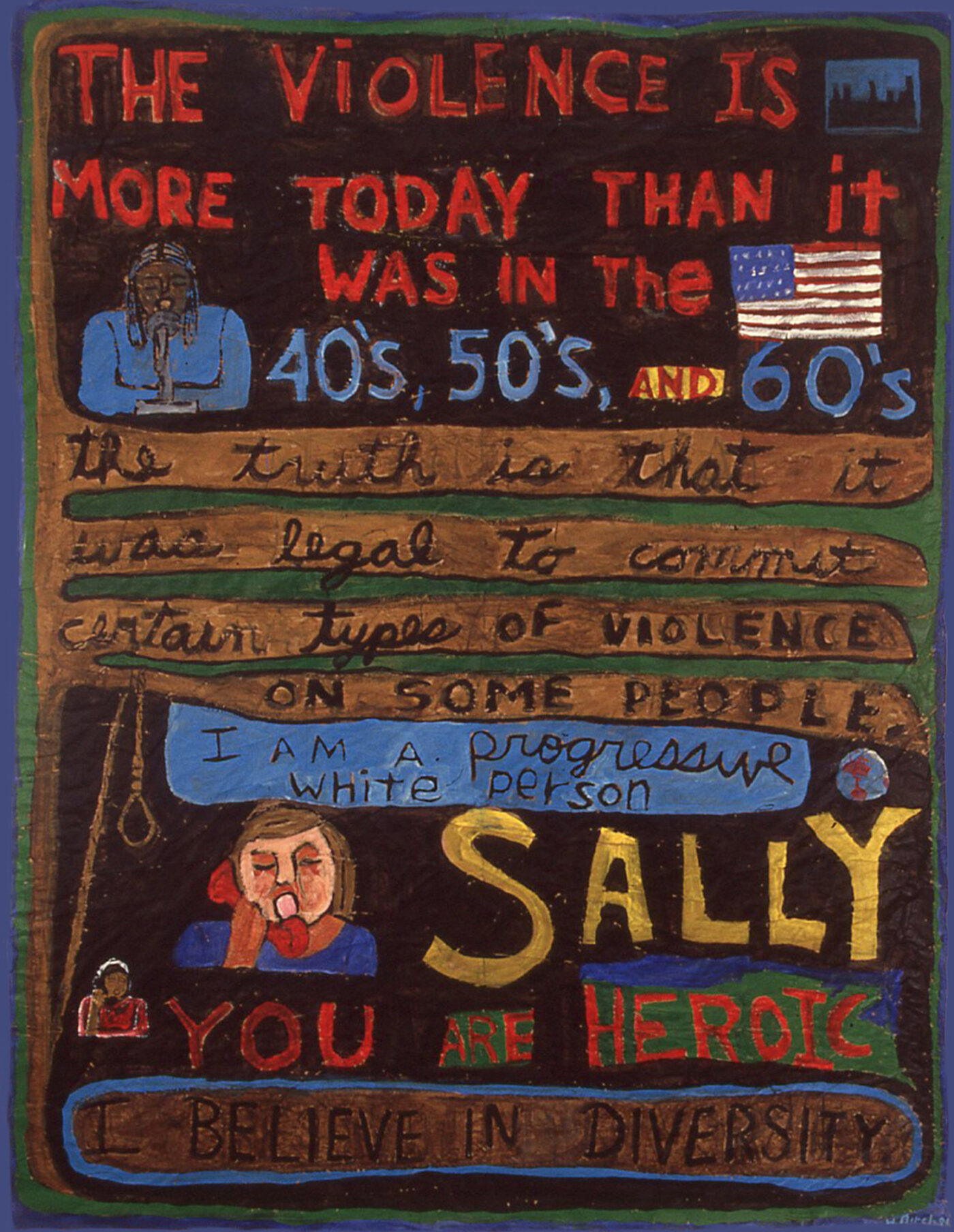
Willie Birch, Violence is More Today (Than it was in the ’40’s, ’50’s & ’60’s), 1994, mixed media on paper, 53.25 × 67.5 inches. Courtesy of the artist.
WBAnd the neighborhood embraced me to the point where I began to do portraits of the people I got to know. Still, I wasn’t satisfied because I was doing works in color like most of the artists in the city. I visited Ron Bechet’s studio, and we talked about what he was working on. We looked at his paintings, but we wanted something else. He took me upstairs to another room, where he pulled out a file of black-and-white drawings on paper, which he said he wasn’t showing. I became very excited and said, “That’s it.” And we began brainstorming about how we could make these works for the issues we wanted to address.
SgTell me more about this concept.
WBWe began with the idea of expressing ourselves by making black charcoal marks on large sheets of paper. It was very exciting. While making large black-and-white, mixed- medium paintings, we talked about the ideas we’d seen in works by the Cuban artists that came out of the Cuban Revolution, specifically their murals and sculptural black-and-white artworks. We used scale to express what was going on in New Orleans, which was the only thing to do. This included making them larger-than-life size work because the public that we were trying to engage with was not solely made up of people who could afford to buy our work.
SgMm-hmm.
WBWe wanted to expose our work to a more general public because Black folks don’t go to museums. Or they never had a reason to go to museums because they weren’t the ones being portrayed on the walls. So, we were going to force the city and the museums here to change their attitude by making competent, exciting, vibrant art which dealt with New Orleans . . . and why our art really makes this place not only an international treasure, but a place that can be explored along with and outside of its musical tradition. The city’s music had already established itself as one of America’s primary cultural manifestations, and now visual art was going to join that legacy.
I like to start with research. I was fortunate to be on an artist panel where one of the panelists suggested I should read Ron Eglash’s African Fractals: Modern Computing and Indigenous Design. This book informed my understanding of New Orleans culture and my beliefs in just being myself and telling my story.
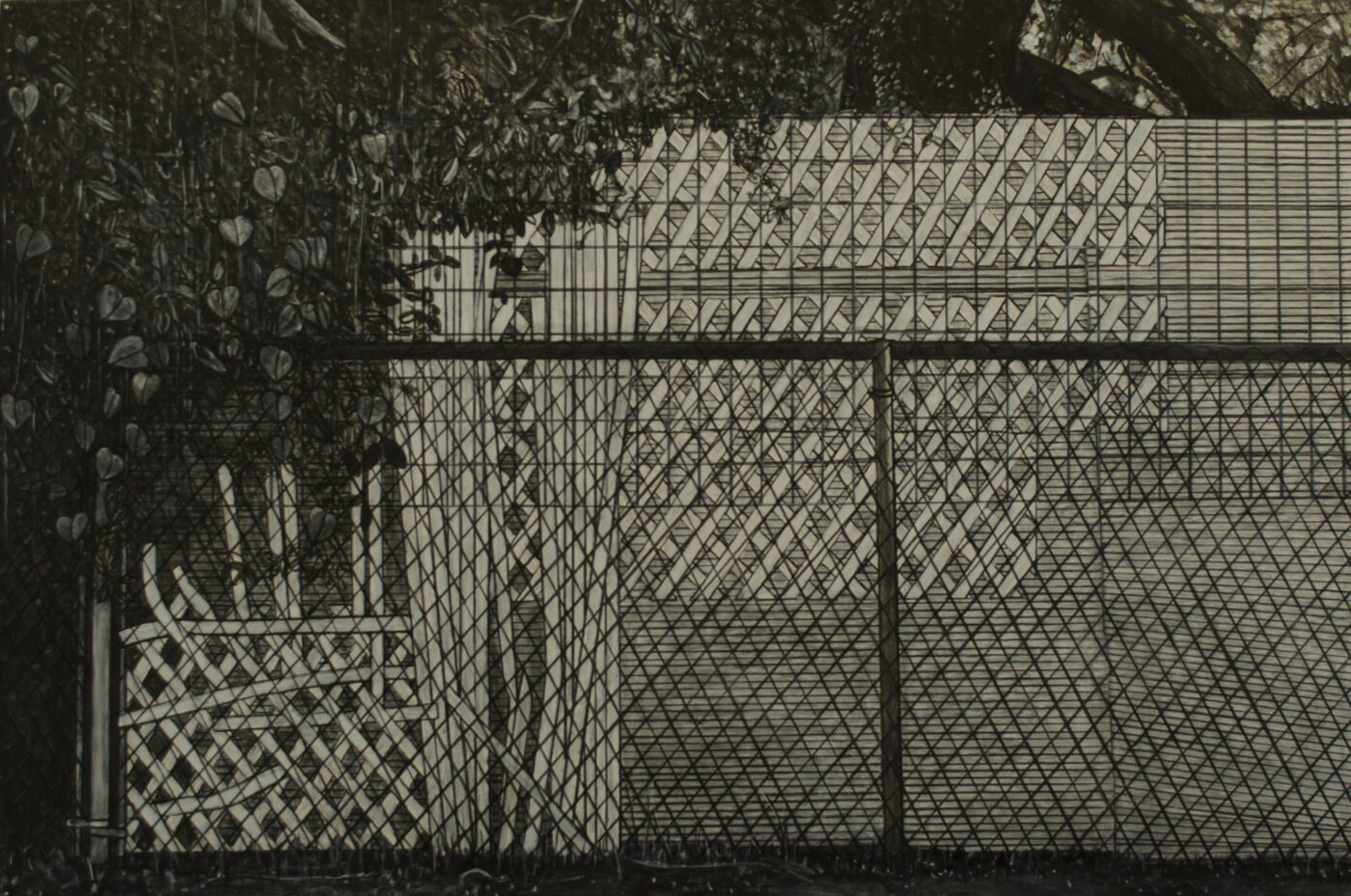
Willie Birch, Opus 2 Neighbor’s Fence, 2012, charcoal and acrylic on paper, 60 × 90 inches. Courtesy of the artist.
SgSo, based on what you just described, both with the fractals and Kidd Jordan as it relates to this creation of a musical score from your work, you have the visual narratives and he creates sonic narratives. What was that like for you? That type of engagement is both unplanned and very organic. What did it sound like to you?
WBWell, it was normal for me because most of the new music I could relate to in New York was created by folks like David Murray, Henry Threadgill, Butch Morrison, Olu Dara, Ornette Coleman, and many others.
SgMm-hmm.
WBSo, that was part of the problem I sometimes have in a place like New Orleans. Too many people I know call the music I like “noise.” I grew up around musicians and saw drummers like Ed Blackwell as a teenager and heard stories about Ornette Coleman playing in Louisiana. Then coming to New York and listening to his group
in concert at Carnegie Hall, I already made the connection between the traditions in creative music and the music coming out of New Orleans. The music is innate to us. It’s not something that’s foreign to us. It allows me to understand the music of New Orleans and the European art form called Dada.
SgWhen did you meet Ornette Coleman?
WBThe visual artist Amir Bey introduced me to Ornette Coleman one day on Eighth Street in the East Village, but I really didn’t know him outside of listening to his music and knowing that he had lived in New Orleans for a brief time. He played with musicians like Melvin Lastie and his brothers. Ornette also played with Ed Blackwell, who was one of the most progressive drummers to come out of New Orleans. When you look at the people Blackwell played with at Southern University in Baton Rouge, you realize that these brothers were someplace else in terms of creative music. They were someplace spiritual, and Kidd was a part of that. So, it was only natural that I could relate to Kidd and what he was doing. Kidd could relate to my work intellectually and emotionally. The same voices and conditions he was expressing in his music-making, I was working at finding and creating visually. And then we had this younger visual artist who we both knew and respected named Ron Bechet who was committed to creating his own language and vision in the search for truth, freedom, identity, and authenticity.
In New York, I was good friends with David Hammons for a while. David used to say to me, “If we take on the art world together, with the same ideas, we could challenge the institutions’ art biases and racist practices.” But I wasn’t interested in what David was doing at that time. I was interested in storytelling, not Dada. David was interested in more conceptual, minimalist art. And I am saying, “No, no, no, my audience has to be bigger than that.” My audience had to include my momma because if my momma doesn’t understand what I’m doing, then this doesn’t make sense. I want to create for and from the very people who we come out of. The people that seem to have a natural dialogue with me. So, here was Ron Bechet, who was a graduate of Yale and very smart. Ron and I became friends through his mother’s encouragement for the both of us to become friends. And we came up with a way of creating that challenged what was socially acceptable as art in New Orleans. We intentionally made these large black-and-white works that had a direct connection to the landscape of what New Orleanians experienced in their everyday lives. We did this in a way that was raw and beautiful, but not decorative. We began by making marks. For me, a mark could be a smudge or smear that demonstrated a physicality and carried expressions of intent and emotional weight.
SgMm-hmm.
WBWe decided to play with this idea. Most people see this work in terms of abstract expressionism—whatever that is—in terms of push and pull. But we saw the mark-making as a way of creating feeling and tension in the work. And through our formal training, we were able to take that and make it into our own language which is really outside of European understanding, even though when you study abstract expressionism, Charlie Parker is sitting right on top of those abstract painters’ work. He’s expressing through his music how to shape those expressive abstract marks. Jackson Pollock was listening to Charlie Parker, and so were Mark Rothko and Franz Kline. They all took their cues from the creative music of their time, which was Black music. So, when you look at Black art, especially music, you can understand that it’s one of the main demonstrations of modernism.
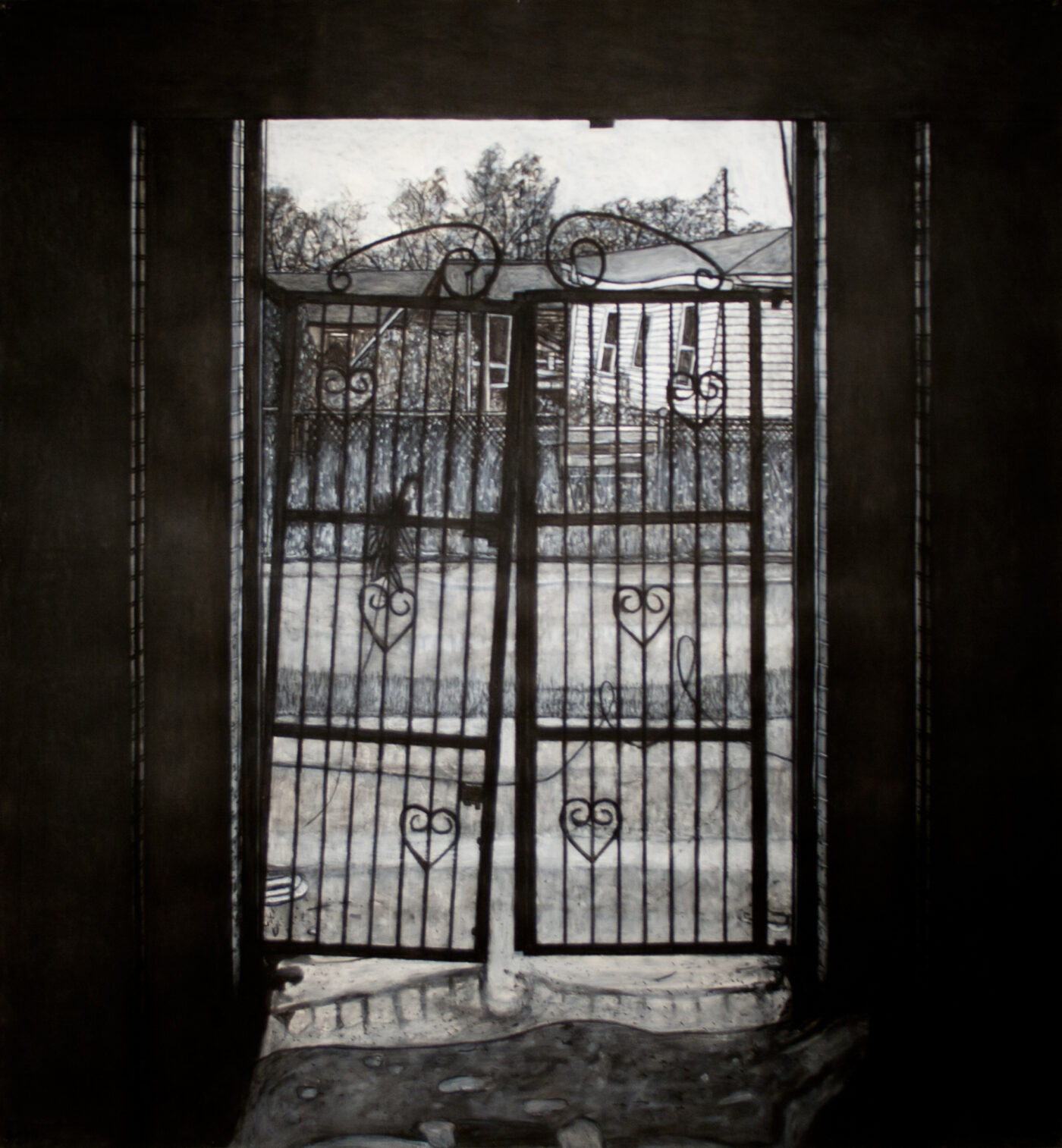
Willie Birch, Remembering (for Joyce Scott), 2011, charcoal and acrylic on paper, 60 × 65 inches. Courtesy of the artist.
SgI just have to point this out: You’re also a music historian. And you played the clarinet. So, there’s a certain sonic engagement that exists in your work. There’s also call-and-response.
WBTrue.
SgEveryone may not be able to pick it up or even hear it. But as you shared, Kidd Jordan heard it, and he responded.
WBBut it’s not the music, per se, that does that; it’s the ways we use rhythm in creating those layers of emotions.
SgNot all music. Because you were very clear about Black music.
WBYeah. Right.
I just finished a piece called An African American Story (Tattered Quilt). Some old Black ladies, like my grandmother and ’em, would sit down with these little pieces of fabric and put ’em together. And the beauty of it is that it’s a collage—many little pieces stitched together express a narrative. What they’re doing is telling us a story. And that story can be within the fabric that has no imagery on it, but it’s still a narrative because there are stories of places and people laced throughout. Also, we make things asymmetrical. We do not make things symmetrical. Europeans make things where one side looks like the other. Our stuff is always different. And we do these things naturally. People like Ron and I have spent our lives observing and studying who we are. We have studied those manifestations and how they speak to who we are as human beings. That comes out of our DNA, out of our environment, from what we have been born with—fractals. You don’t run away from that. You embrace that and run to it.
SgAbsolutely.
WBAnd by running to it, sometimes it makes you more isolated because the rest of society isn’t necessarily ready to embrace how we decide who’s going to be the creative force because many of us are still an oppressed people.
SgYou started our conversation by talking about the Kidd Jordan memorial you attended. Was that yesterday?
WBIt was. I had to be there.
SgWhen did he pass away?
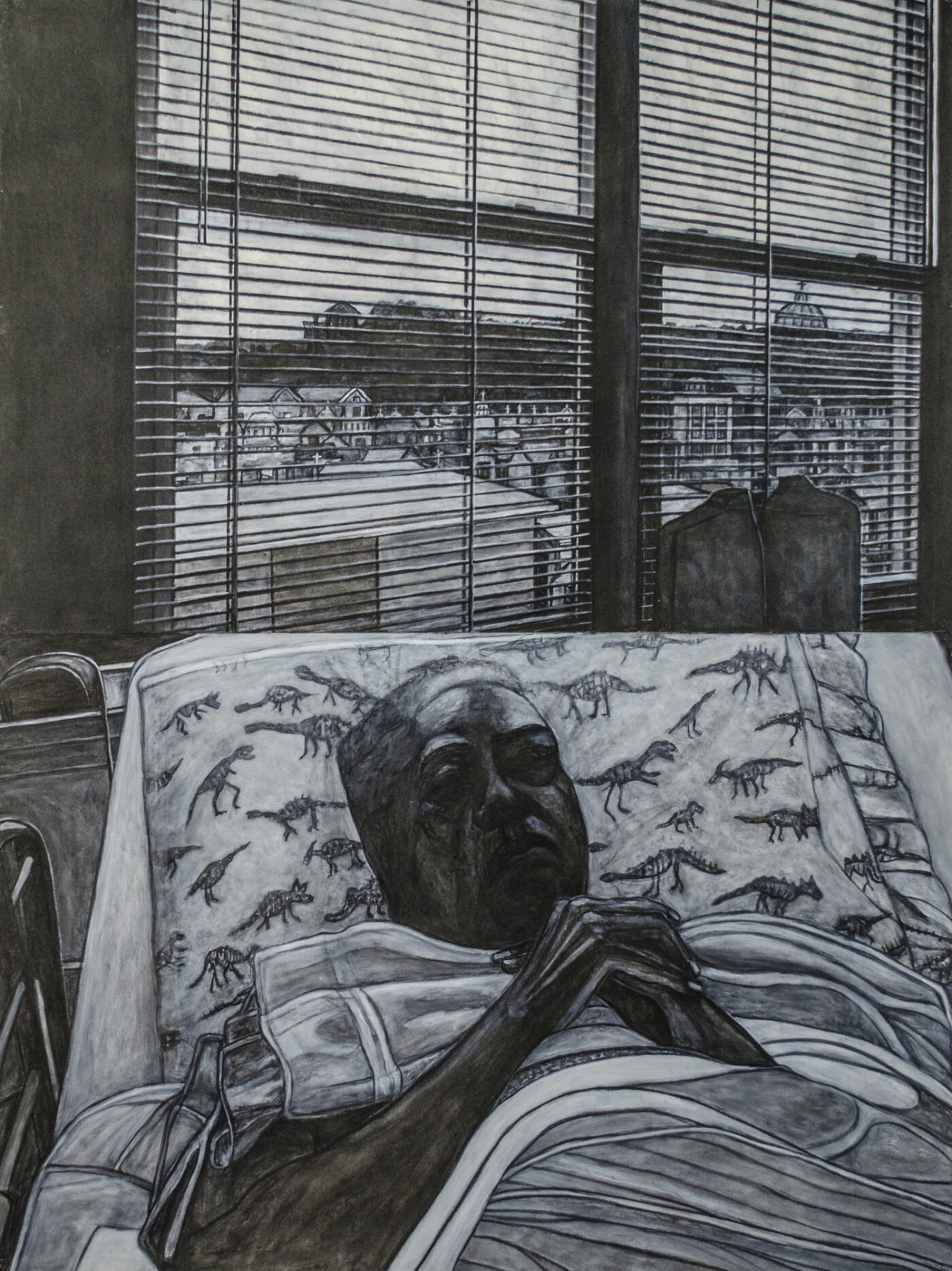
Willie Birch, Transitioning, 2023, charcoal and acrylic on paper, 64 × 48 inches. Courtesy of the artist.
WBKidd died the day after my sister died, which really took me back. My sister was three years younger than Kidd. But that whole idea of somebody close to me—like my sister and Kidd—dying was a lot to handle. I would go to Kidd’s concerts here in New Orleans. Sometimes there were only five people in the audience. Kidd was always a trickster. I went to this concert and there were about twenty-five people. And Kidd looked at me and said, “I gotta change this up ’cause everybody understands what I’m doing now.” He taught me that the moment defines what you create. You create out of these moments. You have a structure, but within that structure, you can play any way you want to. When you create like that—whether it’s visual, whether it’s dance, whether it’s music—
SgMm-hmm.
WB—it has to have a different beat to it. The drum is so important to our rhythm; it’s our heartbeat. That’s why I don’t always refer to what I’m listening to as music. But yeah, it’s music when I hear Kidd scream on his horn. Those screams are spiritual screams that go back to the days of enslavement. It comes through the church, and then it comes through the blues, and then it comes through in 1908—through the horn of a musician called Buddy Bolden who died in an insane asylum. It came through jazz. Today it comes through hip-hop and it continues to move forward. As long as we are on earth, we will find ways to do that if we are true to our craft, if we are true to our artistic practice.
So, I’m always looking for soldiers and warriors. These young people sometimes don’t realize that they are sitting in on something really special. Now, not to put a damper on our conversation, but that something special is getting lost. I see so much imagery that looks alike. Just as we have become artists, we can lose it. As things become part of the economic fiber of the country, and money gets interjected into the conversation, I worry about art communities staying focused on addressing the social ills of the under-class, who, because of race as well as class, are being left out of the conversation. My question is: As artists, who will continue to speak to the human conditions of so many poor, oppressed, and marginalized peoples in our country and the world? I am trying to wrap my head around what I call selling out the voices of our communities.
At what point does that become just about kitsch? And at what point does it remain true? The majority of the time, to do what we do, we don’t get paid. That is the reality, and I want young people to understand that. I don’t know why somebody decided that Willie Birch needs to be paid. Now I have been declared as having some talent or whatever. But the bottom line is that talent is usually not enough.
SgYou’re being a little too modest.
WBWell, no. I’m being honest. The bottom line is that the art market is different than the creative market. I believe culture and money have a hard time fitting together. So, in terms of having gallery representation, which I have, the problem is usually that the gallery owner doesn’t have any clue as to what you’re doing, but they know what sells.
SgMm-hmm.
WBThat’s one advantage of having a gallery. They have the clients. But too many of the clients are more interested in the economics of it. There are some collectors who are good people, like in any other industry, but there are many who are in this industry for the money. It’s like hip-hop. When hip-hop started in the Bronx, it was a whole other thing. Young people used hip-hop to express themselves with limited resources. They spoke to their lived experiences. Those of us who went to the Bronx didn’t quite understand at first. But eventually we understood that they’re speaking about the human condition. Then, as it became more accessible and traveled outside its original environment, the art form changed. But, if you’re true to that form, you’re still going to find ways to express who you are within that music, and what so many people in your community are going through. Being true to your experience does not always mean you get paid. To me, your importance resides in your ability to do the work you find relevant. And that’s powerful to me. That’s powerful.
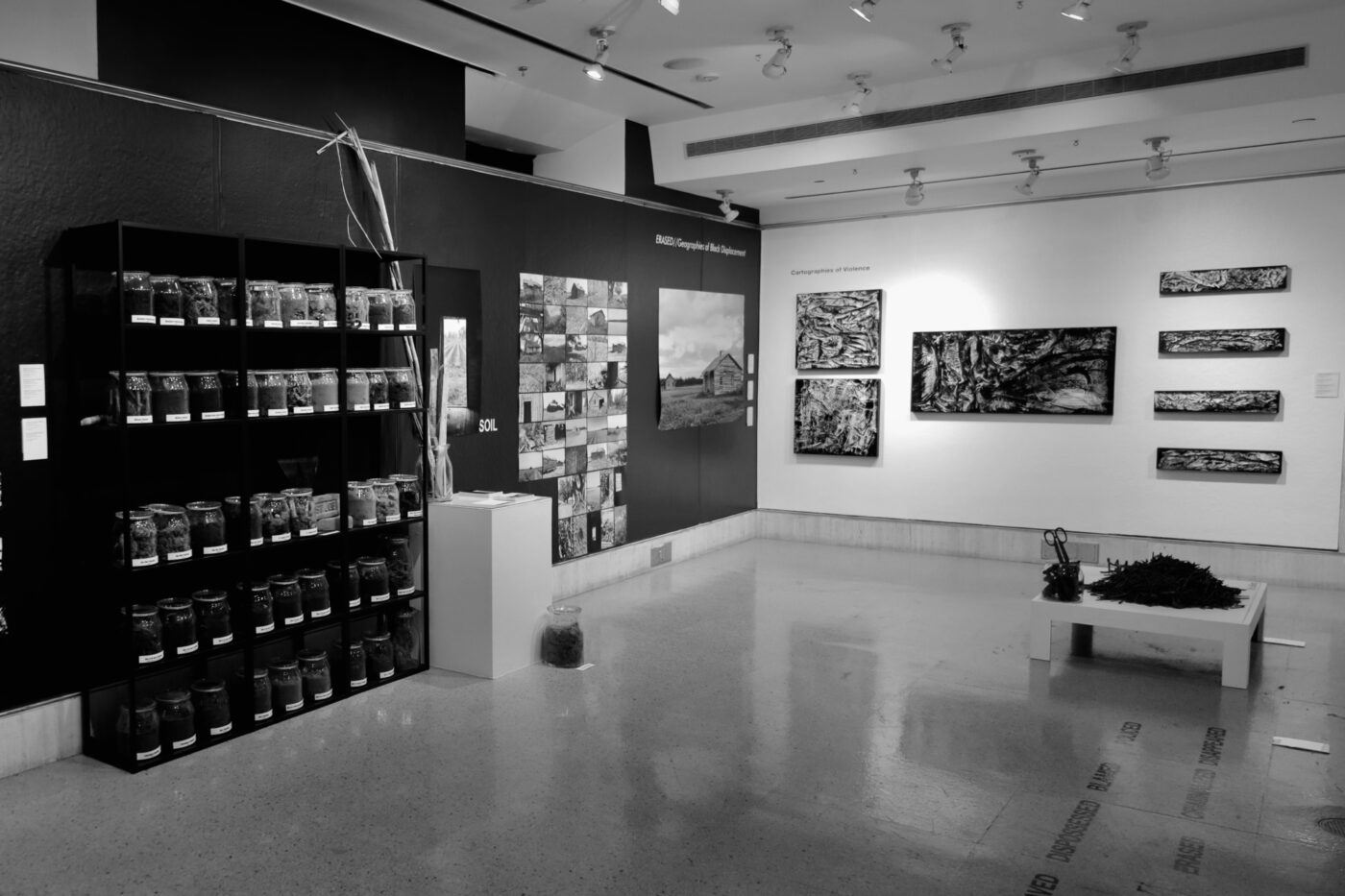
Gallery view of Shana M. griffin, ERASED//Geographies of Black Displacement, 2023, Fordham University Ildiko Butler Gallery, Bronx, NY.
SgDo you feel that your art speaks to the human condition?
WBTotally. And that had a lot to do with the Civil Rights activist Oretha Castle Haley and everything I learned from her while participating in sit-ins on Canal Street with the Congress of Racial Equality.
SgI’m glad you mentioned that. My goal for this interview is to engage you in a dialogue on your practice and its future, where you see it going—how history and everyday Blackness translate into your work.
Can we discuss the role that your early teachers and cheerleaders played in your career and your practice?
WBKitty Poindexter. Kitty. That’s my grandmother. I spent my summers in Bertrandville, Louisiana with my grandmother and when she passed away, I stayed with my uncle who was a teacher and minister. My grandmother said, “You can be what you want to be, and we are going to support you.” She encouraged me and gave me permission to do some of my first portraits, which were of her. My grandmother and sister were both always encouraging, and so was my eighth-grade art teacher, Ms. Daniels, until her passing. Now, my mother and I had problems because she wanted me to be a musician. The horrible story is that my mother threw away my artwork after I left home. Yes, painful, painful. My sister went into the garbage can and rescued some of the artwork while I was away from New Orleans, in the military, and trying to survive the Civil Rights Movement. In my life, I had these conflicts that we all have, but I believe most of them made me stronger. At thirteen years old, the only thing I wanted to be was an artist. I grew up in the Magnolia Housing Projects across the street from a famous nightclub, the Dew Drop Inn. So, I saw Allen Toussaint, Big Mama Thornton, Ernie K-Doe, Ray Charles, Sam Cooke, Ike and Tina Turner, Bobby Blue Bland, Etta James, and so many other artists.
SgWhat was the Dew Drop Inn for people who may not be familiar?
WBThe Dew Drop was one of the most popular Black clubs, an incubator for artists from all over the United States to come and have concerts. I remember when there was the battle of the Kings: Freddie King, Earl King, and B.B. King.
SgOh!
WBYep, B.B. came from Memphis. All of ’em were at the Dew Drop. B.B. King, Earl King, and Little Freddie King. I remember when I talked to Freddie King. I said, “Man, I used to sit in my friend’s yard”—which was right next to the Dew Drop—“and hear the big concerts.” I remember when Sam Cooke came. That dude was special. These musicians were not special only because of their music. They inspired me to create out of my experiences and for those around me. I decided then to be an artist. I just wanted to be a visual artist. I’m doing what I’m supposed to do as a human being.
SgSo, given that, you said people refer to you as a troublemaker. Do you see yourself as a troublemaker?
WBNo, I just think I’m doing what I’m supposed to do as a human being. I’ll give you a good example. My grandfather died when I was four or five years old. And what happened was that we had a big yard with fruit trees and flowers with a white picket fence. And one day after my grandfather died, these white dudes came and they opened the gate and they walked right on the property. And they said, “Where is Kitty?” Now this is me as a young kid who, not even realizing, said, “You mean, Miss Kitty.” So, then my grandma came out, and she put me behind her with my sister—I wish my sister and them was alive. But my cousin, Melvin, can tell you the story. So, they said, “See that one there, he’s dangerous. And you better get him out of here.”
Sg Wow.
WBThe next thing I can remember, I was back in New Orleans. My uncle and momma came in a car that night and took me out of Bertrandville and brought me back to the city. Later, after Katrina, somebody was interviewing me and I told him this story, but I didn’t know the whole story, so I sent him to my sister. My sister remembered. “Oh, yeah. You know who Willie told that to? That was the sheriff.”
SGAlmost an open invitation, but something tragic could have happened.
WBRight. Right.
SGBut your family understood and knew to—
WBSure. Nobody ever told me all those years ago; all they would do is laugh when they said, “Oh, Will and Melvin always getting into stuff.”
I’ve mentioned this before, but it bears repeating. They were going to lynch my oldest uncle when he was a kid. And my grandfather and his buddies—Mr. Morgan, Mr. Ben, all these giants of elders—walked in and jacked up his shotgun. He said, “I guess we [all] gon’ die here today. Cut him down.” Now, this sounds like a movie. They cut these other young boys and my uncle down and they sent him to New Orleans and Uncle Dan never lived in Bertrandville after that. So, all my life, people would say, “Boy, them Pointdexters, boy.” I have a street named after my Uncle Nat. And my Uncle Dan owned the Brass Rail which was one of the biggest ballrooms for jazz and stuff in Marrero, Louisiana. And he built it all himself. When you got people like that . . . And then I have another cousin who was the assistant director of the Urban League. I was being interviewed for a New Orleans historic society. They asked how long were you conscious of being a social activist? I said, “I never thought about it like that.” But I remember my mother wouldn’t let me go demonstrate when they were integrating A & P to get black people to be cashiers and stuff. And I raised hell. So, she and my cousin came up with this idea: Well, maybe Willie, since he got the artistic ability, could make signs. So, I made signs. And then I sat cross the street. This is right where Ashe is at.
SgMm-hmm.
WBYeah. And I watched these folks who were picketing at Dryades Street, walking back and forth, demonstrating in front of the A & P. My life is a story. I just sat there and I grinned, you know, as they walked back and forth. I was maybe fifteen, maybe even a little younger. My cousin was the leading person to integrate the New Orleans transit for Black bus drivers. His father was the union organizer for the longshoremen. So, what could I not be?
SgYou’re reflecting the space and the community from which you come from.
WBRight, totally. There’s nothing else I could possibly be when I think about it. It’s not an accident that I think like I think.
SgAbsolutely.
WBYou have those folks that really projected some imagery. The idea of being a history minor in high school. That was Mr. Higginbotham. He said, “I’m gon’ teach y’all colored history. And I want everybody to raise their hand and take an oath.” We all raised our hands. He said, “You will not tell anybody in this school what I am teaching because, if you do, I will lose my job.”
SgThis was still Jim Crow segregation. You took that oath seriously, right?
WBDead serious. It’s like the stories that somebody tells about Black folks and the stories that I know about Black folks, they don’t come together on the same level. It was in New York that Mr. Bearden began to tell me about the blues. I always thought the blues was a lower form of music.
SgOh oh. You got checked on that, huh?
WBWhew, got checked on it big time! He said, “You need to go find out about the blues.” So, I went and found about the blues. Next time he lets me visit him, we can talk about the blues. Wholly different thing. But people have taken me in, for whatever reason, and they respected the way I thought, and they were able to help to influence that. So, it shaped me to where now I become the old man. Those people were rough. If you came shaky—
Sg—you got checked.
WBThey didn’t give you a break; you had to prove yourself. These kids today, we have sheltered our kids to the point where a lot of them don’t really understand the price that Jacob Lawrence, Romare Bearden . . . Both those people had nervous breakdowns.
SgYeah. Mm-hmm.
WBYou hear what I’m saying? But nobody wants to talk about that. But we should because we need to understand that struggle. For them to be able to go to art school—art school is fashionable today. Art school wasn’t fashionable then.
SgMr. Lawrence and his desire to go back home. He didn’t make it back home.
WBWhen you say home, what do you mean?
SgHe wanted to go back to New York—he was in Seattle. And he didn’t make it back. Years he was talking about going back, going back.
WBMm-hmm.
SgDid you create a workaround to come back home? You have described how people said you were leaving the art world and you said, “No, I’m entering the space where I need to be.” As an artist, what does that mean to you?
WBWell, that’s where Oretha [Castle Haley] comes in. She saw what I was doing at eighteen years old, and she pulled me aside and said, “You got talent, Willie Birch. You need to go find out who Käthe Kollwitz is because there are artists who’ve gone to prison or died for what you could add to this moment,” which to her was about the Civil Rights Movement. And so, I went to the library and found this book on Käthe Kollwitz. It changed my whole life because I realized that there were writers, visual artists, musicians. The music was… It was all subversive back then. And I began to study the art that was made in the early 1900s by Europeans who were trying to make an art that was very different than what I was trying to do, given the decadence and all the aspects of what was going on in Europe. Surrealism, impressionism, that’s what all those things are about. There was a whole conceptual element to why they made what they did. And to me, that was powerful. Impressionism really didn’t gain any leverage until it came to the United States, because the American artists saw it very differently. In Europe, impressionism was a lot of pastel colors with no relationship to the Industrial Revolution.
SgOretha Castel Haley. Was Oretha actively involved in the Civil Rights Movement at this time?
WBTo me she was. She was like my sister. She was the Big Mama. I followed Oretha where she took me. Because of her, I was part of integration. Black folks could only go to the library on certain days. We went and laid on the floor to protest and all that stuff. They didn’t arrest us. When we went to NOMA, we decided to position ourselves on the land because the land was private property, and the museum sits on the private property. That was to keep Black folks from going to the museum because to get to the museum, you had to walk on the land. That’s how the great artist Miss Elizabeth Catlett comes in. In the ’40s, she found a way by putting her students on a bus. The bus drove right up to the—
Sg—front entrance.
WBYeah, the steps. The kids never put their feet on the grounds. They went into the museum and that was the integration of the NOMA, which was then named the Delgado. The reality which we need to talk about is that Miss Catlett lost her job. Dillard University had to fire her because of the pressures from the white community. You see? And who is she married to? She was married to Charles White. See, all this stuff is so connected. Charles White won a major prize at NOMA when he and Miss Catlett were living here. He goes to the museum to receive the award; they realized he’s a black dude. They couldn’t give him the award.
Miss Catlett, when she moved to New York, used to invite me to her place. And after we talked, she said, “Golly, Willie Birch, you know, I wish we had some more of you” because those people had been following my career since SUNO. In my junior year, I won third place in sculpture in this National Conference of Black Artists, the student division. And I won second or third place in watercolor. And Miss Catlett let it be known. She said, “He’s no amateur and I want to meet him.” Everybody said, “Man, she tough.” But when I did meet her, in a short while, she said, “You already ready.”
SgYou were ready.
WBI was ready. I came to New York to be in a progressive African American gallery, with my peers. Like Linda Goode Bryant’s Just Above Midtown gallery. I wanted spaces like that. I had already entered that. There was a gallery called Smith Mason Gallery in Washington, DC, which was this Black-owned gallery by this little Black lady, Helen Smith Mason, and her husband, James Mason. And she was showing myself with people like Alma Thomas, Mr. James Wells. These are all the people I was hanging out with. I’m twenty-something years old and in DC then. Every place I’ve gone, I found or lucked upon or wound up in the right position to meet the right people and be able to sit in and listen and learn. And then, at some point, somebody said, “Willie Birch, you got something to say, and we’d appreciate if you say something rather just sittin’ here listening.” Once you open that up, it becomes another ball game, man.
SgWhen you said that’s where Oretha comes in, at that point in the Public Library and those civil disobedience actions, that engagement with the movement was you stepping into your own voice? As that relates to art, how would you describe your art practice? You got time for this one.
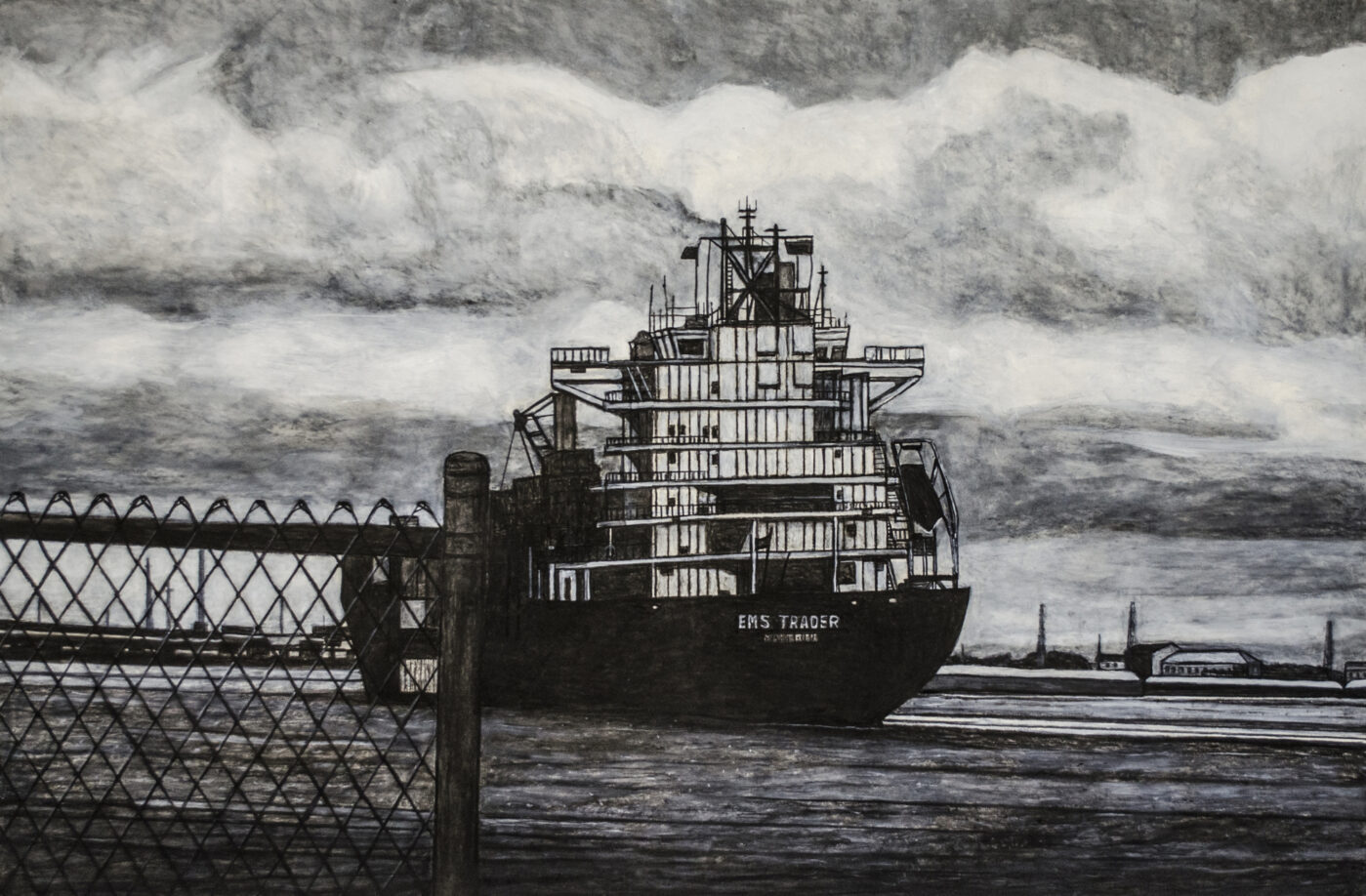
Willie Birch, Looking Towards Algiers, 2017, charcoal and acrylic on paper, 48 × 72 inches. Courtesy of the artist.
WBIt’s not being facetious. At this point, I’m in a different position again. 1992, I gave up my job teaching innovative art education at Hunter College and working at the Guggenheim Museum and decided that all I want to do is make my art. Everybody was going, Man, how you going to survive? I say, I’m going to survive and I’m going to be able to make my work and I’m going to support those four kids I got which was always important. And I did. And so, then the Guggenheim Foundation grant came and then the international fellowship came and then the Skowhegan thing came and then I joined Arthur Roger gallery in New York and then I moved back here.
Leslie King-Hammond, in 1976, said, “Willie Birch”—because everybody thought I had this big ego, which I guess I do—she said, “Willie, if you think you so bad, why don’t you see if you can give away one of your works to a museum?” I didn’t know nothing about giving works to museums but I chose NOMA because that’s my home. And they gave me the runaround, talking about they wanted me to change the title. And it was a struggle. And finally, I said, in so many words, Screw y’all. And then they say, Okay, we’ll take the piece. Homage to Kitty Poindexter from a series called Land of Blacks. I was using this map of Africa. I had seen a show by this brother named Frank Bowling, who was born in British Guyana. And he had this show in New York at the South American consulate. I had seen the piece by him entitled Mel Edwards Decides. Now anybody who knows Mel knows that Mel Edwards is a sculptor and a bad brother. Mel’s politics are right in his work, in this series called The Lynch Fragment Series. So, most people, especially people we call “white,” have problems with the work because you can feel and imagine the horrors and the pain. It’s the same thing with Bearden cutting up his collages of these Black faces. But then you deal with it, as an artistic practice or an extension of cubism, and all of a sudden, it takes on a whole other formal aspect. That means there’s a layer there. And when I saw that, I wanted to know who Mel Edwards was. I wanted to know who Frank Bowling was. These were the people who were supposedly doing abstract art that I could relate to. And then you had Sam Gilliam, who I never considered doing abstract art. One of the reasons I went to Maryland Institute was to study under Sam Gilliam and then he left. What happened is he had this show at the National Gallery in DC. He was draping the canvas in these pieces. And I read this interview where they asked him why he’s taking these large paintings off of a stretcher. They are just flowing. And he said, “I kept thinking about my mother’s clothes on the line.”
SgEveryday life.
WBThank you. Thank you, Black man. Thank you. See, so there are these hooks that supposedly appear to be abstract but have nothing to do with abstraction. It has to do with him finding a vehicle based upon the time frame he lived in, to extend the dialogue with a larger art world but also stay true to who he was. Nobody would write about that part of what we do. For me, it’s always been: How do I get to where I don’t need you to write about it? I’m going to be direct enough that when you look at my work, you got a damn good idea of what I’m talking about. Now the craft, the level I bring to it, as far as my artistic practice, I dare you to reject it for that reason. Folks be going, Man, how’d you get here? I say, Read, brother. That’s what this practice is about. The whole idea is how many layers can you get into this one piece and have fun, and that’s where African sensibility comes in in terms of rhythm.
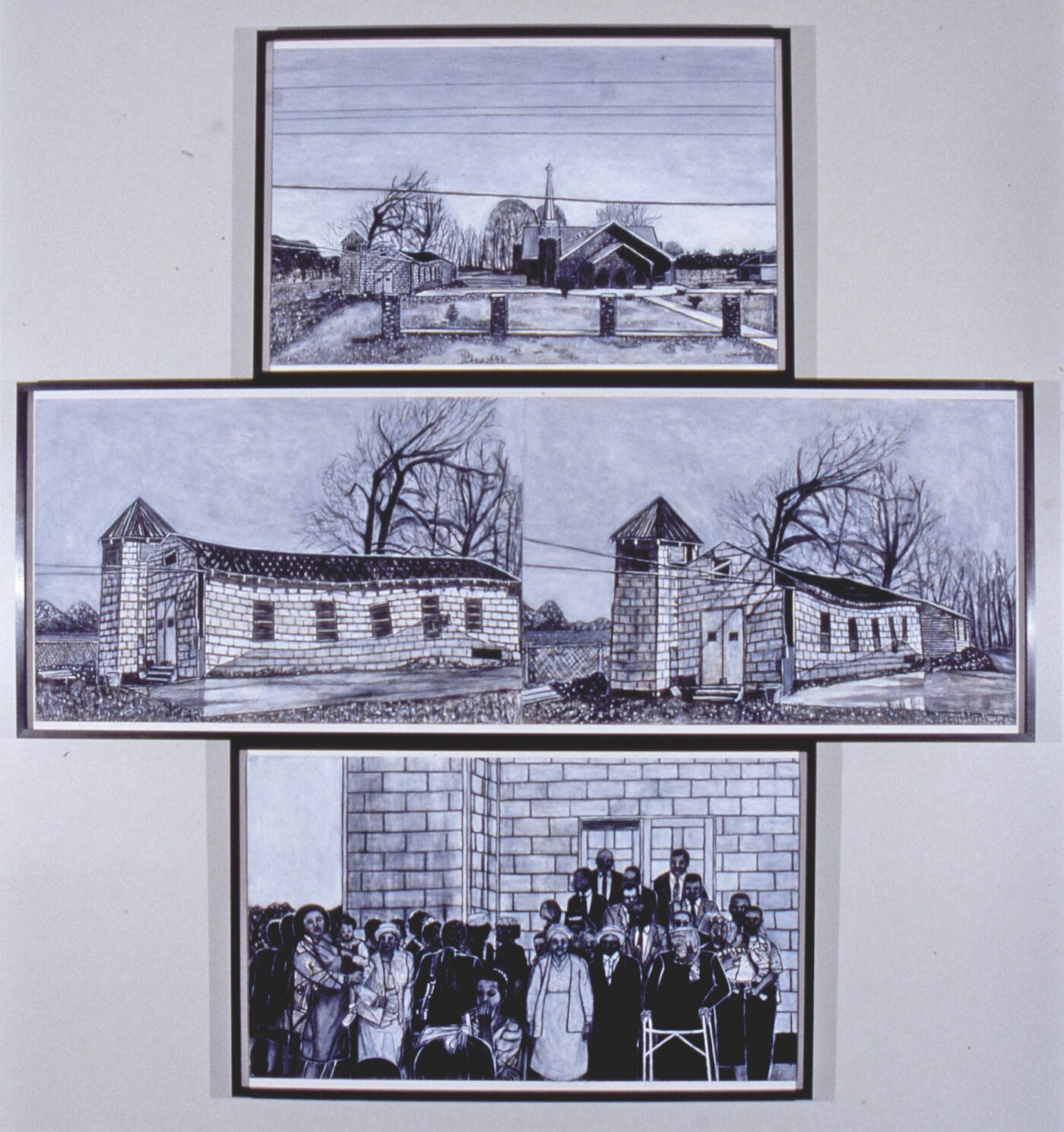
Willie Birch, We Come This Far By Faith, 2007, charcoal and acrylic on paper, 108 × 108 inches. Courtesy of the artist.
I’ll never forget, I did this piece on Black manual labor that was in the first Prospect New Orleans (2008). What I did was that I structured these pieces such that it fit into this cubistic moment. It wasn’t a formal structure, but it made you see this thing as whole. It was a structure that allowed the viewer to metaphorically see this as the way we do our second line, our procession, so as we move around the piece, so do we move around the street. And this woman from Arizona Contemporary Museum saw it and said, “I don’t know what you’re doing. But there’s another energy here.” I say, “Yeah, that’s it because we are marchers. It’s about the procession.” I had broken into another dimension. As far as I was concerned, the pieces became more sculptural. They were no longer flat. They were sculpture. So, I’m constantly challenging these things, but it’s out of desperation to make a clarity so that, hopefully, I can understand and then the viewer can understand. I have problems when people within the artistic practice ask, “Are you sure you know what you’re doing?”
SgThat’s so offensive.
WBOf course. It’s an insult. It’s racist, too. It’s all those things. I’m saying, Are you sure you understand?
SgFlip it back. Yeah.
WBSome say I am arrogant, but I say, No, that’s not me; it’s you who don’t understand. I’m already there. Then with the idea of self-trained or so-called found objects that Rauschenberg and Jasper Johns did in terms of what we call Pop Art. Black folks were already doing that. But why were we doing it? Because those were the only things that we could find that made sense, where we can see our history, that we can use visually to make something about who we were. Now, we weren’t the only people who did that. But then as you travel around the world and you go to Egypt, Italy, all these places, around the Mediterranean coast, Spain—where does that all connect? It leads you right back up to that continent that they’re trying to make sense out of: Africa.
I got a grant and went to Egypt. That experience just blew me away. Not the pyramids, per se. I was interested in numerology. In the Cairo Museum—I went in the early ’80s— I think it was the second or third floor, I saw Tutankhamun’s hair and they were dreadlocks. Then I started looking up the origins of this style: People we call the Mau Mau in Kenya who started the uprising. Well, who saw the Kenyans? It was the folks in Jamaica. And then we all started doing dreadlocks. See? There is that natural extension of how the history changes but yet, it’s part of the same dialogue.
And that’s the beauty of travel. If we could do anything for these young people, it is to put them on a plane and send them for two weeks to another country. I don’t care whether it’s initially Europe or Africa or Asia. But they get the chance to see how other people live in relationship to how they live. If it sinks in, there’s another appreciation of the uniqueness of New Orleans because it has been able to maintain its own identity through the culture and through what we’ve created coming out of that, and the genesis of it begins in what we brought from Africa through all these different people and how we made that work. And now you have people coming here, they’re dancing and they don’t have to totally understand it, but they know that there is something different about this.
Let me conclude with this: At Kidd Jordan’s procession, it was raining. And even though I had gone to my sister’s funeral the day before, I had to be at that procession. I didn’t go inside. I waited outside. What happened was that it was pouring down raining where people couldn’t step into the street from so much water. Must be like a foot of water. And about a hundred people or less were left, and the flood just drove ’em to the sidewalk. And all of a sudden, the tune that they busted out and played was “Do Whatcha Wanna.” Now, I’m crying because those lyrics came out of oppression. And everybody’s singing. And I’m going, Wow. Only in New Orleans could I experience that.
SgSo, you let loose?
WBBecause that’s living culture. Of course, I’m letting loose of my sister. I’m letting loose on the idea that we still fighting to bury our dead in the manner that we need to and what all of that means in terms of our lives. As we move, as we begin moving forward, people need to understand that, whether or not they want to recognize it. Now they can steal what they want. The point is that the root is the root. And it’s up to people like you, Shana, and all these other people who I’m looking for, writers, who can articulate what people like me do. I don’t want my fellow brothers and sisters to think, Wow, we don’t know how to approach him because he’s direct. But, brother, this is about urgency. And I don’t have that much time to be around here trying to sugarcoat your responsibilities to each other. That’s where you bring in Jerome Smith. Jerome, when I came back, got me to understand how he was able to survive during the Freedom Rides. It was the Mardi Gras Indian saying, “I won’t bow down on that ground.”
SgMm-hmm. I could feel it.
WBYou hear me? He said, “Willie, you know why we speak to each other every day? That’s to humanize us.” He said, “Because once I looked you in your face, you can’t relate to me the same. I don’t care how manic you are.” And I say, “So that’s what Good morning, Good evening ’bout.” So, people coming to New Orleans: Aww, man, y’all so nice. Y’all say Good morning, Good evening and stuff. Brother, it’s about survival. And that’s what I’m trying to articulate in this article as best I can. And then we’ll see where it goes. Because the dialogue is already changing as far as I’m concerned. Now I’m seeing people talk about community. People, I’m talking about survival. I don’t know if they’ve read my earlier stuff. But I get the feeling they read some of it. And the point is, if you’re going to call it Blackness, that’s where Blackness has to go.
It has to go to a conscious level. And so, I applaud when we can all talk about what is our commitment to each other, and how we are so disengaged now whereby we can’t even look each other in the face. All of those things are symptoms of a society that’s going awry.
SgI want to shift to go deeper into what I asked you about your artistic practice, the different mediums, and some of your current work. I asked how you would describe your practice and this is what I heard: I heard of connection, of accessibility, of a practice that’s layered, one that listens. A practice as sculpture in terms of thinking about texture. It’s not flat. One that is also tied to survival and out of a desperation to make clarity so there is no mistake and misunderstanding, right? A practice of talking back, as bell hooks would say, in talking Black.
WBAnd she was my buddy, too.
SgAlso a practice in everyday life where people could see themselves in the work, right?
WBMm-hmm.
SgAlso, a practice of improv, one that’s relational to the environment and other ways of living—
WBMm-hmm. Beautiful.
Sg—to expose oneself to other environments, right? Also, practice as geographical.
WBMm-hmm.
SgAnd, as we said, one of letting loose, getting down. And the geographical one is important to me because I’m reminded of a comment you made when you talked about relating your work on Blackness to how the Mississippi River forces us to improv. When we talked about something that’s geographic, how the built environment allows… There is no north, south, east, west here. It’s not clearly defined.
We talked about the fractals, right? So as such, given all these different engagement points of connection, accessibility, letting loose, what are the mediums that you engage?
WBI’ve done a lot. I work in series. I’ll take an idea and I’ll just expand on it until it’s exhausted, and then I move on to something else.
SgI like that.
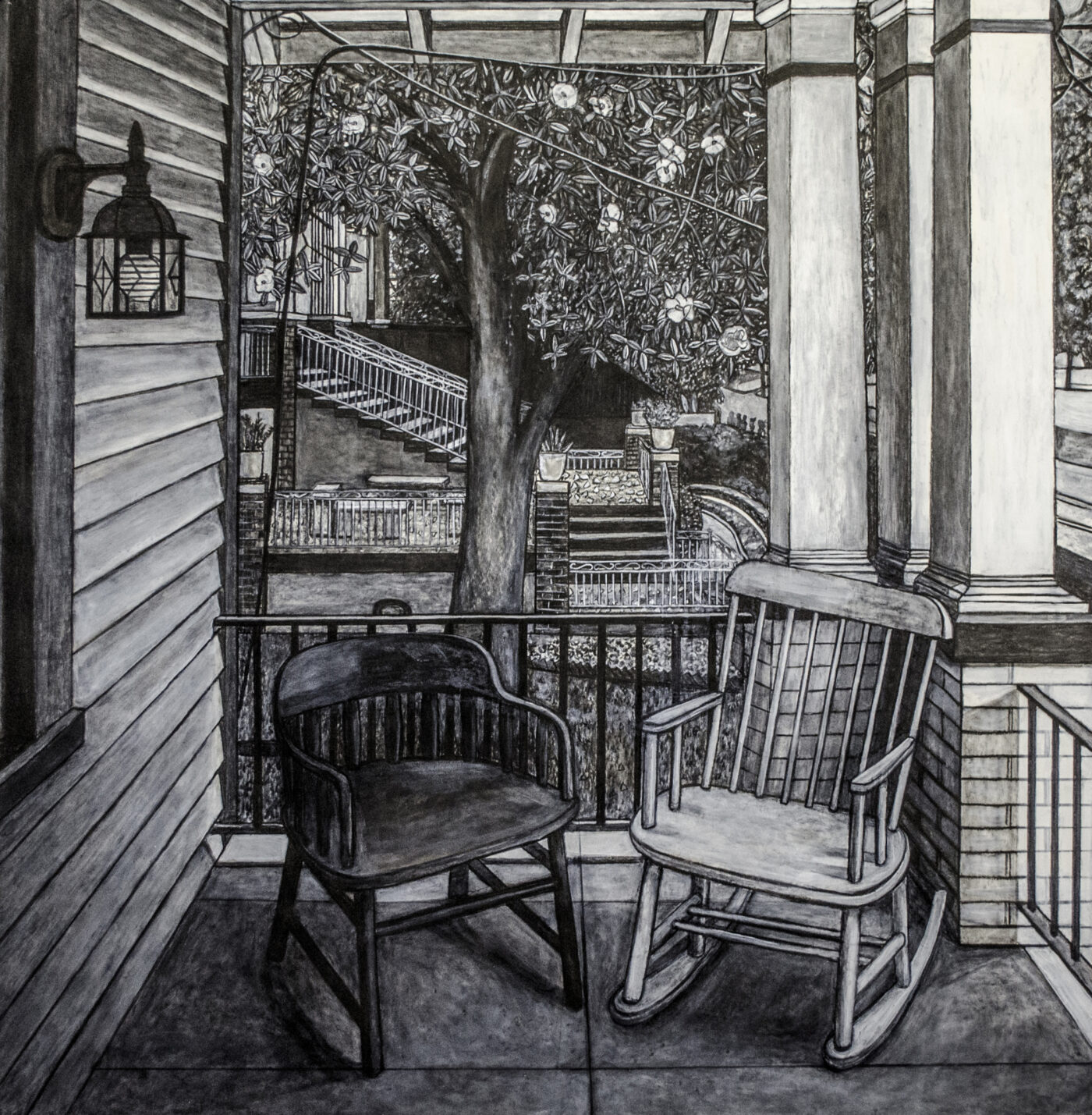
Willie Birch, Waiting for a Serious Conversation on the History of the South, 2017, charcoal and acrylic on paper, 75 × 72 inches. Courtesy of the artist.
WBWell, what happened was that, after coming back from Egypt, I happened to come to New Orleans for the World’s Fair.
Sg1984.
WBMy mate then was a lady by the name of Marina Gutierrez, a Puerto Rican. She was playing around with papier mâché. But out of respect for her, I wouldn’t do papier mâché. And then we came to New Orleans and visited the St. Louis Cathedral where I saw a fifteenth-century crucifix in papier mâché. And I said, “Marina, we got to go back to New York, baby, I found it.” I said, “No disrespect to what I’ve learned from you, but now I know that I’m gonna make things out of paper.” Then I did my research. We send paper as a useless object to places like India. They clean it and send it back to us as tissue paper. Paper in the art world has been treated as a fragile substance. So therefore, it has no real value. And so, somebody will pay $25,000 for a piece of canvas but give you $8,000 if it’s on paper. And I’m saying, No, we are going to mess with that whole idea because you’re going to pay for how important what I did represents who you are. That is where the preciousness comes in. It’s not the paper. It’s the idea of what this thing represents. So, I began to explore paper. Jacob Lawrence, Elizabeth Catlett, Sheldon Wyatt, Romare Bearden, Kara—and I didn’t even know Kara Walker then. The point, those people, the genesis of how I do what I’m doing, what medium did they all use? Paper. So, I had a natural hook in terms of dialogue and paper became my main source. With Ron, we use paper because we want it to be rejected. Paper’s supposed to be fragile, it can be torn—what can I call it? The extrapolation of that piece from a main body is like collage. It creates mystery. And this is our history of a people who have been disjointed. In terms of how my mind functions, I’m constantly looking at those things that allow me to make paper pieces. By the time I had my first major show at Exit Art in New York, which was a lot of papier mâché, it just blew up the whole art world. All of a sudden, boom! Arthur Rogers sold a piece to the Chicago Children’s Museum. I’d never gotten that much for a piece of paper in my life. And I say, Wow, for this hunk of paper. I guess we done put that baby to rest. Because it ain’t about the paper; it’s the preciousness of what that idea represents. The idea of value is what I was questioning, and I still do. I still work on paper, although I work in anything I want at this level, but it’s all an extension, and they all are interrelated on one level or another.
I find so-called thrown away pieces on my property now. We wind up making something, we put it in the yard. The yard is like a model. It’s like a playground for me. To make ’em precious, from a Eurocentric point of view, I do ’em on these large sheets of paper and they’re beautiful. And the narrative is still there. But it changes the whole dynamics because it’s not something that the wind can blow down. Now, it’s within a pictorial form, where you have to recognize it for its sheer brilliance. My buddies in New York, those that come down here… Man, y’all think y’all doing some stuff. That damn Willie Birch is kicking butt in New Orleans. That’s why Ron did that big old piece in the last Prospect New Orleans. Whoohooo, you know, just the sheer scale of it. Man, if it survives, somebody is going to buy it because it’s instrumental in terms of redefining New Orleans, redefining how Black people look, especially to ourselves, giving us another sense of ourselves and forcing the viewer to confront us on an equal level.
At some point before that, I had done these portraits of everyday people and the gallery saying, Well, I don’t know if we can sell these, Willie. I said, “It ain’t about selling, brother.” But it was interesting to watch the viewers on Julia Street, who had never seen that many black people on a wall in their life. They came in. Some of them walk around and walk off because they had to confront these portraits as equal and I’m leaning on the counter—
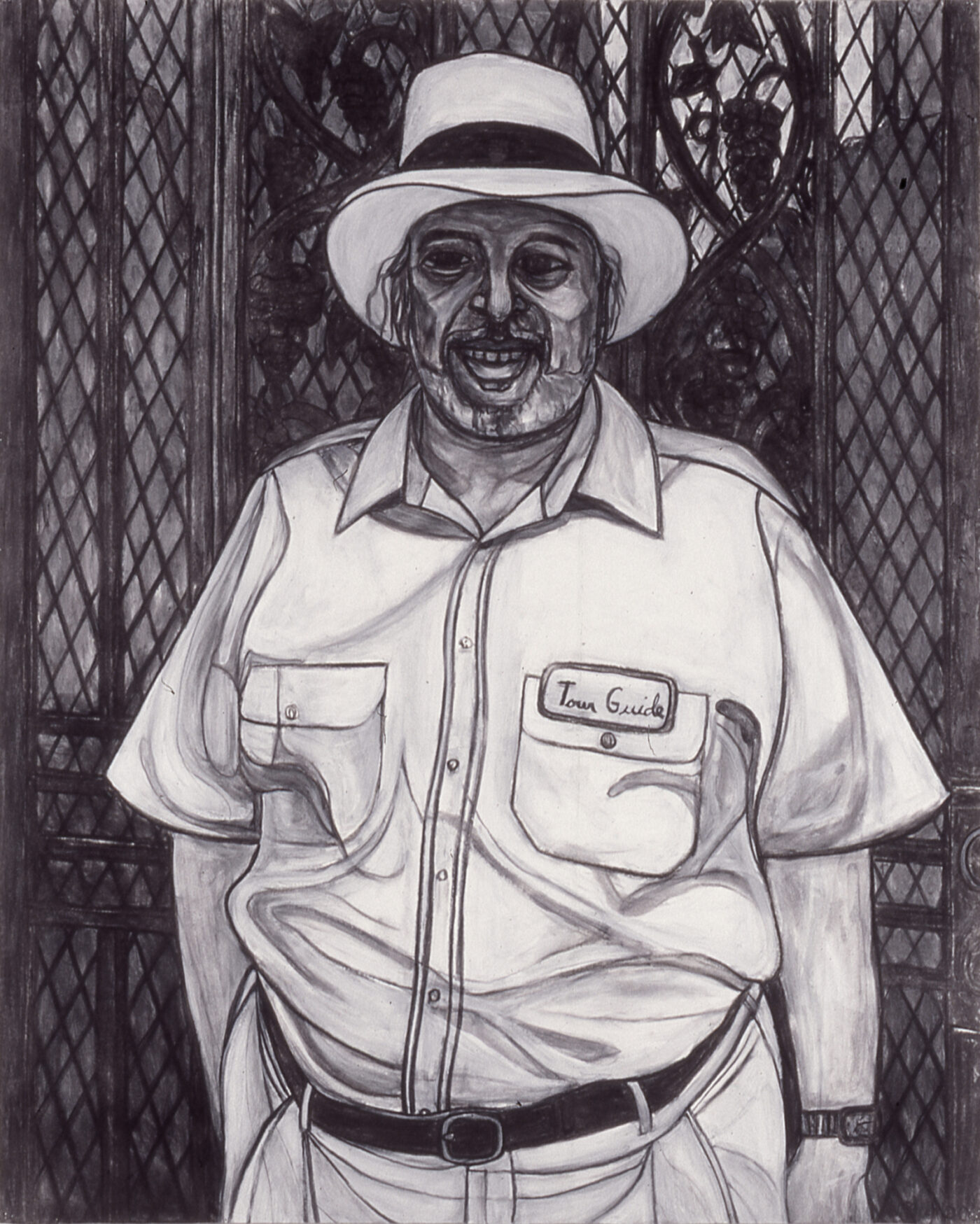
Willie Birch, The Tour Guide (Mr. Jazz), 2000, charcoal and acrylic on paper, 52 × 42 inches. Courtesy of the artist.
Sg—taking it in.
WBJust laughing.
SgAs you’re sharing this story, I am reminded of Zora Neale Hurston how she saw value in everyday folk stories, in Black ways of living and being in rural communities. The same way you saw paper, as a value, as a portal to share, a way to tell stories, she was laughing it up, like folks are thinking that she’s not engaging Blackness and celebrating Black life by not talking about oppression. She’s looking at the beauty of what she sees, what she’s surrounded by. And these portraits of yours… And people are afraid because they’re forced to have to see and deal with it as you’re just sitting there laughing it up, watching them in their own discomfort.
WBYeah.
SgBut you see the beauty in the everyday, in terms of your practice, that connection, that accessibility, their reflection.
WBBut see, people catch up to different things at different times. I don’t judge people until they have to deal with what I say. And then we evaluate. And then, when you want to have a real dialogue, we can have it. Because now you understand something about why I said certain things and you can reject it or you can accept it. It’s okay because there’s enough space to be different. But my first thing is to be confronted with another model, a paradigm that you’re not accustomed to. That, to me, is what original art is about, taking the thing that people didn’t even see, and now you got to see it. It’s like that young lady, the star NCAA basketball player, the most valuable player, Angel Reese, when LSU won the championship. She did the “see me now.” And everybody jumped on her. And then she said, “Well, no, white girl did that before.” And then everybody had to recognize. And then everybody got all embarrassed because she was being from the hood, you know? And she said, “Well, I am hood.” See, that took a lot for her to allow that anger to be turned into something all of us can embrace and begin to speak to as human beings with another consciousness. And some of us do it better than others and… But it takes courage. It takes courage or total ignorance.
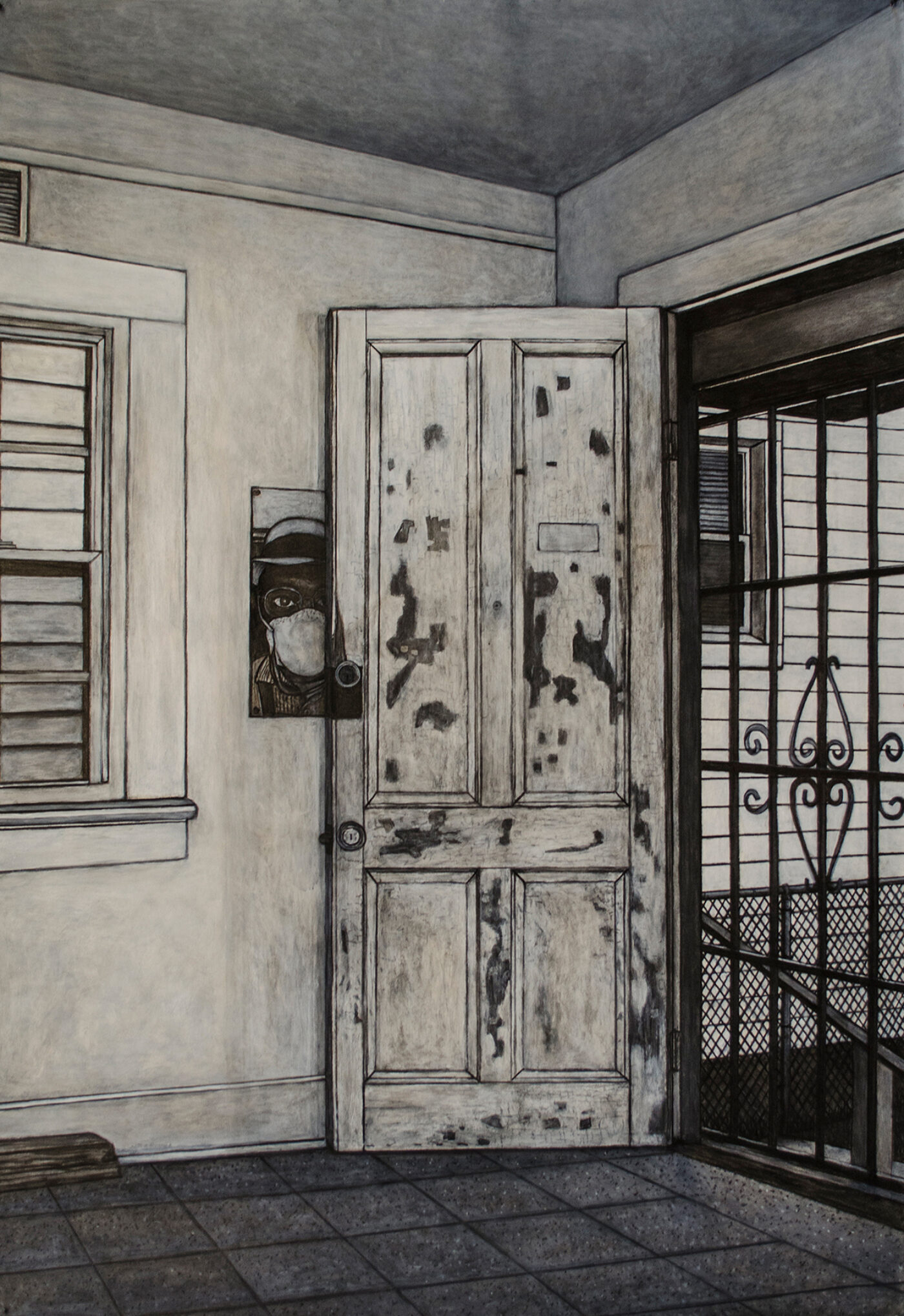
Willie Birch, View Inside Studio with Self Portrait, 2021, charcoal and acrylic on paper, 90 × 60 inches. Courtesy of the artist.
SgI want us to just dive in on your current work. Some black and white that you recently completed—
WBI got about twenty of ’em here. I’m trying to get thirty. Y’all bugging me now.
SgWalk me through your process, if there is a process to be shared; you’re trying to get thirty completed.
WBYeah. Before I have a big show. The way my life is, anything could happen, but I’m slated to have a major retrospective at New Orleans Museum of Art in 2025.
SgWow, congratulations.
WBYeah. As I learned from the artist, Benny Andrews, when I was up in New York, it comes fast. So, we’re working at that. That’s why, when we had all these different distractions, it was driving me crazy because I’m trying to schedule all of this stuff and trying to meet the curator. And I didn’t want the traditional curator. Matter of fact, NOMA had offered me a show a couple of years ago and I turned them down because I didn’t believe the curator had enough grasp of my work.
SgYou took a stand about the curator you wanted.
WBI don’t want to embarrass her. But I told her, You don’t have enough knowledge in what I’m doing. It’s nothing against you, but we ain’t coming from the same place here. And then last year, Susan Taylor came and I said, “Whoa, man! Okay, we’re ready.” She did the Hale Woodruff Show. That’s a great painter, he’s one of the leading fathers of African American art and his prints, I mean, just incredible. And the work was so consistent. So that’s one of our leading African American artists who has continued to ride under the radar, for whatever reason. There are so many. Archibald Motley, who was from New Orleans and grew up in Chicago, went to Mexico and all that. Just brilliant. Archibald Motley. The story on him was that when the Whitney opened their new building, they put an Archibald Motley in the show that became the star of the whole damn show. You understand me? Then they did a solo exhibit of his work.
The Whitney wrote me a letter when they reopened in the new building. “Congratulations. You are in the online exhibition.” And you look at who was in the online exhibition. I said, “Wow, I have no problem with this. But I just want to say since somebody donated that piece to you, I’d appreciate next time y’all buy a piece directly from my studio or from my gallery.” So, the brother who’s head of the Whitney called me and he said, “Willie, I hear you.” I didn’t know I was talking to the director of the Whitney, [Adam Weinberg]. He said, “Well, we know you’re outspoken.”
SgTrue to your practice.
WBI was true. Hey, man, it’s nice that you want a Willie Birch, but you didn’t want to buy one from my studio? Put some money in my coffer so I could live more comfortably. You got one of your collectors to donate it to you. But the reality was that you put it in that show. I’ve been doing that for years. I mean, I don’t know how many people here in New Orleans know that my two murals are the ones in the Harlem 135 Street subway station below the Schomburg. But the people who know, know. Yesterday, Dan Cameron called. He was the curator who founded and created the first Prospect New Orleans that opened in 2008. He said, “Golly, Willie. Everybody knows you but nobody wants to write about you.” I said, “Dan, the way I see it, my life, to a certain degree, is like Van Gogh’s, Rembrandt’s, and Vermeer’s during their lifetimes.” Those are three of my favorite European artists. I said, “They all died poor. But today, you can’t talk to anybody who don’t know who Vermeer is. Rembrandt. And you sure can’t talk to nobody who don’t know who Van Gogh is.” Because they were doing art outside the box and the figures that they were depicting were everyday people. I said, “So we need to put things in context. The fact that, as an African American, I’ve gotten the play that I have, it’s okay.” At this point, I’m going to survive this. I live in my own community. It’s not like I got to reach the expectations of whoever is in New York. I’m not competing against all of those brothers and sisters. I’m competing against Willie Birch. Dan said, “Wow.” I said, “Yes. you don’t have to worry about me going crazy. If you think it’s that important, then you go out there and create an article because you do know Willie Birch’s work. And when you put him in that Prospect, you knew exactly what you were gettin’.” That’s another brilliant mind who understands the milieu. He just happens to be white.
SgYou’ve been in Prospect—
WB—twice. I was one of the first artists to be invited back to a second one in 2021. The first one, wow, got PBS and all that stuff. The place of your birth is usually the last place that deals with you. I was on Esplanade Street and this brother—I’m not going to call his name out because you’ll know who I’m talking about—he came up and said, “You the creator.” I said, “What?” “We call you the creator.” And I said, “Thank you, brother. You don’t have to call me Mr. Birch, if you want to call me the creator . . .”
SgYou once mentioned an African American story about the quilts.
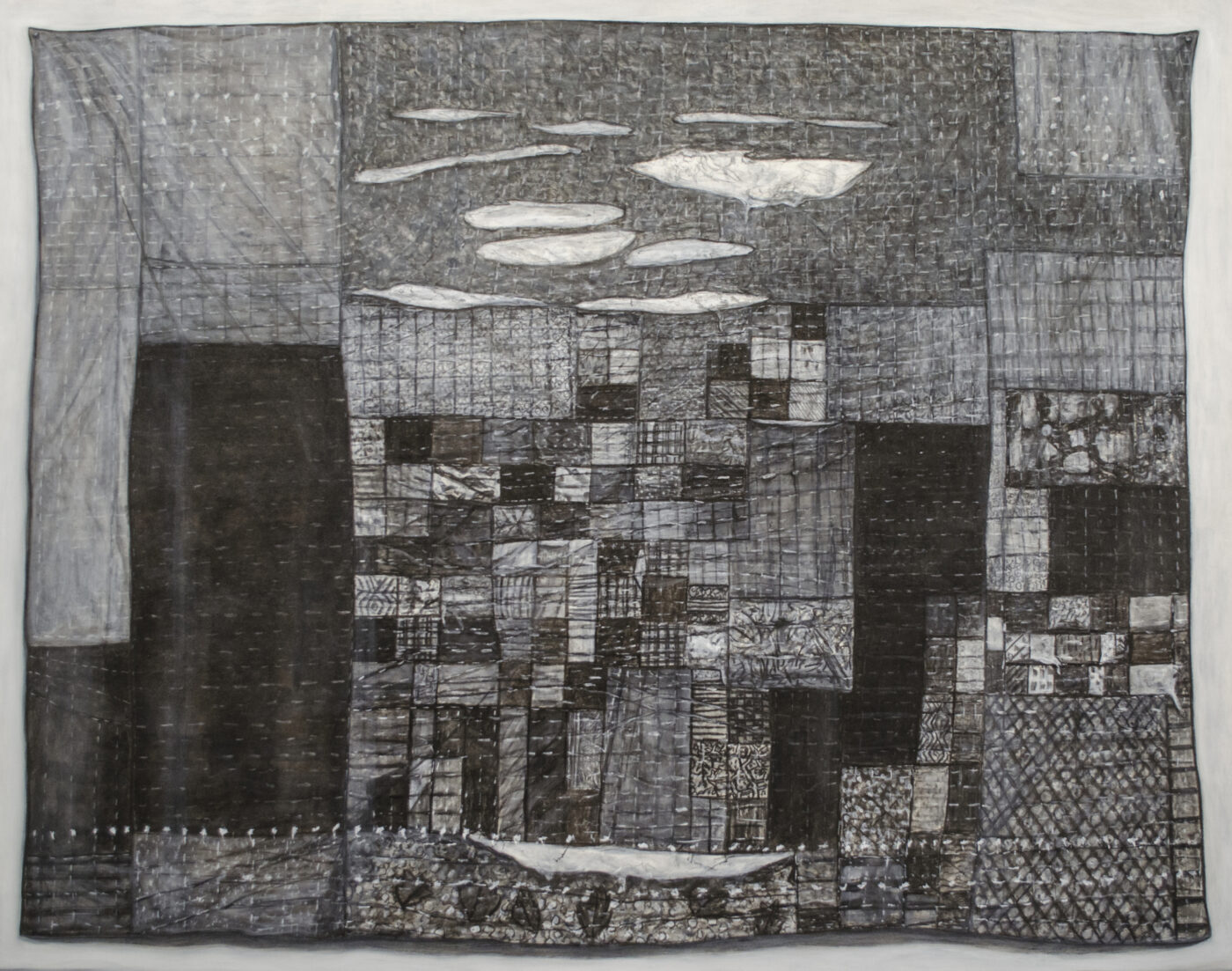
Willie Birch, An African American Story (Tattered Quilt), 2022, charcoal and acrylic on paper, 72 × 87 inches. Courtesy of the artist.
WBTattered Quilt Stories, Yes. It’s torn. It’s old. But—
SgHow recent is that?
WBI probably started in 2020. It takes a while to do these pieces because of the technique I’ve developed by using charcoal and acrylic. Glazing it on or pouring it on and rubbing but also using a brush. It’s very complex; you take what’s given in terms of how to make a piece through a Eurocentric understanding, and you re-design it so that you play. I don’t know how true it will be as I get older, but when you start trying to make a Willie Birch, you’re in serious trouble. It’s because of the way the light comes through the work; being surrounded by water, New Orleans’ light is very different than any place that I’ve ever been. The light that I can make come through the work is because of those transparent glazes of either charcoal or acrylic that allow whatever is underneath to come forward in terms of light. The charcoal is blue and it’s crystallized. Ron and I laugh because I equate that to Spirit Shoppers. Now where did I get that? Reading Robert Farris Thompson—how we use mirrors, how we do art. I mean, the juju is all there. I had no knowledge of that until my buddy [came] and said, “Man, look how them things sparkle.” I said, “Damn, [….]. Now how can I take advantage of it?” Because once you know something, then you can work things.
SgYou slipped in a name. And I want to make sure for the folks who are going to be transcribing.
WBRobert Farris Thompson. He was at Yale. He wrote the book, Flashes of the Spirit. I was teaching at Bowie State College and two colleagues of mine, Simmie Knox and David Stephens—Simmie is the brother who did the portrait of Clinton—we were instructors at Bowie State College. They were associated with the Washington, DC Color School [abstract art that emphasized the form-making capabilities of pure color]. They’d be passing books—it was this three-way exchange—and they would say, Read this, read that. One day, David Stephens said, “Have you heard of this book?” It was Flash of the Spirit, and I took this tattered copy home and I couldn’t put it down. Because it gets to New Orleans. It gets to Louisiana. The first thing you see is that diamond shape. That Congo shape. And you go, Whoooooaaaa! Crossroads of life. The color blue. And then you start going, Man, I’ve seen this before. The St. Louis Cathedral. You mean to say these brothers knew exactly what they were doing? And then the iron work in terms of the Yoruba symbols that are all based in that.
Then I met the legendary black artist David Driscoll, who just died a couple of years ago. He visited me in New Orleans. I called him Mr. Driscoll. He said, “Willie, I see why you moved back here.” I had this studio on Villere Street and we went in my backyard where he was finding herbs and stuff. I did this piece for him called The Warrior Suit. We’ve shown it quite a few times. I’m fortunate enough to have these kinds of people in my life at one point or another. They’ve taught me so much. I approach things as if everybody is smarter than me or other people know things that I don’t. And that’s where the exchange takes place. That means I’m always open to embrace. But I’m also combative. A curator once said, Now I don’t know what to do with you. But then last year, he bought a piece for his museum. It ain’t about liking. It’s about: Does the work fit into how you feel when you don’t have a Willie Birch?
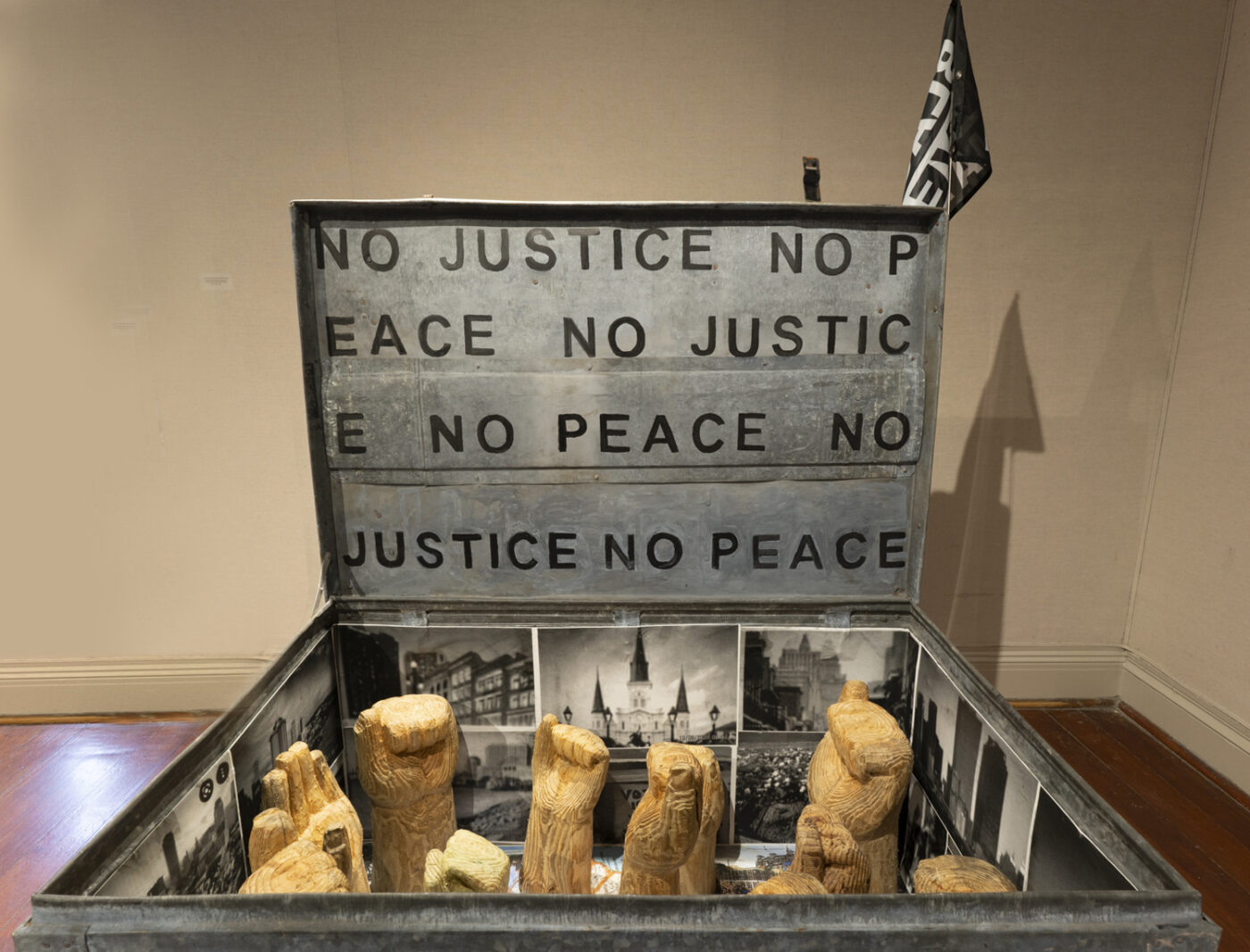
Installation view of Willie Birch, No Justice, No Peace, 2021, found materials. Courtesy of the artist.
SgSo, I have two more questions, and then we’re wrapping it up. You identify several women in your life who have been very instrumental.
WBMaxine Joyce Birch Williams. That’s my sister. That’s the one who just died.
SgElizabeth.
WBYeah. Miss Catlett.
SGMarilyn Nance.
WBNo, I knew Marilyn Nance. Because we were in New York together. And she was best friends with Dawoud [Bey]. We all hung together. Marilyn had come to New Orleans. And that’s how I got on the panel in Virginia with Chandra. bell hooks was on that, too. And Chandra and I had started talking then. I knew Marilyn in New York. But she understood New Orleans, Mardi Gras Indians, African retention, Yoruba. She’s married to a what I call an Afro Puerto Rican brother. He is a filmmaker. So, all of them, they know Yoruba. And if you go to Puerto Rico, you begin to understand the connection between Puerto Rico and New Orleans. It’s all the same people. That’s why in New York, I became friends with Dominicans and Haitians and Cubanos and Puerto Ricans because New Orleans is located close to the Caribbean. I had more in common with those people. I don’t know whether Marilyn’s ancestors come from the islands, but I know that she was an incredible human being. She was one of the first photographers to be Artist-in-Residence at the Studio Museum. Now how much play she gets? I don’t know. I just know that she’s the one who introduced me to Chandra McCormick. I call Chandra little sister. Once little sister and I bonded—
SgThat was it. Oretha, Marilyn, Elizabeth, Miss Daniels, Miss Williams. Your grandmother,
Kitty Poindexter, and your mother, Anna Poindexter. Given those women, who are some of your black woman artist contemporaries, whether y’all work collaboratively or not?
WBI’ve been influenced by more writers than I have visual artists. My youngest daughter’s mother was a librarian and a poet. Esther Louise turned me on to Toni Morrison. I tell people about the time I met Toni Morrison at a party given by Quincy Troupe who I’ve been knowing since we were 17-years-old cause he went to Grambling State and I went to Southern. There are Caribbean writers, male and female . . . I’m like this sponge and people seem to gravitate to me and we connect, and then we go our own ways as you get older. Sonia Sanchez. I’d done these two prints at Brandywine workshop. Next thing I know, I get this call saying, “Sonia Sanchez wanted to give a gift and she chose your two prints.” Sonia comes to New Orleans and does an artist residency at Xavier. She called and said, “Brother Birch, I’ve been waitin’ to meet you.” We figured out we both don’t eat meat and then we just hit it off. Of course, Sonia and my core values are in sync.
SgWe didn’t talk much about the garden. It’s up to you.
WBThe garden is an extension of the overall project and how to come into this community and find a way of connecting and getting them to understand some of the stuff I feel that I’ve been privileged to understand. So, we came up with the garden and I filed for a grant and I got half of it, which was a big problem, somewhat. But we got it, and we started the garden five years ago. And it has continued to grow. We worked in it this weekend. It started with the mounds. And of course, that was initially totally rejected. They asked me: What do those damn things mean? And I’d say, “No, what does it mean to you? Stretch your imagination.” And somebody said, “Well, it could be clouds. It could be mountains.” And I’d say, “That’s it.” There’re no wrong answers. And that’s when they said, “You something. You’re putting some stuff on us.”
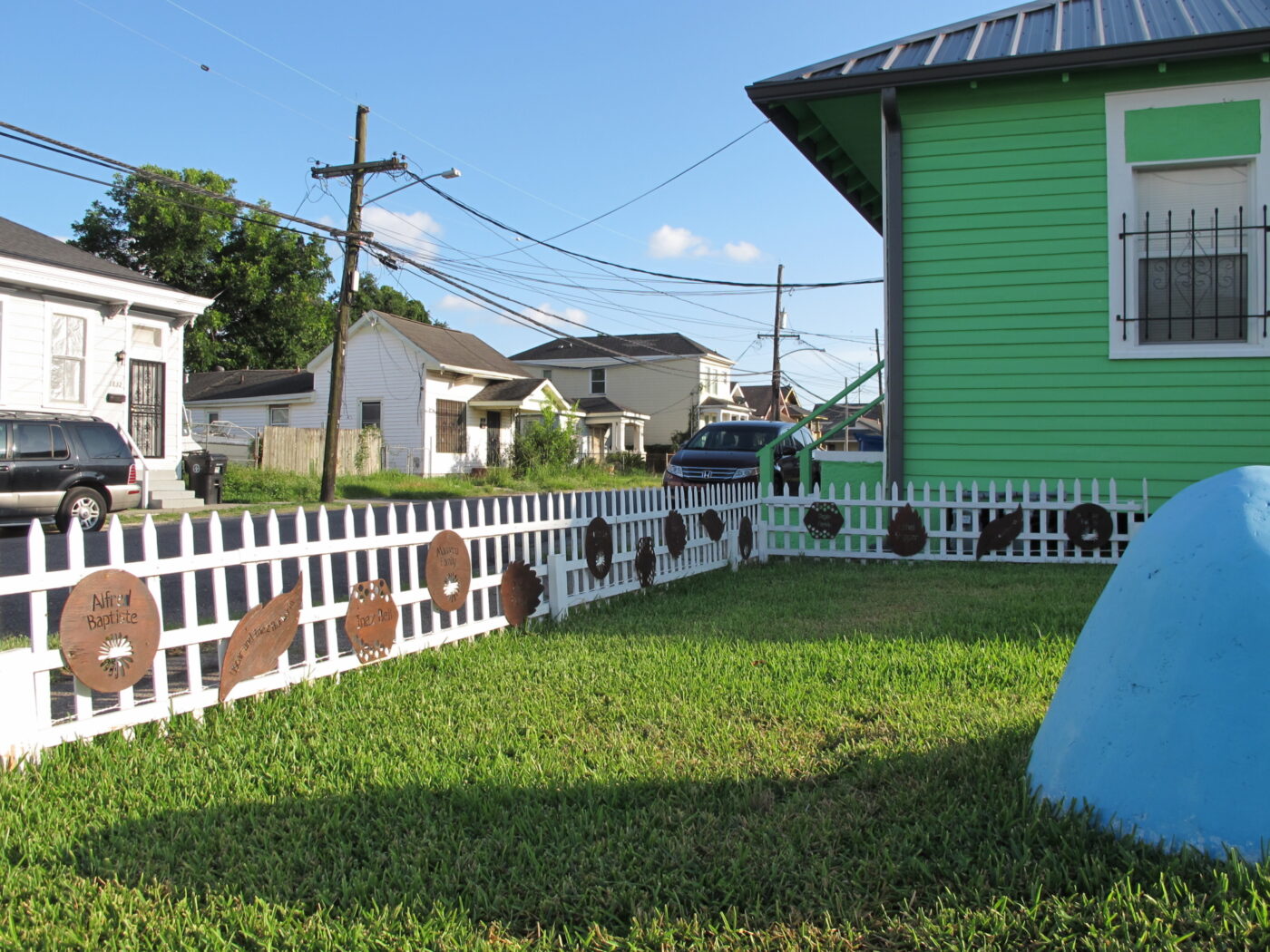
View of Jennifer Odem, Blue Mounds and Robin Levy, Neighborhood Family Plaques at the Old Prieur Community Garden, 2016 to present. Courtesy of Willie Birch.
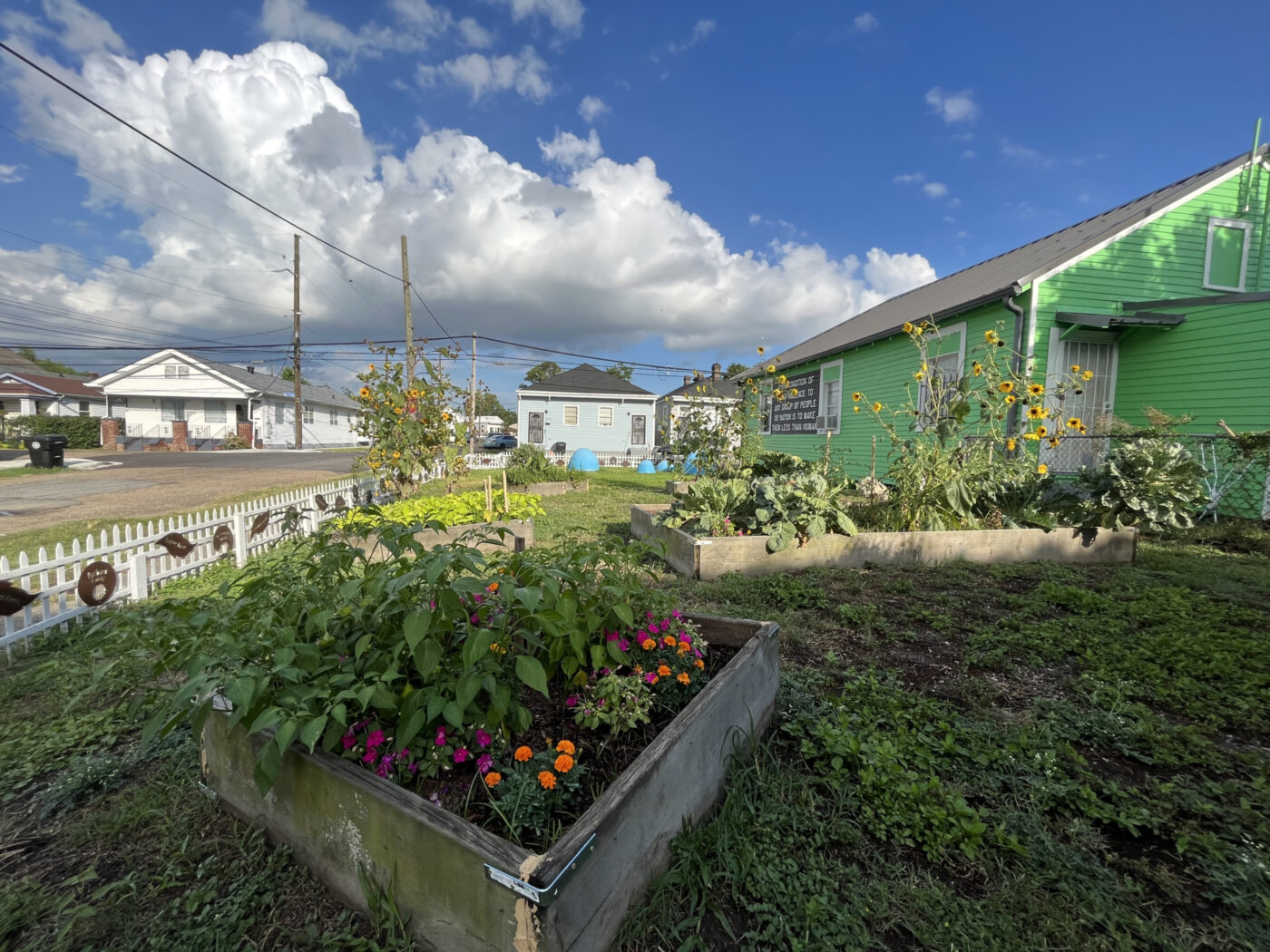
In 2015, Willie Birch. View of the Old Prieur Community Garden, 2016 to present. Courtesy of the artist.
SgOkay. What’s the full name of the garden project?
WBThe project is called The Old Prieur Street Project: Using Art as a Tool in the Transformation of a Community. That became the centerpiece. Robin Levy and Ron [Bechet], a group of local artists, friends, curators, filmmakers developed the project for the community to share their history of individuals and family members.
About thirty people grew up [in the four shotgun houses that are alongside two empty lots and comprise the grounds of the project]. We found the people who used to live in these houses. They were built over a hundred years ago. Recording that history, getting them to tell their stories, was powerful. So, the next part of this project is to make a film, Hope to Told Ya.
SgHope to Told Ya?
WBYeah. We didn’t get money for it to take it to the next level. But it’s in the can. It’s still going on. We built the white picket fence and somebody said, “You’re doing what white people do.” And then they see we got an entrance and an exit, and now you got kids playing with it and we got them to not graffiti it. And then we got my Croatian friend, the artist Rajko Radovanovic, to create a text mural on the site expressing what it means to be human. We’ll see where it goes. In the yard, I’m playing with junk. But that’s no longer junk because one young brother passed by and he say, “Mr. Willie,” he said, “once I looked at this, it became very different.” In the center is this piece called For Children Who Are Victims of Violence, and you can make an altar. They had the plastic bottles. They glitter because it’s like water. So just stretching our imagination—we basically are a very conservative people here. It takes us a while to buy anything new because we got our own thing. Now I’m forcing that. For the Tricentennial at the 300 years NOMA show (2018), we got four people from this community to be on a panel, talking about what this all meant to them. The museum paid them and fed them and brought them back. Well, that’s PR. It’s a project that opens up the possibility of what this little piece of land can do. And I own it.
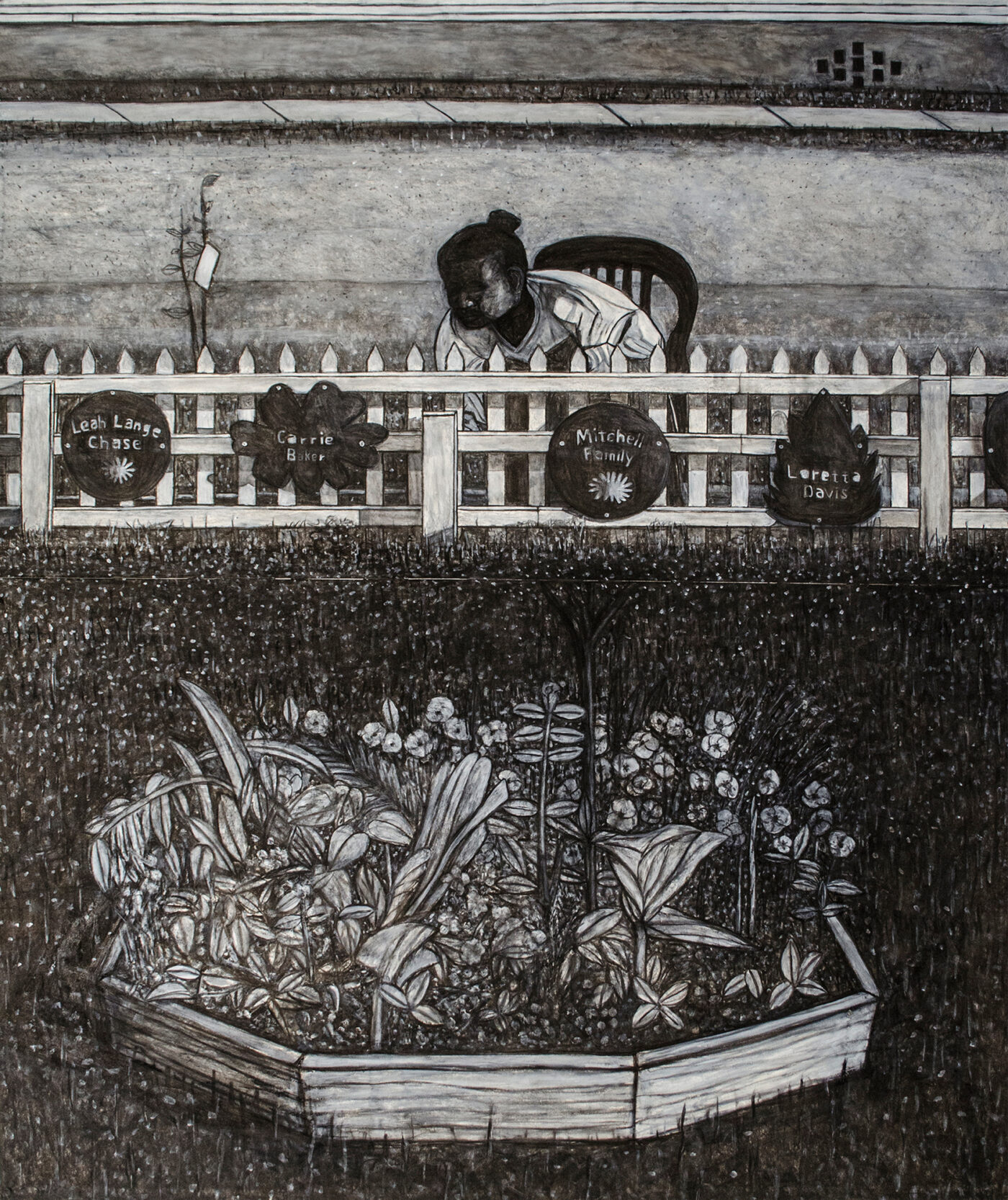
Willie Birch, Mary Painting the White Picket Fence, 2022, charcoal and acrylic on paper, 72 × 91 inches. Courtesy of the artist.
I pay my taxes every year and I own it and therefore, I can control it. That’s something my grandmother taught me. If you can’t control it, you’re in trouble. I was taught as a young child to make sure that I own my own labor. Those are things that I treasure; my Big Mom said, Willie, if, if you don’t own it, you can’t control it and somebody’s going to come and take it from you, particularly if it starts becoming something. I’ve always owned property. I own property in Baltimore. I owned property in New York where everybody thought I was out of my mind. Then I got the Guggenheim grant. Bought that and then I sold the property in New York and bought this. It’s still a continuous thing.
SgHow should people, if they’re interested in connecting to this project, or donating to it, go about it?
WBWell, I don’t want any donations right now. When I complete my estate planning, I can discuss that. Because when you take donations, usually somebody’s beholding to you for what is on the paper. That’s the flaw with a lot of the projects. When you own it, you’re able to deliver the money out of your pocket, then you can hire Ron. I know what Ron is going to give me. I know what Robin Levey is going to give me. I know Jennifer Odem was going to give her blue mound. I knew what Louise Mouton-Johnson was going to give me and I could give them a small honorarium, just to let them know how important and appreciated they and their time were.
SgAnd made ’em take it.
WBYeah. They didn’t want to—No, no. You’re going to take this. All of those things are part of development because I don’t believe you should work for nothing.
SgIf there is interest, how do you want people to connect?
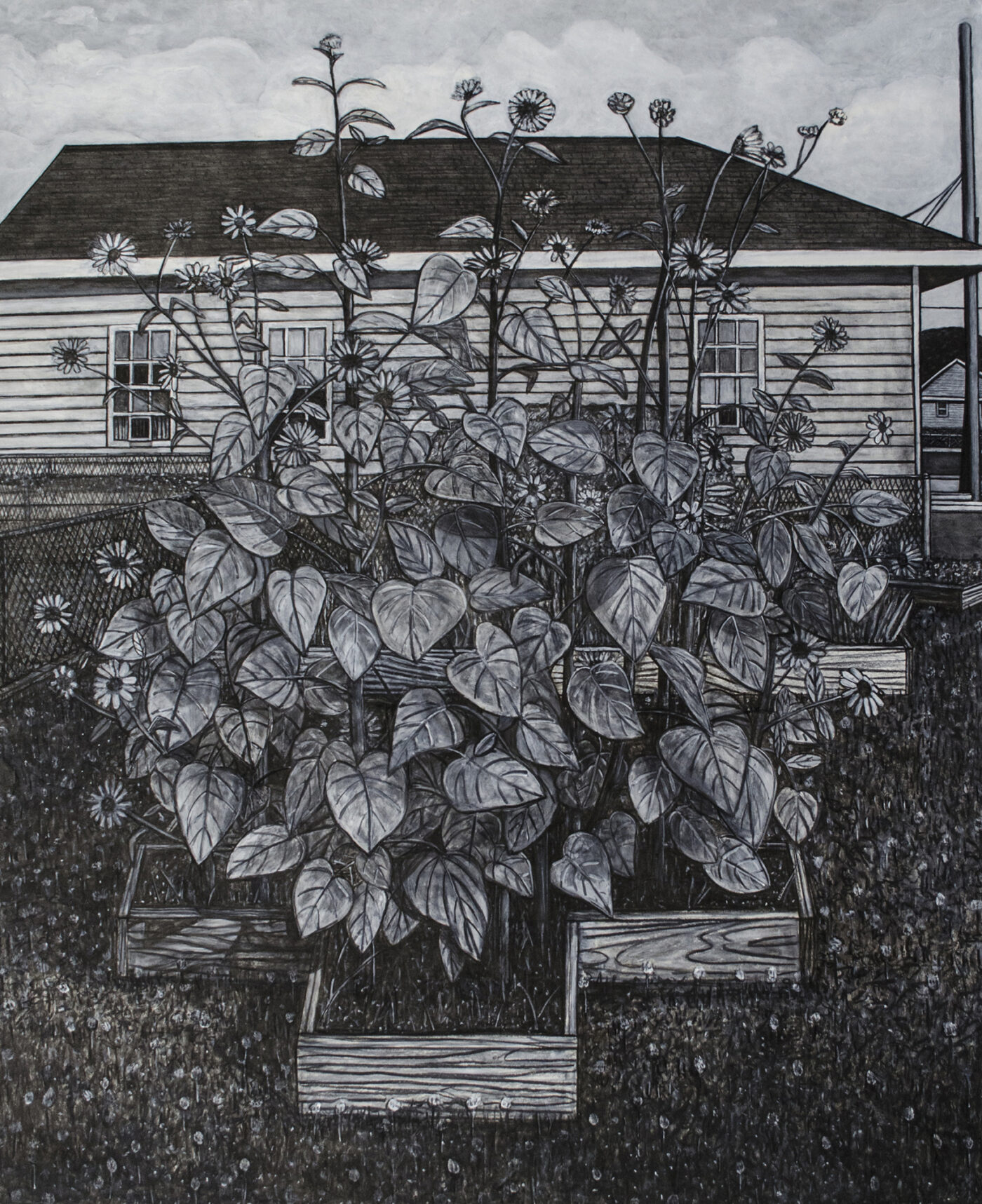
Willie Birch, Sunflowers for Ukraine, 2022, charcoal and acrylic on paper, 90 × 72 inches. Courtesy of the artist.
WBWell, have people come around to see the work we have done at the garden and property. We got the other garden now and there is a relationship between the two. They’re constantly being developed. One thing I love is that we threw down sunflowers two years ago, and now they’re coming up. So, I told Louise, when we were creating this garden, let’s think about this as a painting. And we got these colors, and we just play with it, and whatever happens, and the children are going to come into play, too.
The oldest house is an architecture that you don’t see anymore in New Orleans. That’s why we called it Memory House. That was one of the reasons why I bought the property, and because of the amount of people who’ve lived in that house and can tell you stories of this community. At some point, I offered Sonia Sanchez to come and live in one of these houses for two weeks and write stories about this community. Then we find a way to publish and disseminate that. This can be an incredible project. And we have that young man doing The Black School not too far from here. And then we got the Tulane kids on another street, right over. And we got people coming to the Garden House and building little gardens. Eventually, I want to open up the Memory House so we can show movies, have stage readings. My youngest kid, Freedom, his momma was the stage manager for For Colored Girls [For Colored Girls Who Have Considered Suicide / When the Rainbow is Enuf]. I’ve seen what people take for granted. I was in New York with ’em. I know ’em on a lot of different levels. It’s beginning to happen here. So that’s the changing part of my life, but I don’t have any control over that.
Since 2014, BOMB’s Oral History Project (OHP) has published in-depth, longform interviews with visual artists of the African diaspora. Beginning in 2022, OHP focus cities were expanded from New York to include New Orleans and Chicago. OHP-related public programs are produced in partnership with a range of cultural institutions, including the Studio Museum in Harlem, the Museum of Art and Design, and the Brooklyn Museum.
“An Oral History with Mr. Willie Birch by Ron Bechet, Keith Calhoun, Chandra McCormick, and Shana M. griffin” and the Oral History Project’s expansion to New Orleans and Chicago are made possible by a grant from The Andrew W. Mellon Foundation. Additional support for OHP is provided by Toni L. Ross and public funds from the New York City Department of Cultural Affairs in partnership with the City Council.
An excerpt of this oral history appeared in BOMB Magazine Issue 165 / Fall 2023 (purchase the issue here).
This post was originally published on this site be sure to check out more of their content.






